

INTRODUCTION TO SAILBOAT DESIGN: A TECHNICAL EXPLORATION
Sailboat design is a complex and fascinating field that blends engineering, hydrodynamics, and aesthetics to create vessels that harness the power of the wind for propulsion. In this highly technical article, we will delve into the key aspects of sailboat design, from methodology to evaluation.
1) Design Methodology
Designing a sailboat is a meticulous process that begins with defining the vessel’s purpose and performance goals. It involves understanding the intended use, whether it’s racing, cruising, or a combination of both. Sailboat designers must also consider regulatory requirements and safety standards.
Once the design objectives are established, naval architects employ various computational tools and simulations to create a preliminary design. These tools help in predicting the boat’s performance characteristics and optimizing its geometry.
Design methodology also encompasses market research to understand current trends and customer preferences. This information is critical for creating a sailboat that appeals to potential buyers.
2) Hull Design
The hull is the heart of any sailboat. Its shape determines how the boat interacts with the water. Hull design encompasses the choice of hull form, its dimensions, and the material used. The hull’s shape affects its hydrodynamic performance, stability, and overall handling.
For example, a narrow hull design with a deep V-shape is ideal for speed, while a wider, flatter hull provides stability for cruising. The choice of materials, such as fiberglass or aluminum, impacts the boat’s weight and durability.
The hull design is a balance between achieving efficient hydrodynamics and providing interior space for accommodations. As a designer, finding this equilibrium is a constant challenge.
3) Keel & Rudder Design
The keel and rudder are critical components of a sailboat’s underwater structure. The keel provides stability by preventing the boat from tipping over, while the rudder controls its direction. Keel design involves selecting the keel type (fin, bulb, or wing) and optimizing its shape for maximum hydrodynamic efficiency.
Rudder’s design focuses on ensuring precise control and maneuverability. Both components must be carefully integrated into the hull’s design to maintain balance and performance.
Keel and rudder design can be particularly challenging because they influence the boat’s behavior in different ways. A well-designed keel adds stability but also increases draft, limiting where the boat can sail. Rudder design must account for both responsiveness and the risk of stalling at high speeds.
4) Sail & Rig Design
Sail and rig design play a pivotal role in harnessing wind power. Sail choice, size, and shape are tailored to the boat’s intended use and performance goals. Modern sail materials like carbon fiber offer lightweight and durable options.
The rig design involves selecting the type of mast (single or multiple), rigging configuration, and mast height. These choices influence the sailboat’s stability, maneuverability, and ability to handle varying wind conditions.
Balancing the sails and rig for optimal performance is a meticulous task. The sail plan should be designed to efficiently convert wind energy into forward motion while allowing for easy adjustments to adapt to changing conditions.
5) Balance
Balancing a sailboat is crucial for its performance and safety. Achieving the right balance involves a delicate interplay between the hull, keel, rudder, and sail plan. Proper balance ensures the boat remains stable and responds predictably to helm inputs, even in changing wind conditions.
Balance is not a static concept but something that evolves as the boat sails in different wind and sea conditions. Designers must anticipate how changes in load, wind angle, and sail trim will affect the boat’s balance.
Achieving balance is both an art and a science, and it often requires iterative adjustments during the design and testing phases to achieve optimal results.
6) Propulsion
While sailboats primarily rely on wind propulsion, auxiliary propulsion systems like engines are essential for maneuvering in harbors or during calm conditions. Integrating propulsion systems seamlessly into the boat’s design requires careful consideration of engine placement, fuel storage, and exhaust systems.
The choice of propulsion system, whether it’s a traditional diesel engine or a more eco-friendly electric motor, also impacts the boat’s weight distribution and overall performance.
7) Scantling
Scantling refers to the selection of structural components and their dimensions to ensure the boat’s strength and integrity. It involves determining the appropriate thickness of the hull, deck, and other structural elements to withstand the stresses encountered at sea.
Scantling is a critical aspect of sailboat design, as it directly relates to safety. A well-designed boat must be able to withstand the forces exerted on it by waves, wind, and other environmental factors.
8) Stability
Stability is a critical safety factor in sailboat design. Both upright hydrostatics and large-angle stability must be carefully assessed and optimized. This involves evaluating the boat’s center of gravity, ballast, and hull shape.
Achieving the right balance between initial stability, which provides comfort to passengers, and ultimate stability, which ensures safety in adverse conditions, is a delicate task. Designers often use stability curves and computer simulations to fine-tune these characteristics.
9) Layout
The layout of a sailboat’s interior and deck spaces is a blend of functionality and comfort. Designers must consider the ergonomics of living and working aboard the vessel, including cabin layout, galley design, and storage solutions. The deck layout influences crew movements and sail handling.
Layout design also extends to considerations like ventilation, lighting, and noise control. Sailboats are unique in that they must provide both comfortable living spaces and efficient workspaces for handling sails and navigation.
10) Design Evaluation
The final phase of sailboat design involves rigorous evaluation and testing. Computational fluid dynamics (CFD) simulations, tank testing, and real-world sea trials help validate the design’s performance predictions. Any necessary adjustments are made to fine-tune the vessel’s behavior on the water.
The evaluation phase is where the theoretical aspects of design meet the practical realities of the sea. It’s a crucial step in ensuring that the sailboat not only meets but exceeds its performance and safety expectations.
Conclusion:
In conclusion, sailboat design is a highly technical field that requires a deep understanding of hydrodynamics, engineering principles, and materials science. Naval architects and yacht designers meticulously navigate through the intricacies of hull design, keel and rudder configuration, sail and rig design, balance, propulsion, scantling, stability, layout, and design evaluation to create vessels that excel in both form and function. The harmonious integration of these elements results in sailboats that are not just seaworthy but also a joy to sail, and this process is a testament to the art and science of sailboat design.
Click here to read about “ HARNESSING THE POWER OF ARTIFICIAL INTELLIGENCE IN BOAT DESIGN “
Follow my Linkedin Newsletter here: “LinkedIn Newsletter”
0 comments Leave a reply
Save my name, email, and website in this browser for the next time I comment.
Recent Posts
- KEY LESSONS I LEARNED FROM MY FREELANCE JOURNEY IN 2023
- THE FREELANCE ECONOMY: KEY TRENDS AND PREDICTIONS FOR 2024
- THE RISE Of HDPE IN BOAT MANUFACTURING: TRENDS & BENEFITS
- THE CRITICAL ROLE OF FEASIBILITY STUDY IN BOAT DESIGN AND NAVAL ARCHITECTURE
- THE CHALLENGES Of SMALL CRAFT DESIGN COMPARED TO LARGER VESSELS
Recent Comments
- Casey Lim on HDPE BOAT PLANS
- BRYN BONGBONG on HDPE BOAT PLANS
- Keith on HDPE BOAT PLANS
- Daniel Desauriers on WHY HDPE BOATS?
- December 2023
- November 2023
- October 2023
- February 2023
- January 2023
- September 2022
- January 2021
- ARTIFICIAL INTELLIGENCE
- boatbuilder
- BOAT CONSTRUCTION TECHNIQUES
- BOAT DESIGN COST
- boatdesign process
- CAREER PATHWAYS
- COMMERCIAL BOATS
- conventional boats
- custom boat
- DESIGN ADMINISTRATION
- DESIGN SPIRAL
- EXTREME CONDITIONS
- FEASIBILITY STUDY
- Freelance advantage
- freelance boat designer
- FREELANCE ECONOMY
- FREELANCE JOURNEY
- FRP Boat without Mold
- HDPE Collar
- INDIA'S MARITIME
- INVENTORY MANAGEMENT
- ISO STANDARDS
- Mass Production
- Monhull vs Catamaran
- Naval Architect
- Naval Architecture
- PLANING HULL
- Project Management
- Proven Hull
- PSYCHOLOGY OF BOAT DESIGN
- QUALITY CONTROL
- RECREATIONAL BOATS
- RISE OF HDPE
- ROYALTY AGREEMENTS
- SANDWICH VS SINGLE SKIN
- SOLOPRENEUR
- YACHT DESIGN COURSE
Sailboat Retrospective
You know the term ‘smooth sailing’? Imagine you could apply it to all of your current projects and future sprints. Using the Sailboat Retrospective technique can help you achieve team cohesiveness using a fun, visual exercise that gets all of your team members on the same page — or should we say— boat.
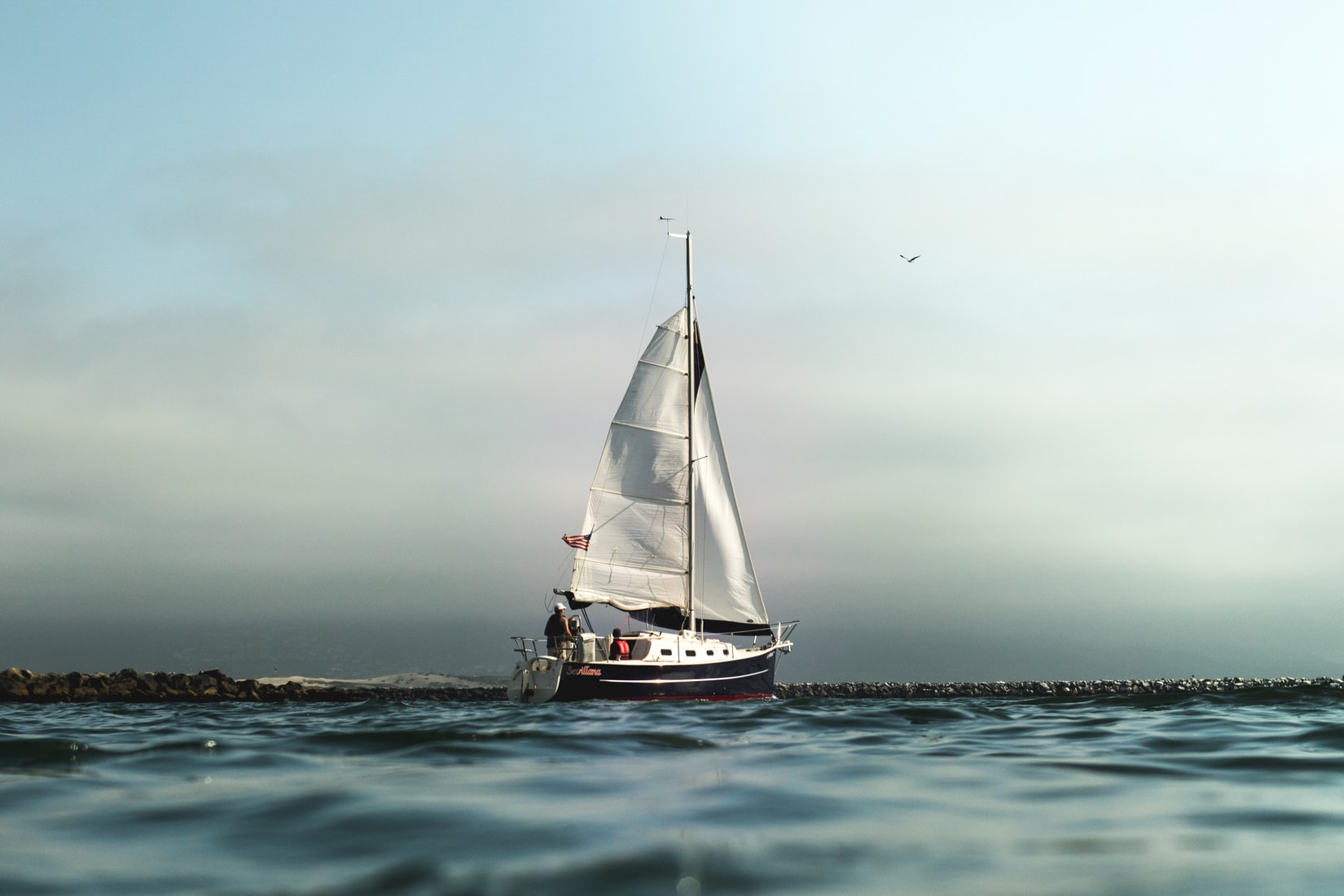
What exactly is a Sailboat Retrospective?
The Sailboat technique for retrospectives is a fun, interactive, and low-key way for your team to reflect on a project. It helps team members to identify what went right, what went wrong, and what improvements and changes can be made in the future. Usually the retrospective happens immediately after the completion of a project or sprint.
This technique uses the metaphor of a sailboat heading toward shore to help teams visualize their ship (team) reaching its ultimate destination (or ultimate goals).
Let’s look at a quick breakdown of the pieces involved:
Anatomy of the Sailboat Retrospective
In a Sailboat exercise, there are traditionally five main components:
- The sailboat: The team itself (or some teams prefer to make this the project)
- The island or shore: The ultimate goal or vision for the team (where it’s headed)
- The wind (or the sails): Things that are helping the team glide along (team strengths, competitive advantages of your product, good communication, etc.)
- The anchors: things that are slowing the team or project down or delaying progress (silos, areas of weakness, etc.)
- The rocks: the risks or potential pitfalls of a project (areas of tension, bottlenecks, competition, etc.)
Some Sailboat Retrospectives incorporate other aspects that fit into their vision such as the sun, which represents things that make the team feel happy or satisfied; or, choppy waves to represent something the team feels anxious about.
Some teams even scale their sails for bigger vs. smaller problems. If you have quite a few people involved in your retrospective or you have a lot of issues and need a way to prioritize, this is an option.
Feel free to get creative and add any aspects you feel would be beneficial to your retrospective. (This can be easily done via our Sailboat Retrospective template by adding additional columns. See below.)
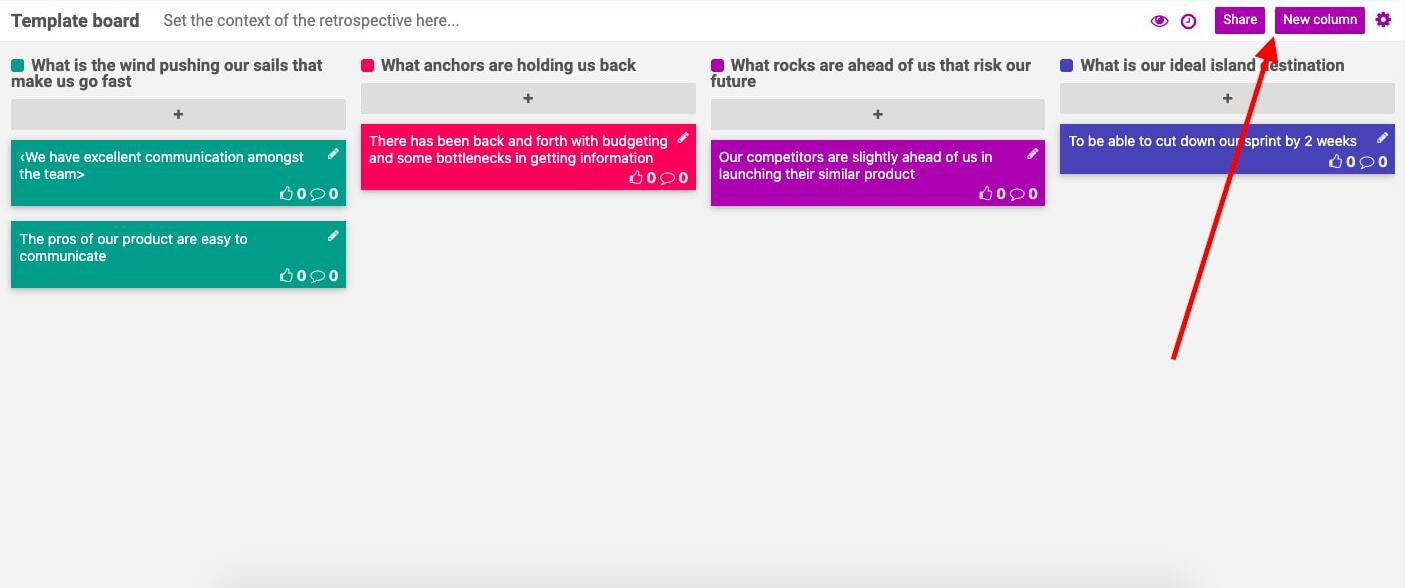
Why is the Sailboat Retrospective technique so effective?
The effectiveness of the Sailboat Exercise lies in its ability to use relatable metaphors to help team members easily identify important strengths and weaknesses. Because it is more of a non-pressure approach, it can help team members feel relaxed and more open to communicate without overthinking things.
This exercise is a fun way to get your team out of their day-to-day and think about the ‘big-picture’ to continually improve processes. It can also be a nice way of mixing up your retrospectives to keep them fresh and engaging.
And just because it’s fun doesn’t mean it’s not effective! The average Sailboat Retrospective normally helps to identify around 3-5 action items . That’s 3-5 new ways that your team can enhance their performance!

How to run one with your team
Ready to try your own Sailboat method retrospective?
Note: This exercise should take around 60 to 90 minutes to complete.
1. First, gather your key stakeholders
Usually, a retrospective includes the Scrum Master, Product Owner and members of the Scrum team. If there are other key stakeholders for your specific project invite them to the retrospective as well. This specific type of exercise really benefits from having different opinions and perspectives.
If your team is distributed or remote (as many are these days) you can still perform the Sailboat Exercise. Consider using a great online tool designed specifically to help distributed teams facilitate retrospectives.
2. Set some ground rules
It’s important to set the tone for how you envision your retrospective going. There are a few things that should never be included in any retrospective, and the Sailboat method is no exception. Keep your retrospective free of:
And make sure the focus is on:
- Having a growth mindset
- Being optimistic
- Being open-minded and open to constructive criticisms
- Being a psychologically-safe environment
3. Sketch your Visual
The rough sketch below is a pretty standard depiction for this type of retrospective. If you don’t want to draw your own, a simple Google search of sample Sailboat Retrospective images can help you find more examples.
Your visual should include all of the elements you’ll be discussing in order to help facilitate the exercise.
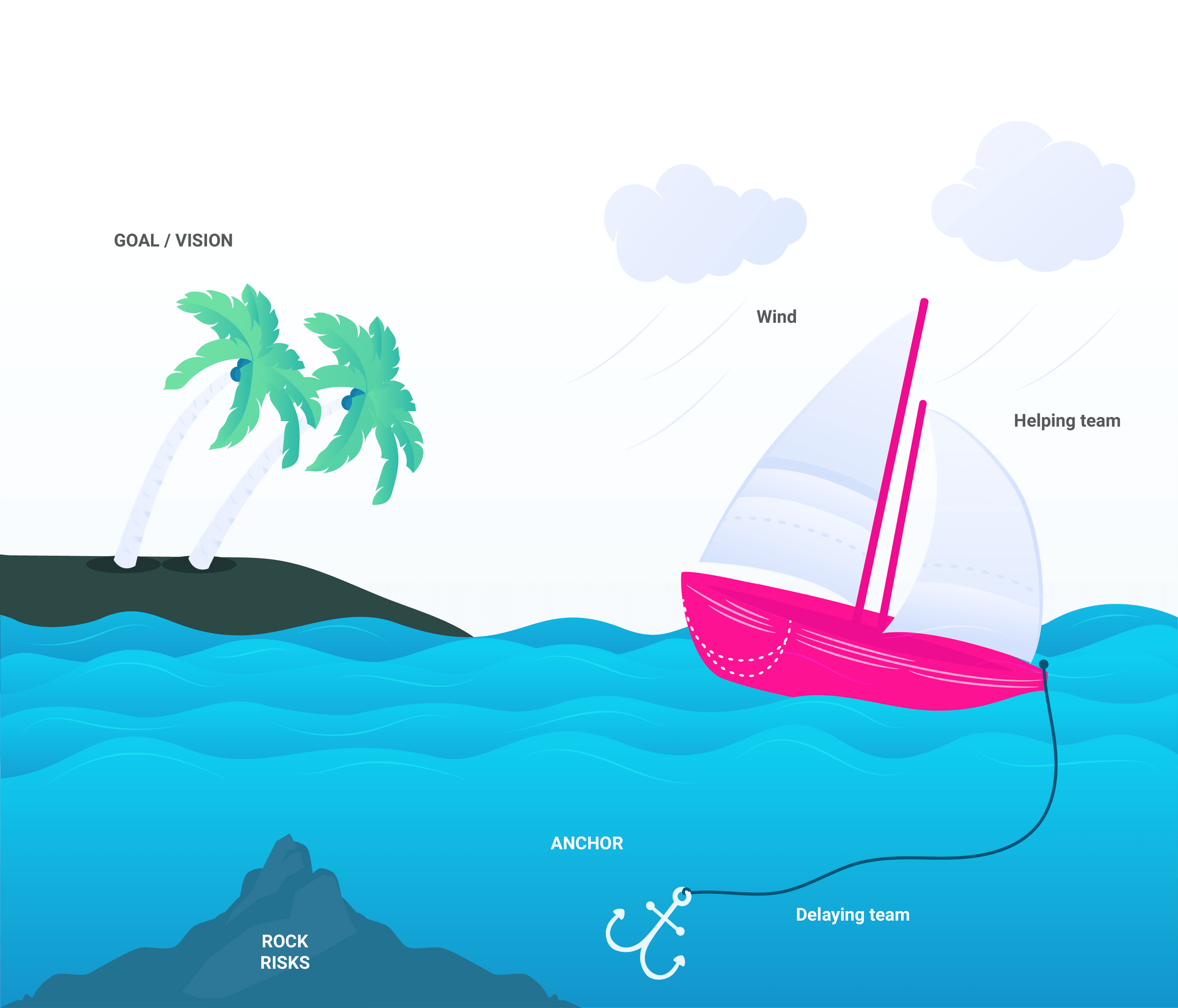
4. Set up your Template
Next, you’ll want to set up the template you’ll be using to capture your team’s thoughts. You can use a white board and post-its for this, but we’d suggest using an easy-to-build online template ( like this one ) to keep things organized.
Add all of the categories you will be discussing to your template. Then, take a few minutes to explain in detail what each category represents.
5. Brainstorming and/or discussion
Once your categories are all laid out on your template, you can either ask your team to quietly brainstorm for each one, or you can hold a group discussion. Really, this depends on the communication style of your team.
If you feel it might be better to have team members submit their feedback anonymously, they can write out their notations on post-its and you can gather them before discussion. Once you have everyone’s thoughts and additions, add them to your template.
This is the final phase of the retrospective. At this point, you and your team should identify what the biggest successes of your project were and what attributes you’d like to carry forward.
Discuss your anchors (obstacles) and brainstorm ways to overcome them. Also discuss ways to mitigate your potential risks (rocks) and how close or far you are from reaching your ultimate goals.
Once everyone is on the same page, conclude your retrospective and move forward with a plan and improved understanding of team performance!
That’s all there is to it! We hope your team enjoys this retrospective and gains some valuable insights along the way.
Happy sailing!
- Types of Sailboats
- Parts of a Sailboat
- Cruising Boats
- Small Sailboats
- Design Basics
- Sailboats under 30'
- Sailboats 30'-35
- Sailboats 35'-40'
- Sailboats 40'-45'
- Sailboats 45'-50'
- Sailboats 50'-55'
- Sailboats over 55'
- Masts & Spars
- Knots, Bends & Hitches
- The 12v Energy Equation
- Electronics & Instrumentation
- Build Your Own Boat
- Buying a Used Boat
- Choosing Accessories
- Living on a Boat
- Cruising Offshore
- Sailing in the Caribbean
- Anchoring Skills
- Sailing Authors & Their Writings
- Mary's Journal
- Nautical Terms
- Cruising Sailboats for Sale
- List your Boat for Sale Here!
- Used Sailing Equipment for Sale
- Sell Your Unwanted Gear
- Sailing eBooks: Download them here!
- Your Sailboats
- Your Sailing Stories
- Your Fishing Stories
- Advertising
- What's New?
- Chartering a Sailboat
Sailboat Design: Stability, Buoyancy and Performance
Simply stated, the first requirement of sailboat design is that the yacht designer's creation is seaworthy; particularly in that it stays afloat and is highly resistant to capsize - but of course we expect rather more than that...
Good sailing performance, particularly to windward, will be high on the list of most sailors' requirements. As will the availability of sufficient space below decks to accommodate the crew and the stores, and all the other sailing paraphernalia.
And the boat must be easy to handle, both under sail at sea and under power in the marina. It must be comfortable, for it's not always just a sailing machine - at times it has to function as a home too.
So a design that successfully incorporates all these requirements won't just happen by accident - but however accomplished your yacht designer, you'll not be able to have everything...
We sailors recognise the stability element of sailboat design as the difference between a 'stiff' boat and a 'tender' one. And whether it's one or the other depends on the relationship between the righting moment applied by the hull and the heeling moment applied by the wind-loaded sails.
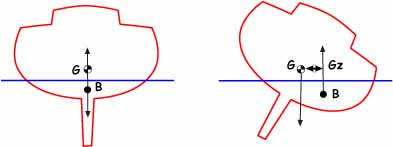
As can be seen in the sketch, the righting moment (Gz) is the horizontal distance between the boat's Centre of Gravity (G) and its Centre of Buoyancy (B).
The righting moment increases as the boat heels until a point is reached at which the heeling moment becomes equal to the righting moment, following which any further increase in heeling moment will cause the boat to capsize.
This is best expressed graphically by way of a Gz Curve, which plots Righting Moment against Heel Angle.
This curve establishes the Angle of Vanishing Stability , effectively the point of no return for a sailboat about to capsize, and which is a major factor in allocating any sailboat to one of the four recognised sailboat design categories - Ocean, Offshore, Inland and Sheltered Waters .
If you're planning to buy or charter a sailboat, you should always check its Design Category to make sure that it's suitable for your purposes.
Displacement, Freeboard and the Centre of Gravity
Heavy displacement boats sit lower in the water than light displacement craft, so their cabin soles are deeper below the water line. Lighter displacement boats with their higher cabin soles have to have greater freeboard to provide their occupants with sufficient headroom.
And freeboard has an impact on stability in that it raises the centre of gravity, thereby reducing the righting moment.
To compensate this, any ballast carried by a light displacement boat should always be as low as possible, ideally in a bulb at the foot of the keel - the lower the centre of gravity the better, as it improves the righting moment by maximising the righting lever Gz.
In our medium-to-light sailboat Alacazam, we have gone one stage further by building in a water ballast system .
Performance
Generally light displacement brings performance benefits due to the higher power to weight ratio and reduced hull drag through having a smaller wetted area.
This is borne out by two important design ratios, the Displacement/Length Ratio and the Sail Area/Displacement Ratio.
Length too has an impact on performance, as can be shown by another sailboat design ratio, the Speed/Length Ratio.
It will also come as no surprise that performance is also influenced by the hull shape below the waterline; a slim arrow-like hull offering less resistance that a squat, dumpy one. But what isn't so widely known is that the ideal shape for hullspeed is not the most efficient shape when sailing at less than hullspeed; which is why sailboat designers ponder long and hard over another sailboat design ratio - the Prismatic Coefficient.
Read more about these and other Design Ratios used by today's Yacht Designers...
Recent Articles
The CSY 44 Mid-Cockpit Sailboat
Sep 15, 24 08:18 AM
Hallberg-Rassy 41 Specs & Key Performance Indicators
Sep 14, 24 03:41 AM
Amel Kirk 36 Sailboat Specs & Key Performance Indicators
Sep 07, 24 03:38 PM
Here's where to:
- Find Used Sailboats for Sale...
- Find Used Sailing Gear for Sale...
- List your Sailboat for Sale...
- List your Used Sailing Gear...
Our eBooks...

A few of our Most Popular Pages...

Copyright © 2024 Dick McClary Sailboat-Cruising.com

- Work With Us
- Project To Product
Run The SailBoat Agile Exercise or Sailboat Retrospective
by Luis Gonçalves on Jun 16, 2024 9:04:15 AM
In this post, I will explain the method known as SailBoat Exercise or Sailboat Retrospective.
This exercise can be found in the book Getting Value out of Agile Retrospectives . A book that I and Ben Linders wrote with a foreword by Esther Derby .
Sailboat Exercise
What you can expect to get out of this technique.
From my experience, this technique is quite appreciated by teams because of its simplicity.
This exercise helps teams to define a vision of where they want to go; it helps them to identify risks during their path and allows them to identify what slows them down and what helps them to achieve their objectives.
When you would use this technique
I believe this method is quite simple and does not require any special occasion. Although, it might be interesting for situations when a retrospective is conducted with more than one team at the same time.
I had a situation, not long time ago that two teams worked together and because of their level of dependency on each other, they decided to conduct a common retrospective because of some ongoing issues.
Using the SailBoat exercise can be extremely interesting because we simply put the name of both teams on the SailBoat and we remind everyone that we are on the same SailBoat navigating in the same direction.
This technique reveals all the good things and less positive things performed by a team.
How to do it
This retrospective is quite simple. First, we draw a SailBoat, rocks, clouds, and a couple of islands like it is shown in the picture on a flip chart.
The islands represent the teams´ goals/vision. They work every day to achieve these islands. The rocks represent the risks they might encounter in their vision.
The anchor on the SailBoat is everything that is slowing them down on their journey. The clouds and the wind represent everything that is helping them to reach their goal.
Having the picture on the wall, write what the team vision is or what our goals are as a team. After that, start a brainstorming session with the team allowing them to dump their ideas within different areas.
Give them ten minutes to write their ideas. Afterward, give 5 minutes to each person to read out loud their ideas.
At this point discuss together with the team how can they continue to practice what was written on the "clouds" area. These are good ideas that help the team, and they need to continue with these ideas.
Then spend some time discussing how can the team mitigate the risks that were identified. Finally, together with the team chose the most important issue that is slowing the team down.
If you do not find an agreement within the team about the most important topic that should be tackled, you can use the vote dots.
In the end, you can define what steps can be done to fix the problem, and you can close the retrospective.
Like many other exercises, this exercise does not require a collocation of a team. You can use, for example, tools like Lino, to apply the exercise to non-collocated teams. This tool allows us to do everything that we need to run this exercise.
What do you think? Your feedback is always extremely important for me, so please leave me your comments.
An Agile Retrospective is an event that ́s held at the end of each iteration in Agile Development and it serves for the team to reflect on how to become more effective, so they can tune and adjusts its behavior accordingly.
I believe the SailBoat exercise is quite a simple Agile Retrospective Exercise and does not require any special occasion.
If you are interested in getting some extra Agile Retrospectives exercises, I created a blog post with dozens of Agile Retrospectives Ideas , check them and see if you find something interesting.
Did you like this article?
We enable leaders to become highly valued and recognized to make an impact on the World by helping them to design Digital Product Companies that will thrive and nourish in the Digital Age, we do this by applying our own ADAPT Methodology® .

- Agile Methodologies (18)
- Product Strategy (18)
- Product Mindset (14)
- Project To Product (10)
- Agile Retrospectives (9)
- Knowledge Sharing (9)
- Time To Market (8)
- Product Discovery (7)
- Continuous Improvement (5)
- Strategy (5)
- Scrum Master (4)
- Content Marketing Strategy (3)
- Product Owner (3)
- Technical Excellency (3)
- Digital Transformation (2)
- Innovation (2)
- Scaling (2)
- Team Building (2)
- Business Model (1)
- Cost Of Delay (1)
- Customer Feedback (1)
- Customer Journey (1)
- Customer Personas (1)
- Design Thinking (1)
- Digital Leadership (1)
- Digital Product Tools (1)
- Go To Market Strategy (1)
- Google Design Sprint (1)
- Lean Budgeting (1)
- Lean Change Management (1)
- Market Solution Fit (1)
- Organisational Impediments (1)
- Outsourcing (1)
- Product (1)
- Product Metrics (1)
- Product Roadmaps (1)
- September 2024 (1)
- August 2024 (1)
- July 2024 (2)
- June 2024 (22)
- May 2024 (8)
- April 2024 (11)
- February 2024 (2)
- January 2024 (152)
- April 2023 (1)
- February 2023 (1)
- July 2021 (1)
- January 2017 (1)

Organisational Mastery
Get your free copy

Product First

- News & Views
- Boats & Gear
- Lunacy Report
- Techniques & Tactics
MODERN SAILBOAT DESIGN: Quantifying Stability
We have previously discussed both form stability and ballast stability as concepts, and these certainly are useful when thinking about sailboat design in the abstract. They are less useful, however, when you are trying to evaluate individual boats that you might be interested in actually buying. Certainly you can look at any given boat, ponder its shape, beam, draft, and ballast, and make an intuitive guess as to how stable it is, but what’s really wanted is a simple reductive factor–similar to the displacement/length ratio , sail-area/displacement ratio , or Brewer comfort ratio –that allows you to effectively compare one boat to another.
Unfortunately, it is impossible to thoroughly analyze the stability of any particular sailboat using commonly published specifications. Indeed, stability is so complex and is influenced by so many factors that even professional yacht designers find it hard to quantify. Until the advent of computers, the calculations involved were so overwhelming that certain aspects of stability were only estimated rather than precisely determined. Even today, with computers doing all the heavy number crunching, stability calculations remain the most tedious part of a naval architect’s job.
There are, however, some tools available that you can use to make a sophisticated appraisal of a boat’s stability characteristics. If you dig and scratch a bit–on the Internet, or by pestering a builder or designer–you should be able to unearth one or more of them.
Stability Curves and Ratios
The most common tool used to assess a boat’s form and ballast stability is a stability curve. This is a graphic representation of a boat’s self-righting ability as it is rotated from right side up to upside down. Stability curves are sometimes published or otherwise made available by designers and builders, but to interpret them correctly, you first need to understand the physics of a heeling sailboat.
When perfectly upright, a boat’s center of gravity (CG)–which is a function of its total weight distribution (i.e., its ballast stability)–and its center of buoyancy (CB)–which is a function of its hull shape (i.e., its form stability)–are vertically aligned on the boat’s centerline. CG presses downward on the boat’s hull while CB presses upward with equal force. The two are in perfect equilibrium, and the boat is motionless. If some force heels the boat, however, CB shifts outboard of CG and the equilibrium is disturbed. The horizontal distance created between CG and CB as the boat heels is called the righting arm (GZ). This is a lever arm, with CG pushing down on one end and CB pushing up on the other, and their combined force, known as the righting moment (RM), works to rotate the hull back to an upright position. The point around which the hull rotates is known as the metacenter (M) and is always directly above CB.
The longer the righting arm (i.e., the larger the value for GZ), the greater the righting moment and the harder the hull tries to swing upright again. Up to a point, as a hull heels more, its righting arm just gets longer. The righting moment, consequently, gets larger and larger. This is initial stability. A wider hull has greater initial stability simply because its greater beam allows CB to move farther away from CG as it heels. Shifting ballast to windward also moves CG farther away from CB, and this too lengthens the righting arm and increases initial stability. The angle of maximum stability (AMS) is the angle at which the righting arm for any given hull is as long as it can be. This is where a hull is trying its hardest to turn upright again and is most resistant to further heeling.
Once a hull is pushed past its AMS, its righting arm gets progressively shorter and its ability to resist further heeling decreases. Now we are moving into the realm of ultimate, or reserve, stability. Eventually, if the hull is pushed over far enough, the righting arm disappears and CG and CB are again vertically aligned. Now, however, the metacenter and CG are in the same place, and the hull is metastable, meanings it is in a state of anti-equilibrium. Its fate hangs in the balance, and the least disturbance will cause it to turn one way or the other. This point of no return is the angle of vanishing stability (AVS). If the hull fails to right itself at this point, it must capsize. Any greater angle of heel will cause CG and CB to separate again, except now the horizontal distance between them will be a capsizing arm, not a righting arm. Gravity and buoyancy will be working together to invert the hull.
Stability at work. The righting arm (GZ) gets longer as the center of gravity (CG) and the center of buoyancy (CB) get farther apart, and the boat works harder to right itself. Past the angle of vanishing stability, however, the righting arm is negative and CG and CB are working to capsize the boat
A stability curve is simply a plot of GZ–including both the positive righting arm and the negative capsizing arm–as it relates to angle of heel from 0 to 180 degrees. Alternatively, RM (that is, both the positive righting moment and the negative capsizing moment) can be the basis of the plot, as it derives directly from GZ. (To find RM in foot-pounds, simply multiply GZ in feet by the boat’s displacement in pounds.) In either case, an S-curve plot is typical, with one hump in positive territory and another hopefully smaller hump (assuming the boat in question is a monohull) in negative territory.
The AMS is the highest point on the positive side of the curve; the AVS is the point at which the curve moves from positive to negative territory. The area under the positive hump represents all the energy that must be expended by wind and waves to capsize the boat; the area under the negative hump is the energy (usually only waves come into play here) required to right the boat again. To put it another way: the larger the positive hump, the more likely a boat is to remain right side up; the smaller the negative hump, the less likely it is to remain upside down.
Righting arm (GZ) stability curve for a typical 35-foot cruising boat. The angle of maximum stability (AMS) in this case is 55 degrees with a maximum GZ of 2.6 feet; the angle of vanishing stability (AVS) is 120 degrees; the minimum GZ is -0.8 feet
The relationship between the sizes of the two humps is known as the stability ratio. If you have a stability curve to work from, there are some simple calculations developed by designer Dave Gerr that allow you to estimate the area under each portion of the curve. To calculate the positive energy area (PEA), simply multiply the AVS by the maximum righting arm and then by 0.63: PEA = AVS x max. GZ x 0.63. To calculate the negative energy area (NEA), first subtract the AVS from 180, then multiply the result by the maximum capsizing arm (i.e., the minimum GZ) and then by 0.66: NEA = (180 – AVS) x min. GZ x 0.66. To find the stability ratio divide the positive area by the negative area.
Working from the curve shown in the graph above for a typical 35-foot cruising boat, we get the following values to plug into our equations: AVS = 120 degrees; max. GZ = 2.6 feet; min. GZ = -0.8 feet. The boat’s PEA therefore is 196.56 degree-feet: 120 x 2.6 x 0.63 = 196.56. Its NE is 31.68 degree-feet: (180 – 120) x -0.8 x 0.66 = 31.68. Its stability ratio is thus 6.2: 196.56 ÷ 31.68 = 6.2. As a general rule, a stability ratio of at least 3 is considered adequate for coastal cruising boats; 4 or greater is considered adequate for a bluewater boat. The boat in our example has a very healthy ratio, though some boats exhibit ratios as high as 10 or greater.
You can run these same equations regardless of whether you are working from a curve keyed to the righting arm or the righting moment. The curve in our example is a GZ curve, but if it were an RM curve, we only have to substitute the values for maximum and minimum RM for maximum and minimum GZ. Otherwise the equations run exactly the same way. The results for positive and negative area, assuming RM is expressed in foot-pounds, will be in degree-foot-pounds rather than degree-feet, but the final ratio will be unaffected.
GZ and RM curves are not, however, interchangeable in all respects. When evaluating just one boat it makes little difference which you use, but when comparing different boats you should always use an RM curve. Because righting moment is a function of both a boat’s displacement and the length of its righting arm, RM is the appropriate standard for comparing boats of different displacements. It is possible for different boats to have the same righting arm at any angle of heel, but they are unlikely to have the same stability characteristics. It always takes more energy to capsize a larger, heavier boat, which is why bigger boats are inherently more stable than smaller ones.
Righting moment (RM) stability curves for a 19,200-pound boat and a 28,900-pound boat with identical GZ values. Because heavier boats are inherently more stable, RM is the standard to use when comparing different boats (Data courtesy of Dave Gerr)
Another thing to bear in mind when comparing boats is that not all stability curves are created equal. There are various methods for constructing the curves, each based on different assumptions. The two most commonly used methodologies are based on standards promulgated by the International Measurement System (IMS), a once popular rating rule used in international yacht racing, and by the International Organization for Standardization (ISO). Many yacht designers have developed their own methods. When comparing different boats, you must therefore be sure their curves were constructed according to the same method.
Perfect Curves and Vanishing Angles
To get a better idea of how form and ballast relate to each another, it is useful to compare curves for hypothetical ideal vessels that depend exclusively on one type of stability or the other. A vessel with perfect form stability, for example, would be shaped very much like a wide flat board, and its stability curve would be perfectly symmetrical. Its AVS would be 90 degrees, and it would be just as stable upside down as right side up. A vessel with perfect ballast stability, on the other hand, would be much like a ballasted buoy–that is, a round, nearly weightless flotation ball with a long stick on one side to which a heavy weight is attached, like a pick-up buoy for a mooring or a man-overboard pole. The curve for this vessel would have no AVS at all; there would be just one perfectly symmetric hump with an angle of maximum stability of 90 degrees. The vessel will not become metastable until it reaches the ultimate heeling angle of 180 degrees, and no matter which way it turns at this point, it must right itself.
Ideal righting arm (GZ) stability curves: vessel A, a flat board, is as stable upside down as it is right side up; vessel B, a ballasted buoy, must right itself if turned upside down (Data courtesy of Danny Greene)
Beyond the fact that one curve has no AVS at all and the other has a very poor one, the most obvious difference between the two is that the board (vessel A) reaches its point of no return at precisely the point that the buoy (vessel B) achieves maximum stability. A subtler but critical difference is seen in the shape of the two curves between 0 and 30 degrees of heel, which is the range within which sailboats routinely operate. Vessel A achieves its maximum stability precisely at 30 degrees, and the climb of its curve to that point is extremely steep, indicating high initial stability. Vessel B, on the other hand, exhibits poor initial stability, as the trajectory of its curve to 30 degrees is gentle. Indeed, heeling A to just 30 degrees requires as much energy as is needed to knock B down flat to 90 degrees.
Righting arm (GZ) stability curves for a typical catamaran and a typical narrow, deep-draft, heavily ballasted monohull. Note similarities to the ideal curves in the last figure
To translate this into real-world terms, we need only compare the curves for two real-life vessels at opposite extremes of the stability spectrum. The curve for a typical catamaran, for example, looks similar to that of our board since its two humps are symmetrical. If anything, however, it is even more exaggerated. The initial portion of the curve is extremely steep, and maximum stability is achieved at just 10 degrees of heel. The AVS is actually less than 90 degrees, meaning that the cat, due to the weight of its superstructure and rig, will reach its point of no return even before it is knocked down to a horizontal position. The curve for a narrow, deep-draft, heavily ballasted monohull, by comparison, is similar to that of the ballasted buoy. The only significant difference is that the monohull has an AVS, though it is quite high (about 150 degrees), and its range of instability (that is, the angles at which it is trying to capsize rather than right itself) is very small, especially when compared to that of the catamaran.
The catamaran, due to its light displacement and great initial stability, will likely perform well in moderate conditions and will heel very little, but it has essentially no reserve stability to rely on when conditions get extreme. The monohull because of its heavy displacement (much of it ballast) and great reserve stability, will perform less well in moderate conditions but will be nearly impossible to overturn in severe weather.
What Is An Adequate AVS?
In the real world you will rarely come across stability curves for catamarans. If you do find one, you should probably be most interested in the AMS and the steepness of the curve leading up to it. Monohull sailors, on the other hand, should be most interested in the AVS, and as a general rule the bigger this is the better.
Coastal cruisers sailing in protected waters should theoretically be perfectly safe in a boat with an AVS of just 90 degrees. Assuming you never encounter huge waves, the worst that could happen is you will be knocked flat by the wind, and so as long as you can recover from a 90-degree knockdown, you should be fine. It’s nice to have a safety margin, however, so most experts advise that average-size coastal cruising boats should have an AVS of at least 110 degrees. Some believe the minimum should 115 degrees.
For offshore sailing you want a larger margin of safety. Recovering from a knockdown in high winds is one thing, but in a survival storm, with both high winds and large breaking waves, there will be large amounts of extra energy available to help roll your boat past horizontal. There is near-universal consensus that bluewater boats less than 75 feet long should have an AVS of at least 120 degrees. Because larger boats are inherently more stable, the standard for boats longer than 75 feet is 110 degrees.
The reason 120 degrees is considered the minimum AVS standard for most bluewater boats is quite simple. Naval architects figure that any sea state rough enough to roll a boat past 120 degrees and totally invert it will also be rough enough to right it again in no more than 2 minutes. This, it is assumed, is the longest time most people can hold their breaths while waiting for their boats to right themselves. If you don’t ever want to hold your breath that long, you want to sail offshore in a boat with a higher AVS.
Estimated times of inversion for different AVS values (Data courtesy of Dave Gerr)
As this graph illustrates, an AVS of 150 degrees is pretty much the Holy Grail. A boat with this much reserve stability can expect to meet a wave large enough to turn it right side up again almost the instant it’s turned over.
Other Factors To Consider
Stability curves may look dynamic and sophisticated, but in fact they are based on relatively simple formulas that can’t account for everything that might make a particular boat more or less stable in the real world. For one thing, as with regular performance ratios, the displacement values used in calculating stability curves are normally light-ship figures and do not include the weight that is inevitably added when a boat is equipped and loaded for cruising. Even worse, much of this extra weight–in the form of roller-furling units, mast-mounted radomes, and other heavy gear–will be well above the waterline and thus will erode a boat’s inherent stability. The effect can be quite large. For example, installing an in-mast furling system may reduce your boat’s AVS by as much as 20 degrees. In most cases, you should assume that a loaded cruising boat will have an AVS at least 10 degrees lower than that indicated on a stability curve calculated with a light-ship displacement number.
Another important factor to consider is downflooding. Stability curves normally assume that a boat will take on no water when knocked down past 90 degrees, but this is unlikely in the real world. The companionway hatch will probably be at least partway open, and if the knockdown is unexpected, other hatches may be open as well. Water entering a boat that is heeled to an extreme angle will further destabilize the boat by shifting weight to its low side. If the water sloshes about, as is likely, this free-surface effect will make it even harder for the boat to come upright again.
This may seem irrelevant if you are a coastal cruiser, but if you are a bluewater cruiser you should be aware of the location of your companionway. A centerline companionway will rarely start downflooding until a boat is heeled to 110 degrees or more. An offset companionway, however, if it is on the low side of the boat as it heels, may yield downflood angles of 100 degrees or lower. A super AVS of 150 degrees won’t do much good if your boat starts flooding well before that. To my knowledge, no commonly published stability curve accounts for this factor.
Another issue is the cockpit. An open-transom cockpit, or a relatively small one with large effective drains, will drain quickly if flooded in a knockdown. A large cockpit that drains poorly, however, may retain water for several minutes, and this, too, can destabilize a boat that is struggling to right itself.
This boat has features that can both degrade and improve its stability. The severely offset companionway makes downflooding a big risk during a port tack knockdown or capsize, but the high rounded cabintop and small cockpit footwell will help the boat to right itself
Fortunately, not all unaccounted for stability factors are negative. IMS-based stability curves, for example, assume that all boats have flush decks and ignore the potentially positive effect of a cabin house. This is important, as a raised house, particularly one with a rounded top, provides a lot of extra buoyancy as it is submerged and can significantly increase a boat’s stability at severe heel angles. Lifeboats and other self-righting vessels have high round cabintops for precisely this reason.
ISO-based stability curves do account for a raised cabin house, but not all designers believe this is a good thing. A cabin house only increases reserve stability if it is impervious to flooding when submerged. If it has open hatches or has large windows and apertures that may break under pressure, it will only help a boat capsize and sink that much faster. The ISO formulas fail to take this into account and instead may award high stability ratings to motorsailers and deck-saloon boats with large houses and windows that may be vulnerable in extreme conditions.
Simplified Measures of Stability
In addition to developing stability curves, which obviously are fairly complex, designers and rating and regulatory authorities have also worked to quantify a boat’s stability with a single number. The simplest of these, the capsize screening value (CSV), was developed in the aftermath of the 1979 Fastnet Race. Over a third of the more than 300 boats entered in that race, most of them beamy, lightweight IOR designs, were capsized (rolled to 180 degrees) by large breaking waves, and this prompted a great deal of research on yacht stability. The capsize screening value, which relies only on published specifications and was intended to be accessible to laypeople, indicates whether a given boat might be too wide and light to readily right itself after being overturned in extreme conditions.
To figure out a boat’s CSV divide the cube root of its displacement in cubic feet into its maximum beam in feet: CSV = beam ÷ ³√DCF. You’ll recall that a boat’s weight and the volume of water it displaces are directly related, and that displacement in cubic feet is simply displacement in pounds divided by 64 (which is the weight in pounds of a cubic foot of salt water). To run an example of the equation, let’s assume we have a hypothetical 35-foot boat that displaces 12,000 pounds and has 11 feet of beam. To find its CSV, first calculate DCF–12,000 ÷ 64 = 187.5–then find the cube root of that result: ³√187.5 = 5.72; note that if your calculator cannot do cube roots, you can instead take 187.5 to the 1/3 power and get the same result. Divide that result into 11, and you get a CSV of 1.92: 11 ÷ 5.72 = 1.92.
Interpreting the number is also simple. Any result of 2 or less indicates a boat that is sufficiently self-righting to go offshore. The further below 2 you go, the more self-righting the boat is; extremely stable boats have values on the order of 1.7. Results above 2 indicate a boat may be prone to remain inverted when capsized and that a more detailed analysis is needed to determine its suitability for offshore sailing.
As handy as it is, the CSV has limited utility. It accounts for only two factors–displacement and beam–and fails to consider how weight is distributed aboard a boat. For example, if we load our hypothetical 12,000-pound boat with an extra 2,250 pounds for light coastal cruising, its CSV declines to 1.8. Load it with an extra 3,750 pounds for heavy coastal or moderate bluewater use, and the CSV declines still further, to 1.71. This suggests that the boat is becoming more stable, when in fact it may become less stable if much of the extra weight is distributed high in the boat.
Note too that a boat with unusually high ballast–including, most obviously, a boat with ballast in its bilges rather than its keel–will also earn a deceptively low screening value. Two empty boats of identical displacement and beam will have identical screening values even though the boat with deeper ballast will necessarily be more resistant to capsize.
Another single-value stability rating still frequently encountered is the IMS stability index number. This was developed under the IMS rating system to compare stability characteristics of race boats of various sizes. The formula essentially restates a boat’s AVS so as to account for its overall size, awarding higher values to longer boats, which are inherently more stable. IMS index numbers normally range from a little below 100 to over 140. For what are termed Category 0 races, which are transoceanic events, 120 is usually the required minimum. In Category 1 events, which are long-distances races sailed “well offshore,” 115 is the common minimum standard, and for Category 2 events, races of extended duration not far from shore, 110 is normally the minimum standard. Conservative designers and pundits often posit 120 as the acceptable minimum for an offshore cruising boat.
Since many popular cruising boats were never measured or rated under the IMS rule, you shouldn’t be surprised if you cannot find an IMS-based stability curve or stability index number for a cruising boat you are interested in. You may find one if the boat in question is a cruiser-racer, as IMS was once a prevalent rating system. Bear in mind, though, that the IMS index number does not take into account cabin structures (or cockpits, for that matter), and assumes a flush deck from gunwale to gunwale. Neither does it account for downflooding.
Another single-value stability rating that casts itself as an “index” is promulgated by the ISO. This is known as STIX, which is simply a trendy acronym for stability index. Because STIX values must be calculated for any new boat sold inside the European Union (EU), and because STIX is, in fact, the only government-imposed stability standard in use anywhere in the world, it is likely to become the predominant standard in years to come.
A STIX number is the result of many complex calculations accounting for a boat’s length, displacement, beam, ability to shed water after a knockdown, angle of vanishing stability, downflooding, cabin superstructure, and freeboard in breaking seas, among others. STIX values range from the low single digits to about 50. A minimum of 38 is required by the European Union for Category A boats, which are certified for use on extended passages more than 500 miles offshore where waves with a maximum height of 46 feet may be encountered. A value of at least 23 is required for Category B boats, which are certified for coastal use within 500 miles of shore where maximum wave heights of 26 feet may be encountered, and the minimum values for categories C and D (inshore and sheltered waters, respectively) are 14 and 5. These standards do not restrict an owner’s use of his boat, but merely dictate how boats may be marketed to the public.
The STIX standard has many critics, including many yacht designers who do not enjoy having to make the many calculations involved, but the STIX number is the most comprehensive single measure of stability now available. As such, it can hardly be ignored. Many critics assert that the standards are too low and that a number of 40 or greater is more appropriate for Category A boats and 30 or more is best for Category B boats. Others believe that in trying to account for and quantify so many factors in a single value, the STIX number oversimplifies a complex subject. To properly evaluate stability, they suggest, it is necessary to evaluate the various factors independently and make an informed judgment leavened by a good dose of common sense.
As useful as they may or may not be, STIX numbers are generally unavailable for boats that predate the EU’s adoption of the STIX standard in 1998. Even if you can find a number for a boat you are interested in, bear in mind that STIX numbers do not account for large, potentially vulnerable windows and ports in cabin superstructures, nor do they take into account a boat’s negative stability. In other words, boats that are nearly as stable upside down as right side up may still receive high STIX numbers.
The bottom line when evaluating stability is that no single factor or rating should be considered to the exclusion of all others. It is probably best, as the STIX critics suggest, to gather as much information from as many sources as you can, and to bear in mind all we have discussed here when pondering it.
Related Posts

- BAYESIAN TRAGEDY: An Evil Revenge Plot or Divine Justice???
Extremely good analysis of the issue. Did you do an engineering degree before law school Charlie? One more thought on stability that is outwith the scope of the indices. In the classic broach, as the vessel rounds up th keel bites the water and makes the turn worse, increasing the apparent wind and angle of heel, making the rudder progressively less effective,until it is powerless at 90 degrees heel. In a centreboarder with the board up, the bow skids off, avoiding a real broach, and hence danger of being forced to the spreaders hitting the water. We were caught in a 25 knot gust with our somewhat oversize spi up, the helmsman fell and let go, yet we never heeled past about 50 degrees. You had some fun on the cboard Che Vive in strong wind from aft. To some extent, this phenomenon mitigates the poorer AVS of the centreboarder. Is it enough? I hope to avoid checking it out in practice
@Neil: You’re right. I think centerboard boats are more stable in some situations, less stable in others, and the situations in which they are more stable are not represented in stability curves. It is an imperfect science, to say the least. For example, a point I probably should have emphasized a bit more strongly in the text is that the capsize screening value was never ever intended to be dispositive. It was only intended to identify boats that should be subjected to a more rigorous analysis. Thus the word “screening.” charlie
Charlie just came across this post while preparing for my next workshop this weekend. It’s flat out great, the best real world explanation of stability I’ve read.
John, Im John. I live in Rural N.C. about 75 minutes inland from New Bern. Im 58, single dad and when my 17 year old graduates next year i will be headed to Thailand….from North Carolina. I will NOT see the Cape to starboard…maybe i will write a book…Panama to Starboard
@John: Coming from you, that’s a real compliment. Thanks, mate!
A bit late in the day given the date of the article. Anyway here goes. The boat properties in this article are obtained under static equilibrium conditions. Thus the moment resistance curve is obtained by calculating the relative positions of the weight of the vessel and the buoyancy force as the hull is caused to rotate or heel- the resistance due to the moment produced by the misalignment of the two forces at various angles of heel. Because the movement takes place extremely slow no account is allowed for the effect of inertia. I would like to make my point my considering the example of a bag of sugar : In the first example (a) the sugar is gently poured from the bag onto the pan of a weigh scale until the required weight is reached , say one pound: thus an oz at a time until the scale pointer is at one pound ! In case (b) the sugar is placed in a bag, and the bag is placed in contact with the scale but then suddenly released. At which point the scale pointer will swing well past the 1 pound mark reaching 2 pounds , and the pointer will oscillate about the one pound mark, eventually coming to rest about this value! In case (c) the bag , instead of being placed in contact with pan is released from a height of one foot before being released. This will cause likely cause the pointer to be bent and a broken weigh scale.
It is a apparent that the properties used to measure a boats stability are derived from the conditions similar to case (a), while in reality they should be deduced from case (c) INERTIA IS IMPORTANT.
Leave a Reply Cancel Reply
Save my name, email, and website in this browser for the next time I comment.
Please enable the javascript to submit this form

Recent Posts
- MAINTENANCE & SUCH: July 4 Maine Coast Mini-Cruz
- SAILGP 2024 NEW YORK: Lifestyles of the Rich and Famous
- MAPTATTOO NAV TABLET: Heavy-Duty All-Weather Cockpit Plotter
- DEAD GUY: Bill Butler
Recent Comments
- Gweilo on SWAN 48 SALVAGE ATTEMPT: Matt Rutherford Almost Got Ripped Off! (IMHO)
- Alvermann on The Legend of Plumbelly
- Charles Doane on BAYESIAN TRAGEDY: An Evil Revenge Plot or Divine Justice???
- Nick on BAYESIAN TRAGEDY: An Evil Revenge Plot or Divine Justice???
- jim on BAYESIAN TRAGEDY: An Evil Revenge Plot or Divine Justice???
- August 2024
- January 2024
- December 2023
- November 2023
- October 2023
- September 2023
- August 2023
- February 2023
- January 2023
- December 2022
- November 2022
- September 2022
- August 2022
- February 2022
- January 2022
- December 2021
- November 2021
- October 2021
- September 2021
- February 2021
- January 2021
- December 2020
- November 2020
- October 2020
- September 2020
- August 2020
- February 2020
- January 2020
- December 2019
- November 2019
- October 2019
- September 2019
- August 2019
- January 2019
- December 2018
- November 2018
- October 2018
- September 2018
- August 2018
- February 2018
- January 2018
- December 2017
- November 2017
- October 2017
- September 2017
- August 2017
- February 2017
- January 2017
- December 2016
- November 2016
- October 2016
- September 2016
- August 2016
- February 2016
- January 2016
- December 2015
- November 2015
- October 2015
- September 2015
- August 2015
- February 2015
- January 2015
- December 2014
- November 2014
- October 2014
- September 2014
- August 2014
- February 2014
- January 2014
- December 2013
- November 2013
- October 2013
- September 2013
- August 2013
- February 2013
- January 2013
- December 2012
- November 2012
- October 2012
- September 2012
- August 2012
- February 2012
- January 2012
- December 2011
- November 2011
- October 2011
- September 2011
- August 2011
- February 2011
- January 2011
- December 2010
- November 2010
- October 2010
- September 2010
- August 2010
- February 2010
- January 2010
- December 2009
- October 2009
- Boats & Gear
- News & Views
- Techniques & Tactics
- The Lunacy Report
- Uncategorized
- Unsorted comments
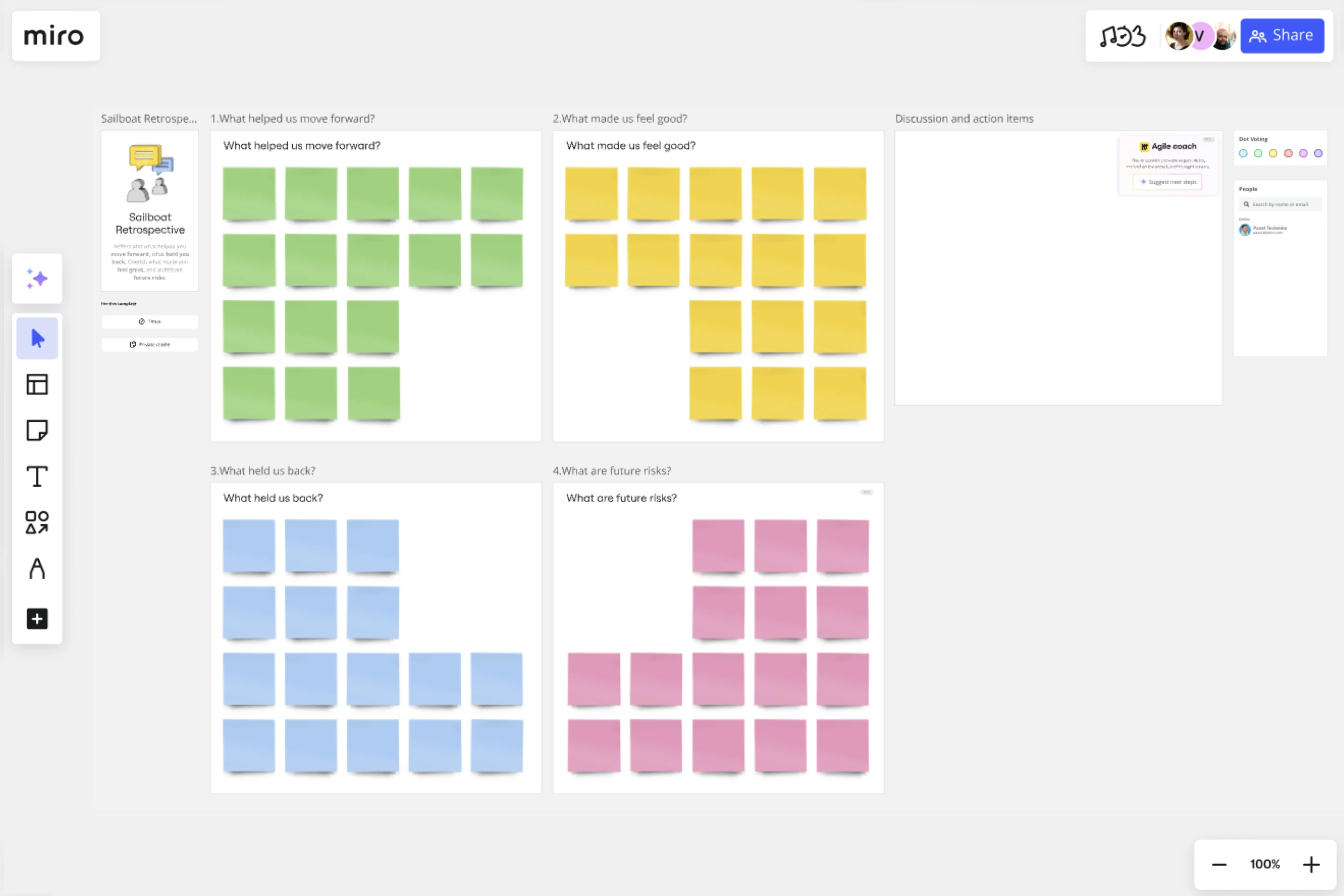
Sailboat Template
Reflect as a team on project goals, blockers, and future ambitions.
About the Sailboat Retrospective Template
The Sailboat Retrospective (also known as the Sailboat Agile Exercise) is a low-pressure way for teams to reflect on how they handled a project. Originally based on the Speedboat retrospective by Luke Hohmann, the exercise centers around a sailboat as a metaphor for the overall project, with various elements broken down:
Rocks - represent risks and potential blockers
Anchors - represent issues slowing down the team
Wind - what helped the team move forward, represents the team’s strengths
Sun - what went well, what made the team feel good
By reflecting on and defining these areas, you’ll be able to work out what you’re doing well and what you need to improve on for the next sprint.
When to use a Sailboat Retrospective Template?
If you are part of an Agile team, you know retrospectives are fundamental to improving your sprint efficiency and getting the best out of your team. The Sailboat Retrospective Template helps you organize this Agile ritual with a sailboat metaphor. Everyone describes where they want to go together by figuring out what slows them down and helps them reach their future goals.
Use this template at the end of your sprint to assess what went well and could have been done better.
Benefits of the Sailboat Retrospective Template
When facilitating your team’s retrospective, this template is an easy way for everyone to jot down ideas in a structured manner. The metaphor of a sailboat gliding over water can help team members think about their work as it relates to the overall course of the project, and the ready-made template makes it easy to fill in and add stickies with ideas and feedback.
To run a successful sailboat retrospective meeting, use Meeting mode to lead your team through each frame, set a timer for each section of the template, and control what participants can do on the board.
Create your own sailboat retrospective
Running your own sailboat retrospective is easy, and Miro’s collaborative workspace is the perfect canvas on which to perform the exercise. Get started by selecting the Sailboat Retrospective Template, then take the following steps to make one of your own.
Introduce the sailboat metaphor to your team . For some teammates, this may be the first time they’ve heard the analogy. Explain the four components, and feel free to frame them as questions (for example, “what helps us work to move forward?”, “what held us back?”, “what risks do you see in our future?”, “what made us feel good?”). Then, tie the visual metaphor back to how to run an Agile sprint. Like a sailboat, a sprint also has factors that slow it down, and risks in the face of a goal, target, or purpose to reach.
Ask each team member to write and reflect individually. Give everyone 10 minutes to create their own sticky notes. Ask them to record their thoughts and reflections relevant to each area of the retrospective. Use Miro’s Countdown Timer to keep things on track.
Present your reflections in pairs or small groups. Spend five minutes each taking turns to dig deeper into the insights recorded on each sticky note.
Choose one team member to group similarly-worded insights together. That team member can spot patterns and relationships between the group’s insights. Accordingly, the team can get a sense of which area had the biggest potential impact on the project.
Vote as a team on what the critical issues are to focus on mitigating and developing. Use the Voting Plugin for Miro to decide what’s worth focusing time and effort on. Each person gets up to 10 votes and can allocate multiple votes to a single issue.
Diagnose issues and develop outcomes. Discuss as a team what your follow-up action plans are for maintaining or building on helpful behavior and resolving issues in preparation for future sprints. Add another frame to your board by clicking Add frame on the left menu bar and annotate your team’s insights and next steps.
Dive even deeper into how to make your own sailboat retrospective – and see examples – in our expert guide to making your own sailboat retrospective .
How do you conduct a sailboat retro?
When conducting a sailboat retro, make a space for you and your team to uncover valuable insights, some of which might not be shareable across your organization. For that reason, make sure to adjust your privacy board settings so that only you and your team can access it, and let them know this is a safe space to share ideas and feedback honestly. The Sailboat Retrospective Template is built for you to run your meeting session smoothly, having complete control of how participants can add to the board. Start explaining the concept of the sailboat retro methodology. If they don’t know it already, guide them through your meeting agenda and set the timer for each section. After the meeting, gather insights in another frame on the same board, and thank everyone for contributing to your retro.
What is the sailboat exercise?
The sailboat exercise is a widely known Agile ritual where you and your team can thoroughly analyze what went well during your last sprint and what could have gone better, so you improve in the next one. This meeting format is similar to a brainstorming session. In each quadrant of the sailboat template, ask your team to add their thoughts and feedback. Use the sailboat exercise when you want to improve processes and gather constructive feedback from your team.
Get started with this template right now.
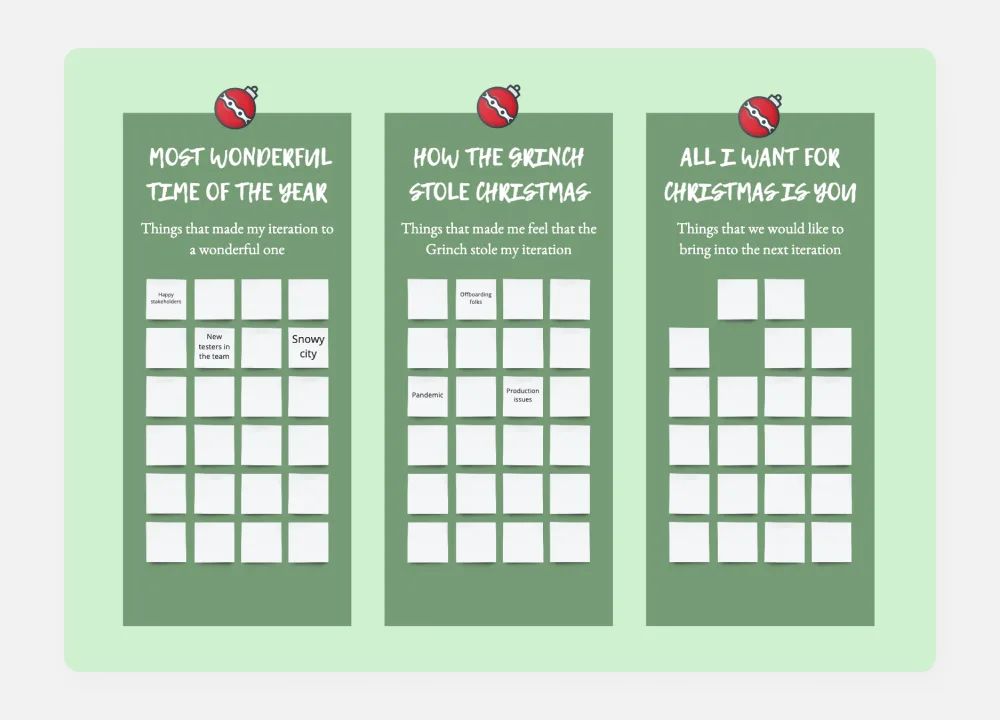
Retrospective - Christmas Edition
Works best for:.
Agile Methodology, Retrospectives, Meetings
The Retrospective Christmas Edition template offers a festive and themed approach to retrospectives, perfect for the holiday season. It provides elements for reflecting on the year's achievements, sharing gratitude, and setting intentions for the upcoming year. This template enables teams to celebrate successes, foster camaraderie, and align on goals amidst the holiday spirit. By promoting a joyful and reflective atmosphere, the Retrospective - Christmas Edition empowers teams to strengthen relationships, recharge spirits, and start the new year with renewed energy and focus effectively.
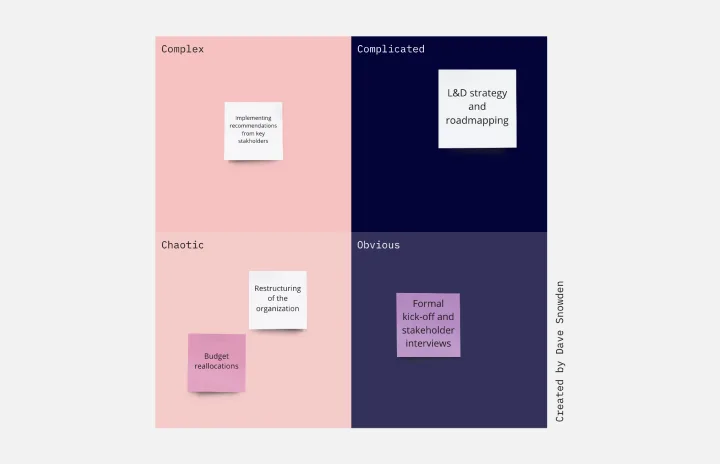
Cynefin Framework Template
Leadership, Decision Making, Prioritization
Companies face a range of complex problems. At times, these problems leave the decision makers unsure where to even begin or what questions to ask. The Cynefin Framework, developed by Dave Snowden at IBM in 1999, can help you navigate those problems and find the appropriate response. Many organizations use this powerful, flexible framework to aid them during product development, marketing plans, and organizational strategy, or when faced with a crisis. This template is also ideal for training new hires on how to react to such an event.
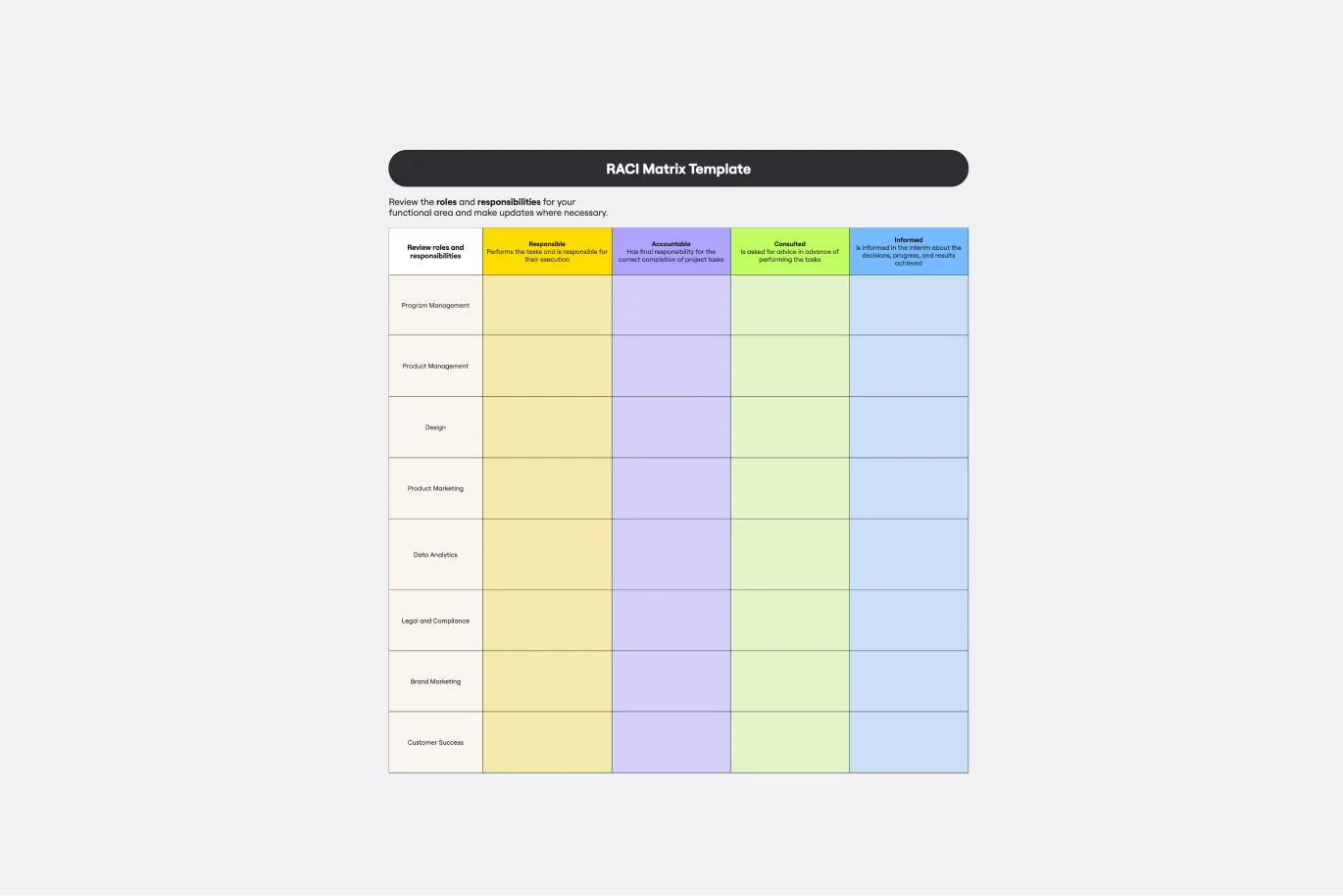
RACI Matrix Template
Leadership, Decision Making, Org Charts
The RACI Matrix is an essential management tool that helps teams keep track of roles and responsibilities and can avoid confusion during projects. The acronym RACI stands for Responsible (the person who does the work to achieve the task and is responsible for getting the work done or decision made); Accountable (the person who is accountable for the correct and thorough completion of the task); Consulted (the people who provide information for the project and with whom there is two-way communication); Informed (the people who are kept informed of progress and with whom there is one-way communication).

Team´s High Performance Tree
Agile, Meetings, Workshops
The Team's High Performance Tree is a visual representation of the factors influencing team performance. It provides a structured framework for identifying strengths, weaknesses, and areas for improvement. By visualizing factors such as communication, collaboration, and leadership, this template enables teams to assess their performance and develop strategies for enhancement, empowering them to achieve peak performance and deliver exceptional results.
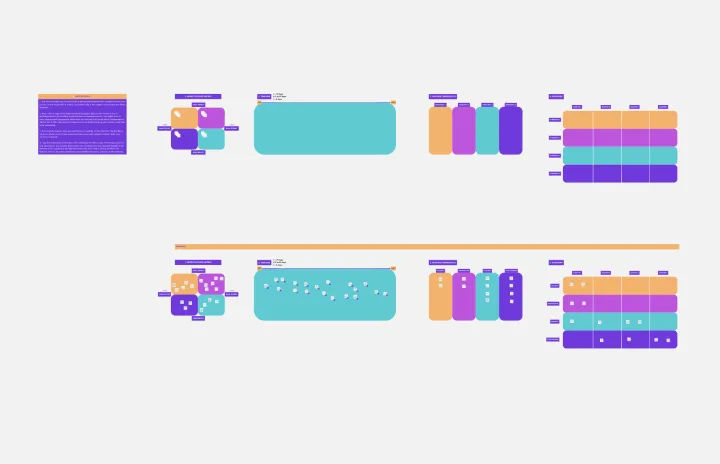
Epic & Feature Roadmap Planning
Epic & Feature Roadmap Planning template facilitates the breakdown of large-scale initiatives into manageable features and tasks. It helps teams prioritize development efforts based on business impact and strategic objectives. By visualizing the relationship between epics and features, teams can effectively plan releases and ensure alignment with overall project goals and timelines.
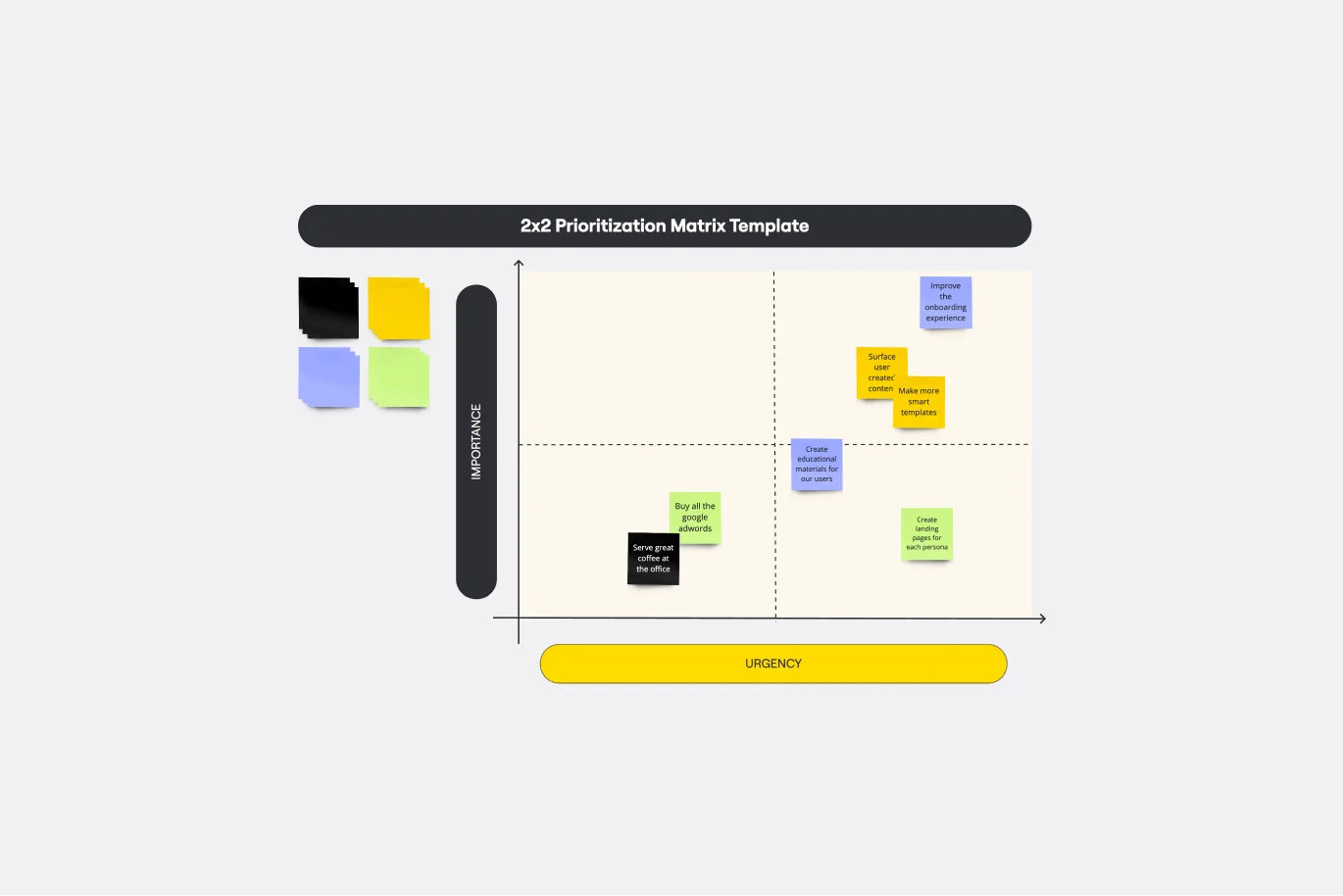
2x2 Prioritization Matrix Template
Operations, Strategic Planning, Prioritization
Ready to set boundaries, prioritize your to-dos, and determine just what features, fixes, and upgrades to tackle next? The 2x2 prioritization matrix is a great place to start. Based on the lean prioritization approach, this template empowers teams with a quick, efficient way to know what's realistic to accomplish and what’s crucial to separate for success (versus what’s simply nice to have). And guess what—making your own 2x2 prioritization matrix is easy.
Retrospectives 102: The Sailboat Method
Summary: After each sprint, the team should have a retrospective session to identify what went well or not so well. The sailboat metaphor is a nice way to structure such retrospectives.
3 minute video by 2020-04-10 3
- Rachel Krause
- Agile Agile ,
- Managing UX Teams ,
Share this article:
- Share this video:
You must have javascript and cookies enabled in order to display videos.
Related Article
UX Retrospectives 101
Retrospectives allow design teams to reflect on their work process and discuss what went well and what needs to be improved. These learnings can be translated into an action plan for future work.
Video Author
Rachel Krause is a Senior User Experience Specialist with Nielsen Norman Group. Her areas of expertise include storytelling, UX in agile, design thinking, scaling design, and UX leadership. She has also planned and conducted research on careers, UX maturity, and intranets for clients and practitioners in numerous industries.
- Share:
Subscribe to the weekly newsletter to get notified about future articles.

MVP: Why It Isn't Always Release 1
4 minute video

Sprint Reviews: Prioritize Your Users

UX in Design Sprints
3 minute video

- Tracking Research Questions, Assumptions, and Facts in Agile
- Incorporating UX Work into Your Agile Backlog
- UX Debt: How to Identify, Prioritize, and Resolve
- Collaborative Agile Activities Reduce Silos and Align Perspectives
- UX Responsibilities in Scrum Events
Research Reports
- UX Metrics and ROI
- Effective Agile UX Product Development
- Architecting a Journey Management Practice: How Leading Organizations Transformed Design Operations to Maximize Business Value
- Operationalizing CX: Organizational Strategies for Delivering Superior Omnichannel Experiences
- Intranet Design Annual: 2018
UX Conference Training Course
- Becoming a UX Strategist
- UX Leader: Essential Skills for Any UX Practitioner
- ResearchOps: Scaling User Research
- Service Blueprinting
- Mastering Influence
Design Thinking Toolkit, Activity 11 – Speed Boat
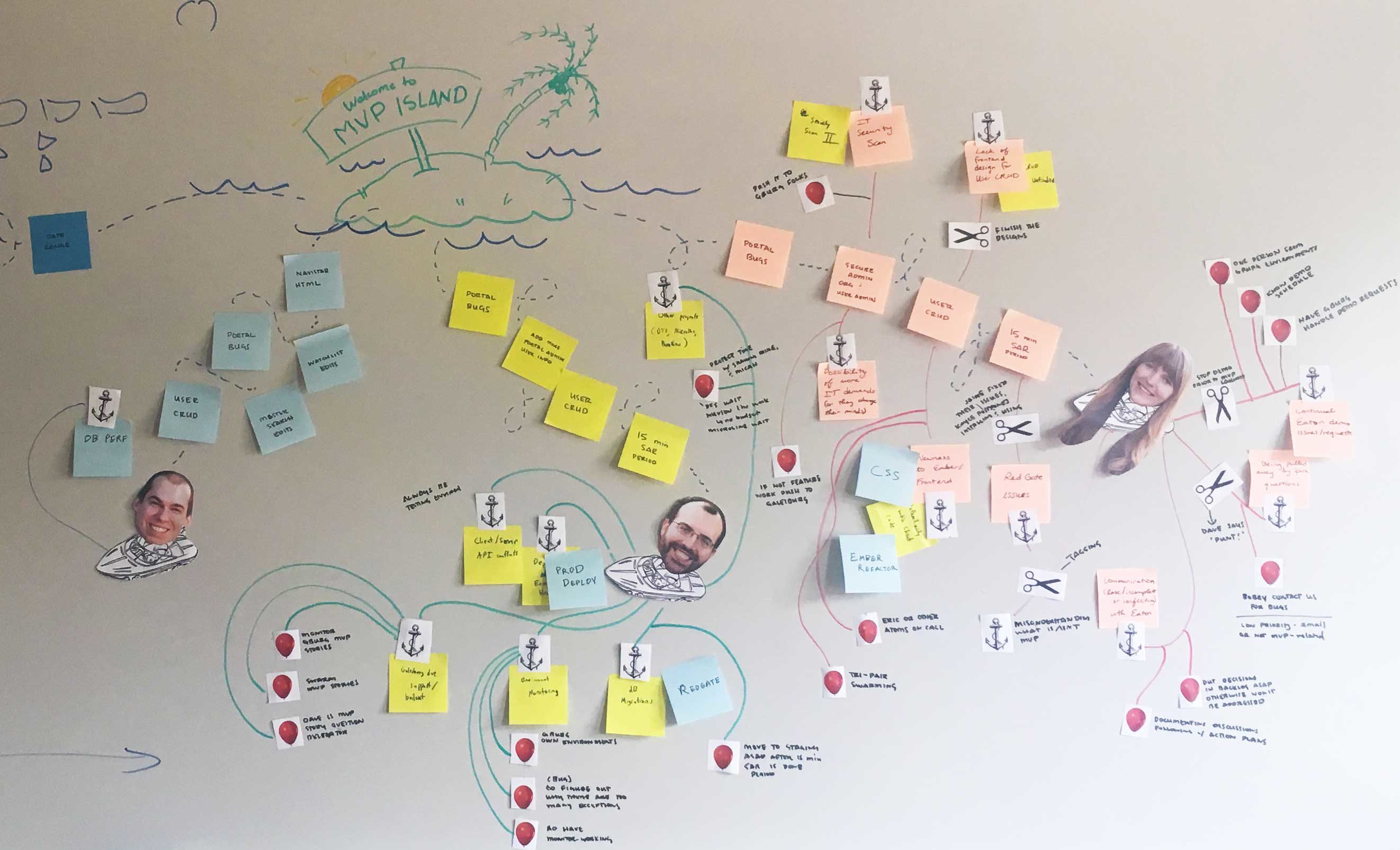
Article summary
Basic edition, advanced edition, final thoughts.
- Atomic's Design Thinking Toolkit
Welcome to our series on Design Thinking methods and activities . You’ll find a full list of posts in this series at the end of the page.

Our next activity has us seabound: Speed Boat .
| To understand obstacles preventing achievement of a goal | |
| When you want to assess risks, obstacles, or blockers | |
| On average, 30-60 minutes (add more if you’re running the advanced edition of this activity) | |
| 1 facilitator and 2-10+ participants | |
| Any portion or combination of the team that needs insight into risks and blockers | |
| Large whiteboard or Post-it Tabletop Pad, Post-it notes, Sharpies, whiteboard markers, activity graphics (printed and cut out) |
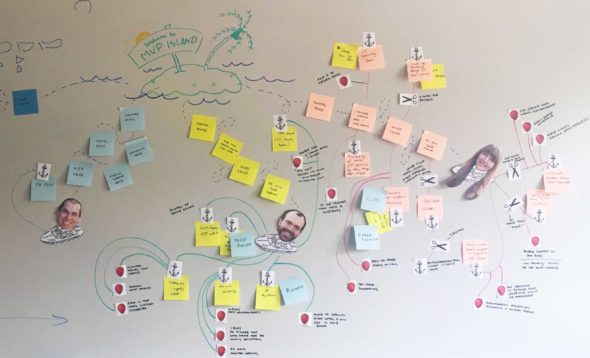
Speed Boat is the activity you turn to when you want to interject a little life into your process while also framing the obstacles that are holding back the success of your project. Setting it up can be as quick or time-consuming as you’d like to make it. I tend to go the extra mile when it comes to prep-work because the added graphics really help people to engage in the work.
So what is Speed Boat? Simply put, it’s a metaphor that helps you visualize the obstacles that prevent you from achieving your goal. Your project or service is the boat, and anchors are the obstacles, risks, and/or uncompleted tasks preventing you from reaching your destination, the goal.
It’s so easy to get caught up in day-to-day activities that it can become hard to understand why goals aren’t being achieved or where areas of risk have bubbled up. Bust out this activity when you want a quick lay of the land, or in this case, the sea.
You can choose the basic or advanced version of this activity. I’ll begin with the simplest one.
To begin, you’ll need a large whiteboard or wall space, activity graphics of a boat and several anchors, Post-it notes, Sharpies, whiteboard markers, and tape. If you don’t have access to a printer, you can draw the boat and anchors on the board or Post-its as you go, but I’ve found that printed cut-outs make it easier to see the images and move them freely about the board.
Tape your boat to the whiteboard and give it a name, mostly likely your project name. Next, draw an island and put the question you’d like answered at the center of it. This is where you can be really creative with how you structure the activity.
Product and service-related question examples
- What is preventing us from launching?
- Why are users slow to adopt our new technology?
- Why aren’t we standing out from the competition?
- What is preventing users from completing the checkout and payment process?
Personal or non-software related questions
These could be helpful if you’d like to use the framework for something other than project work.
- What is preventing us from achieving our financial goal (like saving for a home, car, or vacation)?
- What is holding me back from running a marathon?
- What is blocking me from having a deeper relationship with my significant other?
- What is keeping my family from gathering together at the dinner table every evening?
Finally, pass out Post-its and Sharpies to each participant, and scatter the anchors about the table so that everyone can grab them as needed.
2. Anchors away!
Present your island question, and explain that the anchors represent obstacles that are slowing down forward progress toward this goal.
Allow participants to ask clarifying questions, and then give them 10 minutes to begin listing anchors. Each Post-it should mention only one anchor.
Once the time is up, ask participants to describe their anchors one by one. Connect the anchors to the boat by sticking the Post-it notes to the board and drawing an anchor line between each note and the boat.
Group any like observations, tasks, and insights together. Finally, ask the group to estimate how much faster the boat would go if all the anchors were cut free.
Take your findings and list them in a spreadsheet, mind map, or backlog so you can keep track of them. You might need to assign owners and dates to some items or tasks to keep moving forward.
Now that you understand the core activity, we’re going to add in two extra elements: scissors and buoys. Scissors are the tasks or ideas that cut an anchor free altogether, and buoys relieve pressure from anchors, but don’t eliminate them completely.
These two extra steps or graphics can help you define solutions for your problems (a.k.a. anchors). They’re helpful if you have extra time and/or a very action-oriented team who wants to assess and take action.
However, they do add an extra 30 minutes or so to the activity, so take your time constraints and group size into consideration when scheduling. Running this activity can be done with a large team, but the process will be more time-consuming.
You’ll prep the activity the same way as the basic edition. However, for this version, there are a few additional graphics (the scissors and buoys) to print and cut ahead of time.
2. Advanced anchors away!
Once again, run the activity as you would in basic mode, all the way to the point where everyone has discussed and posted all of their anchors.
Now that the group has a good sense of everything that’s holding back the boat, ask everyone to gather around the whiteboard to collaboratively post buoys and snip anchor lines with the scissors.
Keep in mind, buoys are ideas, tasks, services, people, etc. that can help relieve pressure from an anchor but cannot cut the anchor line altogether. For example, if an anchor is “poor WIFI connectivity,” a buoy might be “adding another access point,” while a scissor would be “hard-wiring internet capabilities to the device.”
It’s easiest to review one anchor at a time so that the group can brainstorm ideas and discuss the challenges together. It’s also helpful to gain group consensus on how to solve a problem.
Finally, wrap up the activity in the same way as you would for the basic edition.
There are many ways to run Speed Boat, so be creative with your implementation. Most importantly, have fun! Visualizing project risks and obstacles in this way may seem cheesy, but it’s a much more pleasant exercise than wading through the soulless cells of a spreadsheet.
Leave a comment below if you’ve tried this activity, and keep your eyes out for our next activity, Visualizing the Vote!
Atomic’s Design Thinking Toolkit
- What Is Design Thinking?
- Your Design Thinking Supply List
- Activity 1 – The Love/Breakup Letter
- Activity 2 – Story Mapping
- Activity 3 – P.O.E.M.S.
- Activity 4 – Start Your Day
- Activity 5 – Remember the Future
- Activity 6 – Card Sorting
- Activity 7 – Competitors/Complementors Map
- Activity 8 – Difficulty & Importance Matrix
- Activity 9 – Rose, Bud, Thorn
- Activity 10 – Affinity Mapping
- Activity 11 – Speed Boat
- Activity 12 – Visualize The Vote
- Activity 13 – Hopes & Fears
- Activity 14 – I Like, I Wish, What If
- Activity 15 – How to Make Toast
- Activity 16 – How Might We…?
- Activity 17 – Alter Egos
- Activity 18 – What’s On Your Radar?
- Activity 19 – The Perfect Morning
- Activity 20 – 2×3
- Activity 21 – How Can I Help…?
- Activity 22 – Cover Story
- Activity 23 – Crazy 8s
- Activity 24 – Abstraction Ladder
- Activity 25 – Empathy Map
- Activity 26 – Worse Possible Idea
- Activity 27 – Pre-Project Survey
- Activity 28 – The Powers of Ten
- Activity 29 – SCAMPER
- Activity 30 – Design Studio
- Activity 31 – Forced Connections
This is an updated version of a post originally published in June 2018.
Related Posts
Design thinking toolkit, activity 16 – how might we…, design thinking toolkit, activity 15 – how to make toast, design thinking toolkit, activity 14 – i like, i wish, what if, keep up with our latest posts..
We’ll send our latest tips, learnings, and case studies from the Atomic braintrust on a monthly basis.
Join the conversation Cancel reply
Your email address will not be published. Required fields are marked *
Save my name, email, and website in this browser for the next time I comment.
Tell Us About Your Project
We’d love to talk with you about your next great software project. Fill out this form and we’ll get back to you within two business days.

The Sailboat Retrospective is a fun and creative way for teams to reflect on the sprint and identify areas for improvement. It’s called “Sailboat” because the metaphor of a sailboat helps the team visualize their journey, the obstacles they faced, and the direction they want to sail towards in the future. The Sailboat or Speedboat Method for Sprint Retrospectives is an easy way to: adopt, reflect and map the team’s way forward easily, in a fun, tactile and visual way. It helps the team to reflect on what’s going well and what could be better, analyze their sails and anchors and identify opportunities for improvement or change.
The idea is that the team is on a sailboat, heading towards their goal while dealing with winds and icebergs along the way. Winds help propel the boat forward but obstacles such as pirates, rocks, and stubborn anchors represent the risks that the team might encounter that could slow them down or even stop them from getting to where they need to be.
- Boat : The Scrum team
- Sails : The things that helped us move forward (Wind, Cloud)
- Anchors : The things that held us back (Pirates, Rocks, Sharks, Icebergs, and Anchors)
- Island : The goals to be achieved
- Sun : What the team liked, the actions or attitudes that deserve thanks
- Reef : Represent future obstacles that have been identified, which the group is likely to encounter in the subsequent iterations.
Note : The original Sailboat technique doesn’t have a Sun – I added it to give them a feeling of accomplishment as most teams should understand that there are already things that work just fine. And it’s definitely worth the time to help the team to build on this base.
- Fact-based Analysis for Sprint Retrospective
- Start, Stop, and Continue Sprint Retrospective
- Glad-Sad-Mad Sprint Retrospective
- Starfish Sprint Retrospective
- Sailboat Sprint Retrospective
- Liked Learned Lacked Longed For (4Ls) Retrospective
Different Steps of Sailboat Sprint Retrospective
Step 1: set the stage – draw a sailboat.
Start by setting clear expectations for the meeting, including the purpose, goals, and agenda. Make sure everyone is aware of the retrospective’s purpose and that it is a safe space for open and honest communication.
Let the team draw a picture of a sailboat floating in the water, and fill half the space above and half below the water with the sun, anchors, wind, rocks, reef, and an island or you can simply print pictures and just attach them to the board or any available wall space. This visual representation can help the team better understand their progress.
Note : Team drawing the boat helps to act as an icebreaker and get the group participating and on the boat.
Step 2: Name the Sailboat
Decide the topic/theme of the retrospective and name the boat accordingly.
Step 3: Add mission
Ask the team to write what their mission is, what they want to achieve, and what their goal is, and add these post-it notes to the hull of the boat. The team can amend or clarify or replace as the game continues.
The boat can be saved and revisited as part of sprint reviews, where sails and anchors can be reviewed, rescored, removed, and new sails and anchors added.
Tips : Ask team members to share their successes and challenges during the sprint or project. This allows everyone to see what worked well and what didn’t, which can help identify areas for improvement.
Step 4: Add Sails and Anchors
Ask the team to add sails and anchors to their boat. Sails represent things going well, what’s good, and what is putting the wind into their sails. Anchors are the things that could be going better, the anchors holding them back and limiting progress.
Step 5: Scale your sails and anchors
Ask the teams to scale their sales and anchors, their sails from +1 to + 10, is it a +1 or 2, a nice but relatively small in-value sail, or a main sail that’s providing huge momentum, a +9 or +10? The anchors from -1, a minor impediment, or -10 this anchor have stopped us from moving forward at all.
Now team should brainstorm and discuss each note, seek to clarify the meaning of the note, and then decide as a group where on the scale it should be. Teams can vote by Dot Voting. The team can compare Sails and Anchors. Is it a bigger or smaller sail/anchor than the previous one? The key here is engaging in group discussions, awareness, and consensus on what the sail/anchor is and how it impacts the team. Sticky notes may need to be clarified with extra information or split into multiple notes to score separately.
Step 6: Add ideas for +1 raising sails and/or anchors
Once all sails and anchors have been discussed and scored ask the team to capture activities and improvements to help raise sails further and raise up anchors. Ask the team to think of small actions that would raise one of the sails, or anchors on the boat by just one point, raise an anchor from a -6 to a -5, or raise a sail from a 2 to a 3. Capture ideas for improvements on post-it notes and place them beside the relevant anchor or sail.
Step 7: Discuss Reef, and Sun and Plan the next steps
Remember to celebrate success and plan action items for current as well as future obstacles that have been identified during the above brainstorming.
If there are numerous suggestions for raising sails and anchors then team activities like estimation games, MoSCoW prioritization, and Dot Voting to help discuss, rank, and decide upon which improvements to take forward. Map the improvements/actions into the team backlog/future work or on a dedicated change and improvement board to help track and measure progress.
Sailboat Retrospective Example
Let’s take an example of a team that developed a mobile app during the sprint. The team was able to deliver the features on time but faced some challenges during the sprint. Here’s how they conducted the Sailboat Retrospective:
- Draw a Sailboat: The team drew a sailboat with a sail, a mast, a keel, a waterline, wind, rocks, and a shore.
- Write the Sprint Goal: The team wrote the sprint goal at the top of the sailboat: “Develop a mobile app with login, registration, and dashboard features.”
- List the Positive Factors: The team listed the positive factors that helped them during the sprint, such as good communication, pair programming, and code reviews. They wrote these on the sail and the mast, as the wind filled the sail and propelled the sailboat forward.
- List the Negative Factors: The team listed the negative factors that hindered their progress during the sprint, such as a lack of automated testing, dependency on external APIs, and unclear requirements. They wrote these on the keel and the rocks, as the obstacles that slowed down the sailboat or could cause it to crash.
- Identify the Improvement Areas: The team discussed the negative factors and identified areas for improvement.
Open-ended Questions for Sailboat Retrospective
- What makes them happy?
- What’s slowing them down?
- What’s propelling them forward? What are the gusts of wind that help our sailboat to move forward?
- Is this bigger or smaller than the last item we scaled?
- If you could cut away one anchor which would it be? How could you do that?
- If you could raise one sail to 10 which would it be? How could you do that?
- What would happen if all anchors were cut away? what would change?
- If you could add an ‘iron sail’ (an engine!) to your sailboat what would it be?
- How can we raise this sail from a 5 to a 6?
- How can we raise this anchor from a -7 to a -6?
Sailboat or Speedboat Facilitation Tips
- First collect all the anchors, as it’s easier for most teams to organize their current problems.
- Ask the team to turn each anchor into goals, desires, or wishes and put them before the cloud to represent the gusts of wind pushing the boat forward.
- Use these “winds” to define a desirable goal you will use as a true north for the rest of the retrospective.
- Use data to help guide the retrospective discussion, such as team velocity or user feedback. Data can help provide a more objective view of the team’s performance.
- Based on the discussion, identify specific action items that the team can work on to improve. Make sure to assign ownership of these items and set clear deadlines.
- Follow up on the action items from the retrospective in the next meeting to ensure progress is being made.
- Keep the retrospective focused on finding solutions, not blaming individuals or criticizing past decisions. Maintain a positive and constructive atmosphere to encourage open communication and a sense of teamwork.
Sailboat or Speedboat Challenges & Strategies to Overcome
Sailboat Sprint Retrospectives are an important part of the Agile development process, as they allow teams to reflect on their progress and identify areas for improvement. However, there are several common challenges that teams may face during these retrospectives. Here are some of the most common challenges and tips on how to overcome them:
- Lack of Participation: In some cases, team members may be hesitant to speak up during a retrospective, which can hinder the effectiveness of the session. To overcome this, the facilitator can encourage participation by creating a safe and open environment where all team members feel comfortable sharing their thoughts and ideas. They can also try using interactive activities or icebreakers to get everyone engaged.
- Blaming and Finger-Pointing: Retrospectives can sometimes turn into a blame game, with team members pointing fingers at each other for mistakes or issues. This can lead to a negative atmosphere and prevent constructive feedback. To avoid this, the facilitator should set ground rules at the session’s beginning that encourage constructive criticism and discourage personal attacks.
- Lack of Actionable Insights: In some cases, retrospectives can feel like a waste of time if the team does not develop actionable insights they can implement in future sprints. To prevent this, the facilitator can ensure that the team focuses on identifying specific actions that they can take to improve in the next sprint. They can also assign action items to team members and set deadlines for completion.
- Dominant Voices: Sometimes, one or two team members may dominate the conversation during a retrospective, preventing others from sharing their thoughts and ideas. To prevent this, the facilitator can use round-robin or anonymous feedback to ensure that everyone has an equal opportunity to speak.
- Lack of Follow-Through: Even if the team comes up with actionable insights during the retrospective, there is a risk that they may not be implemented in future sprints. To prevent this, the facilitator can assign ownership of action items to specific team members and follow up on their progress in subsequent retrospectives.
Scrum Master Role in Facilitating Sailboat Sprint Retrospective
The Scrum Master plays a critical role in facilitating a successful Sailboat Sprint Retrospective. Here are some key responsibilities of the Scrum Master in this process:
- Creating a Safe and Open Environment: The Scrum Master needs to create a safe and open environment where team members feel comfortable sharing their thoughts and feedback. The Scrum Master should encourage open and honest communication, actively listen to the team members, and ensure that everyone has an opportunity to share their perspectives.
- Guiding the Retrospective Process: The Scrum Master should guide the retrospective process, ensuring that it stays on track and that the team is making progress towards actionable improvements. The Scrum Master should use the Sailboat metaphor to help the team identify areas of strength and improvement, and facilitate a discussion that leads to actionable items.
- Encouraging Collaborative Problem Solving: The Scrum Master should encourage the team to work collaboratively to solve problems and address issues identified during the retrospective. The Scrum Master should facilitate a discussion where the team can brainstorm potential solutions and identify concrete action items.
- Facilitating Continuous Improvement: The Scrum Master should ensure that the team is focused on continuous improvement and that the actionable items identified during the retrospective are implemented. The Scrum Master should work with the team to develop a plan to implement the changes and monitor progress towards the goals identified.
- Monitoring Team Dynamics: The Scrum Master should also monitor team dynamics during the retrospective to identify any issues that may be hindering team performance. The Scrum Master should work with the team to address these issues and promote a positive team culture.
Sprint Retrospective – Tools and Techniques: Click Here
- BOAT OF THE YEAR
- Newsletters
- Sailboat Reviews
- Boating Safety
- Sails and Rigging
- Maintenance
- Sailing Totem
- Sailor & Galley
- Living Aboard
- Destinations
- Gear & Electronics
- Charter Resources
- Ultimate Boating Giveaway

Sailboat Design Evolution
- By Dan Spurr
- Updated: June 10, 2020
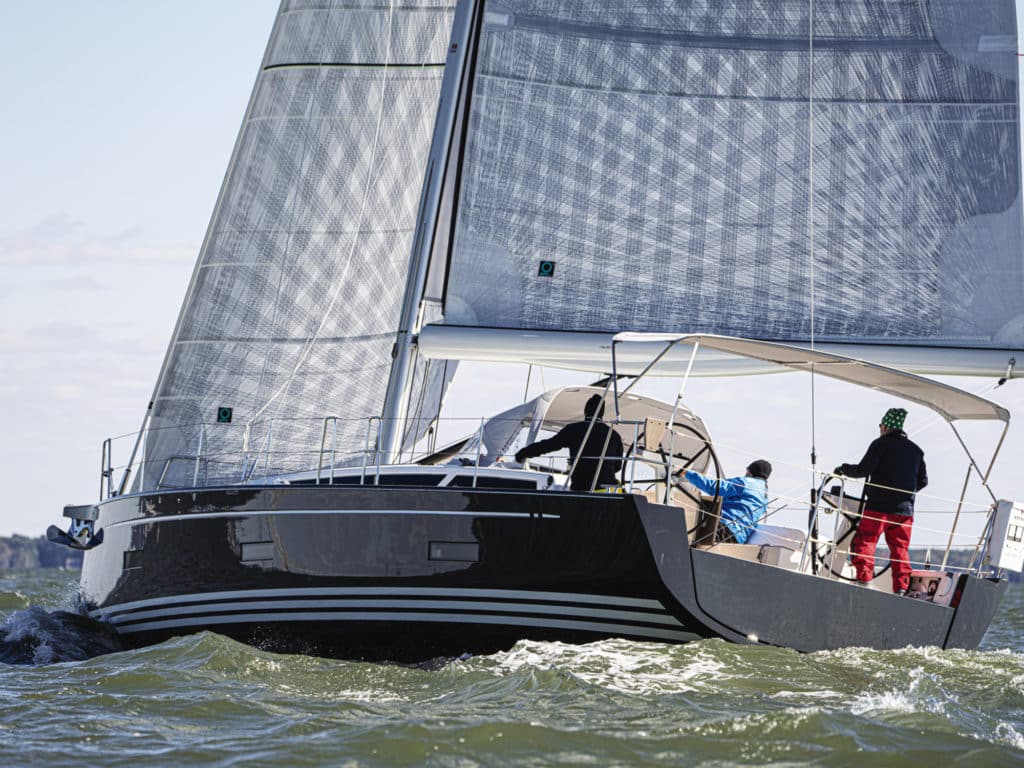
You know the old saying, “The more things change, the more they stay the same”? As a judge for the 2020 Boat of the Year (BOTY) competition at this past fall’s US Sailboat Show in Annapolis, Maryland, I helped inspect and test-sail 22 brand-new current-model sailboats. And I came away thinking, Man, these aren’t the boats I grew up on. In the case of new boats, the saying is wrong: “Nothing stays the same.”
OK, sure, today’s boats still have masts and sails, and the monohulls still have keels. But comparing the Hinckley Bermuda 40, considered by many to be one of the most beautiful and seaworthy boats of the 1960s, ’70s and even ’80s, with, say, the Beneteau First Yacht 53, which debuted at the show, is pretty much apples and oranges.
To get a better sense of what has happened to yacht design, boatbuilding and equipment over the past three, four or even six decades, let’s take a closer look.
Design Dilemmas
At the risk of oversimplification, since the fiberglass era began in the late 1940s and ’50s, the design of midsize and full-size yachts has transitioned from the Cruising Club of America rules, which favored all-around boats (racers had to have comfortable interiors) with moderate beam and long overhangs, to a succession of racing rules such as the IOR, IMS and IRC. All of them dictated proportions, and each required a measurer to determine its rating.
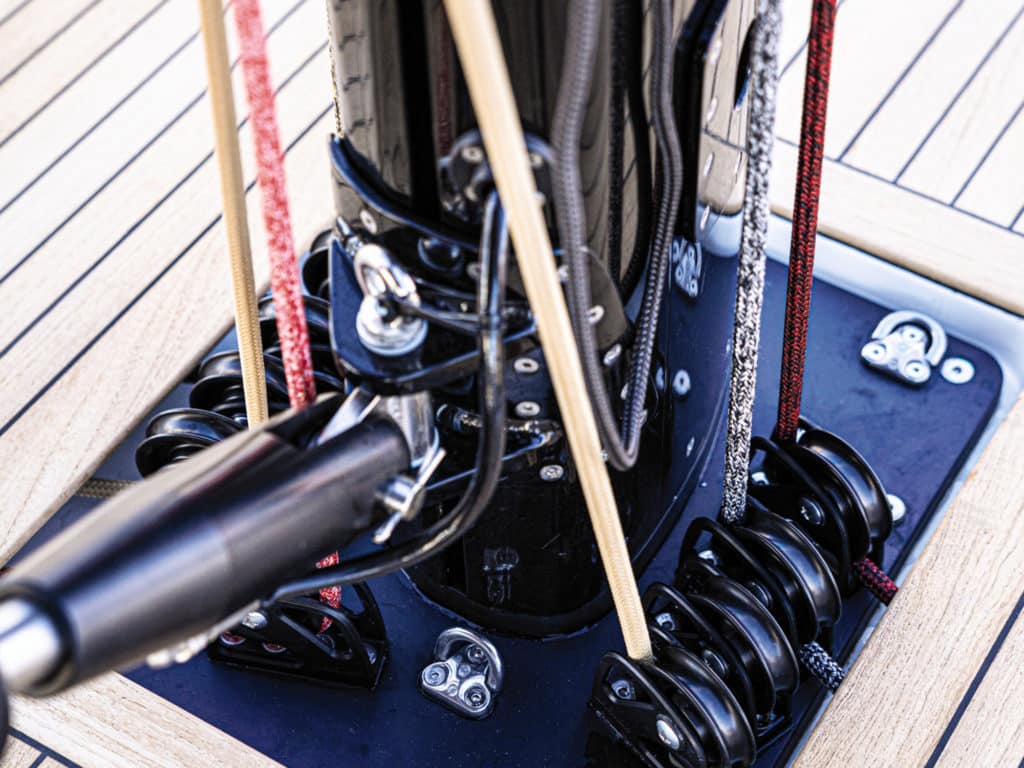
As frustration grew with each (no handicap rule is perfect), alternatives arose, such as the Performance Handicap Racing Fleet, which essentially based one’s handicap on past performance of the same boats in the same fleet. Also, one-design racing became more popular, which spread beyond identical small boats to full-size yachts, popularized in part by builders such as J/Boats and Carroll Marine. The ethos there was: Who cares about intricate rating rules? Let’s just go out and sail fast and have fun!
And that might best sum up the design briefs for the monohulls in this year’s BOTY competition: good all-around performance with comfortable, even luxurious accommodations. Gone are interiors that noted naval architect Robert Perry called “the boy’s cabin in the woods,” deeply influenced by stodgy British designers of the past century and their now-old-fashioned (though sea-friendly, one should note) concepts of a proper yacht, drawn and spec’d by the same guy who designed the hull, deck and rig. Today, dedicated European interior designers are specially commissioned to inject modernity, home fashion colors and textures, amenities, and more light—even dubiously large port lights in the topsides.
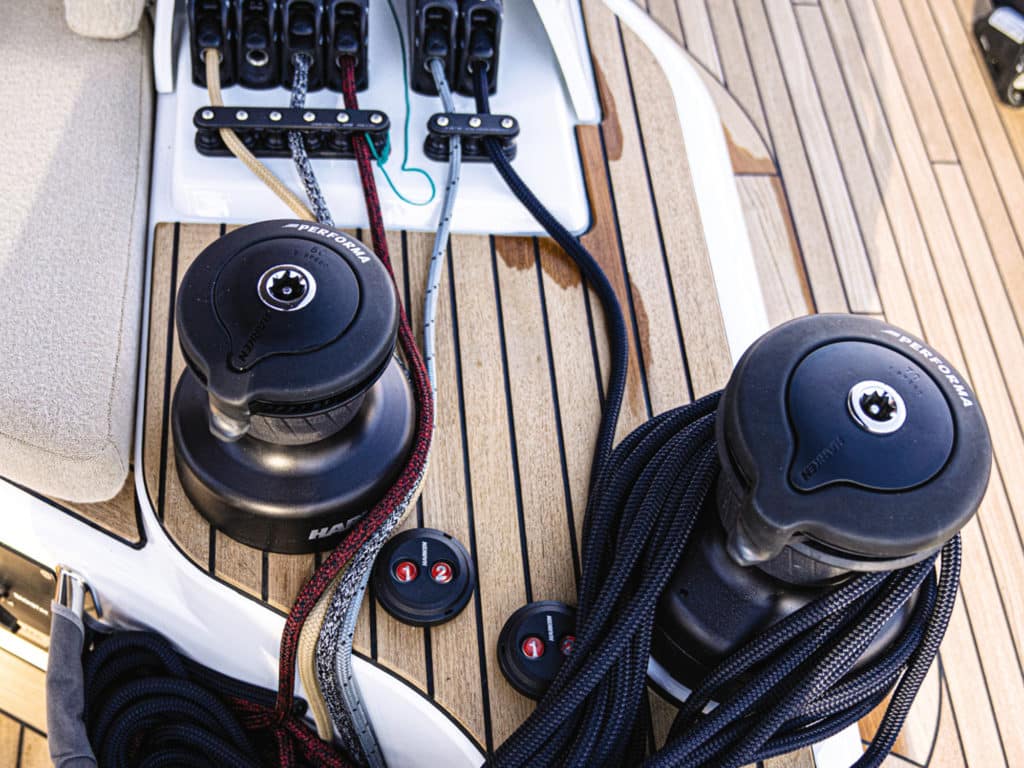
Overhangs, bow and stern, have virtually disappeared. Why? It seems largely a matter of style. Plus, the bonus of increased usable space below, not to mention a longer waterline length for a given length overall, which translates to more speed. Former naval architect for C&C Yachts and Hunter Marine, Rob Mazza, recalls that 19th-century pilot cutters and fishing schooners operating in offshore conditions generally had plumb bows, so in a sense, bow forms have come full circle.
Today’s boats are carrying their wide beam farther aft. Gone are the days of the cod’s head and mackerel tail. Wide, flat canoe bodies are decidedly fast off the wind, and might even surf, but they pay a comfort penalty upwind.
These boats have lighter displacement/length (D/L) ratios, which means flatter bottoms and less stowage and space for tanks. The Beneteau 53 has a D/L of 118, compared with the aforementioned Bermuda 40 of 373. Among entries in this year’s BOTY, the heaviest D/L belonged to the Elan Impression 45.1, with a D/L of 195. Recall that when Perry’s extremely popular Valiant 40 was introduced in 1975, the cruising establishment howled that its D/L of 267 was unsuitable for offshore sailing. My, how times have changed!
Perhaps more important, one must ask: “Have the requirements for a good, safe bluewater cruiser actually changed? Or are the majority of today’s production sailboats really best-suited for coastal cruising?”
The ramifications of lighter displacement don’t end there; designers must consider two types of stability: form and ultimate. As weight is taken out of the boat, beam is increased to improve form stability. And with tanks and machinery sometimes raised, ballast might have to be added and/or lowered to improve ultimate stability.
What else to do? Make the boat bigger all around, which also improves stability and stowage. Certainly the average cruising boat today is longer than those of the earlier decades, both wood and fiberglass. And the necessarily shallower bilges mean pumps must be in good shape and of adequate size. That’s not as immediate an issue with a deep or full keel boat with internal ballast and a deep sump; for instance, I couldn’t reach the bottom of the sump in our 1977 Pearson 365.
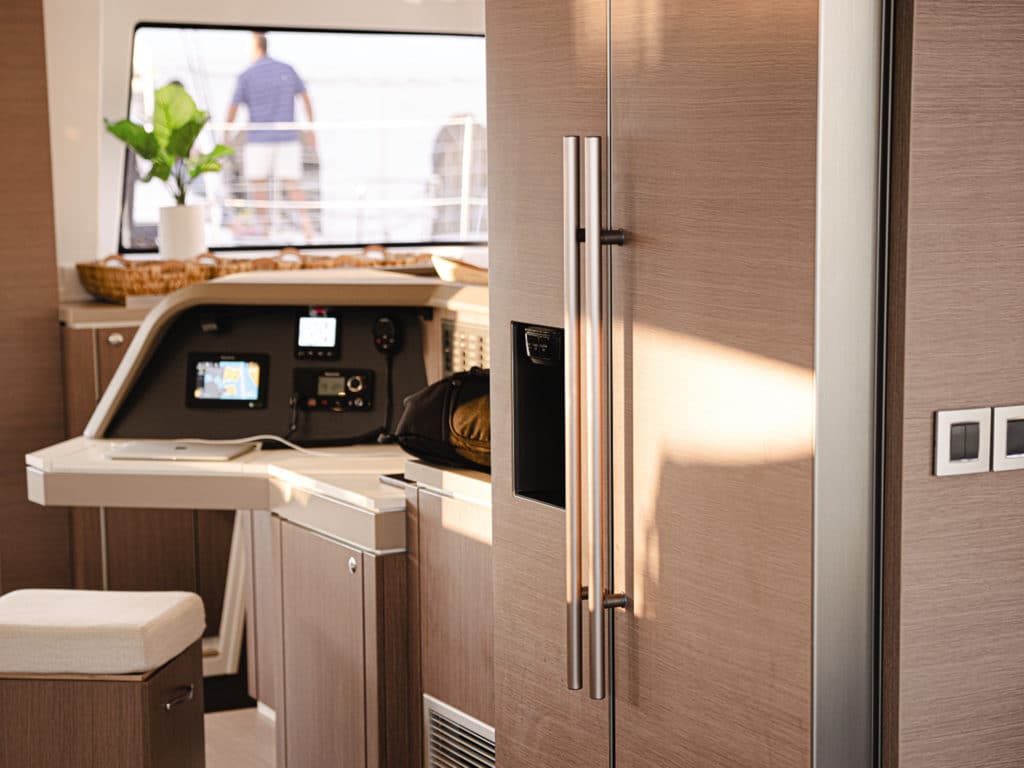
And how do these wide, shallow, lighter boats handle under sail? Like a witch when cracked off the wind. We saw this trend beginning with shorthanded offshore racers like those of the BOC Challenge round-the-world race in the early 1980s. As CW executive editor Herb McCormick, who has some experience in these boats, says, “They’ll knock your teeth out upwind.” But route planning allows designers to minimize time upwind, and cruisers can too…if you have enough room and distance in front of you. Coastal sailors, on the other hand, will inevitably find even moderate displacement boats more comfortable as they punch into head seas trying to make port.
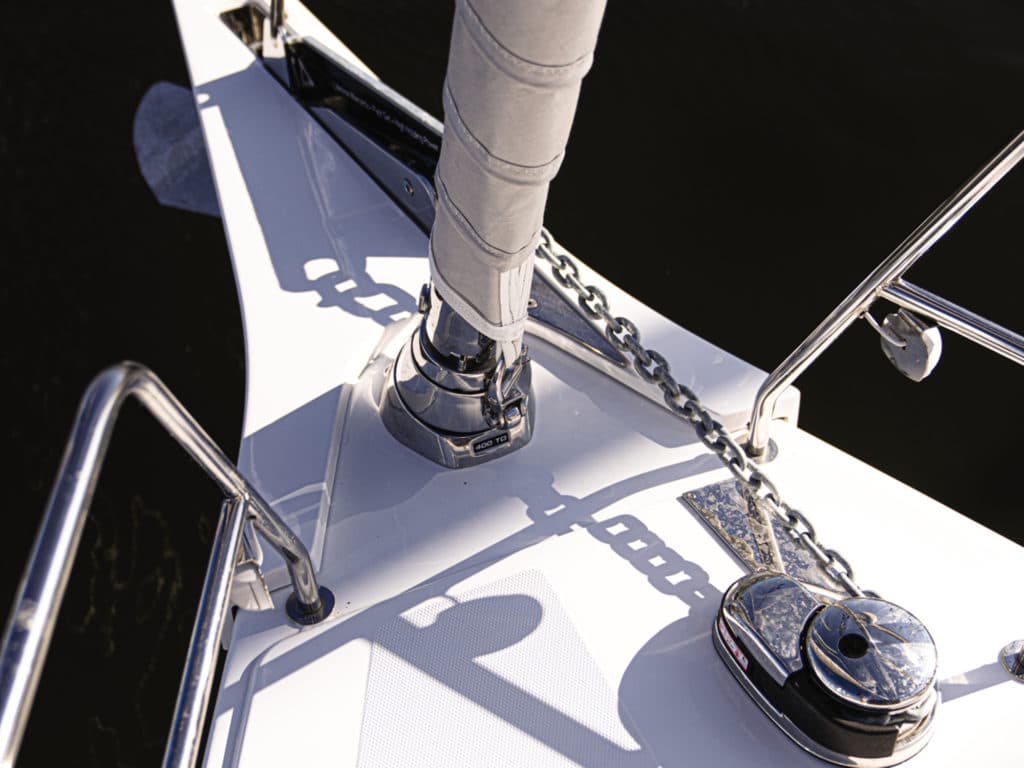
A wide beam carried aft permits a number of useful advantages: the possibility of a dinghy garage under the cockpit on larger boats; easy access to a swim platform and a launched dinghy; and twin helms, which are almost a necessity for good sightlines port and starboard. Of course, two of anything always costs twice as much as one.
Some multihulls now have reverse bows. This retro styling now looks space-age. Very cool. But not everyone is sold on them. Canadian designer Laurie McGowan wrote in a Professional BoatBuilder opinion piece, “I saw through the fog of faddishness and realized that reverse bows are designed to fail—that is, to cause vessels to plunge when lift is required.” Mazza concurs: “Modern multihulls often have reverse stems with negative reserve buoyancy, and those are boats that really can’t afford to bury their bows.”
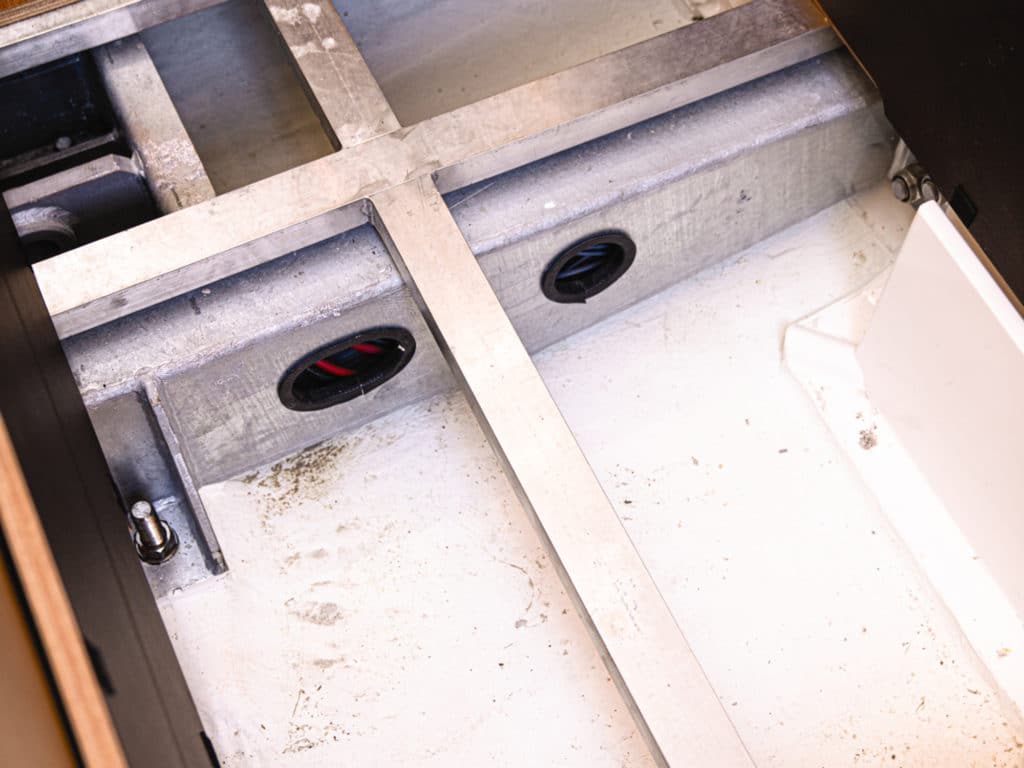
McGowan also cites another designer critiquing reverse bows for being noticeably wet and requiring alternative ground-tackle arrangements. The latter also is problematic on plumb bows, strongly suggesting a platform or sprit to keep the anchor away from the stem.
Rigging Redux
If there was a boat in Annapolis with double lower shrouds, single uppers, and spreaders perpendicular to the boat’s centerline, I must have missed it. I believe every boat we sailed had swept-back spreaders and single lowers. An early criticism of extreme swept-back spreaders, as seen on some B&R rigs installed on Hunter sailboats, was that they prevented fully winging out the mainsail. The counter argument was that so many average sailors never go dead downwind in any case, and broad reaching might get them to their destinations faster anyway—and with their lunch sandwiches still in their stomachs.
That issue aside, the current rigging configuration may allow for better mainsail shape. But as Mazza points out, it’s not necessarily simple: “By sweeping the spreaders, the ‘transverse’ rigging starts to add fore-and-aft support to the midsection of the mast as well, reducing the need for the forward lowers. However, spreader sweep really does complicate rig tuning, especially if you are using the fixed backstay to induce headstay tension. Swept spreaders do make it easier to sheet non-overlapping headsails, and do better support the top of the forestay on fractional rigs.”
Certainly, the days of 150 percent genoas are over, replaced by 100 percent jibs that fit perfectly in the foretriangle, often as a self-tacker.
Another notable piece of rigging the judges found common was some form of lazy jacks or mainsail containment, from traditional, multiple lines secured at the mast and boom; to the Dutchman system with monofilament run through cringles sewn into the sail like a window blind; to sailmaker solutions like the Doyle StackPak. This is good news for all sailors, especially those who sail shorthanded on larger boats.
Construction Codas
Improvements in tooling—that is, the making of molds—are easily evident in today’s boats, particularly with deck details, and in fairness. That’s because many of today’s tools are designed with computer software that is extraordinarily accurate, and that accuracy is transferred flawlessly to big five-axis routers that sculpt from giant blocks of foam the desired shape to within thousandths of an inch. Gone are the days of lofting lines on a plywood floor, taken from a table of offsets, and then building a male plug with wood planks and frames. I once owned a 1960s-era sailboat, built by a reputable company, where the centerline of the cockpit was 7 degrees off the centerline of the deck—and they were one piece!
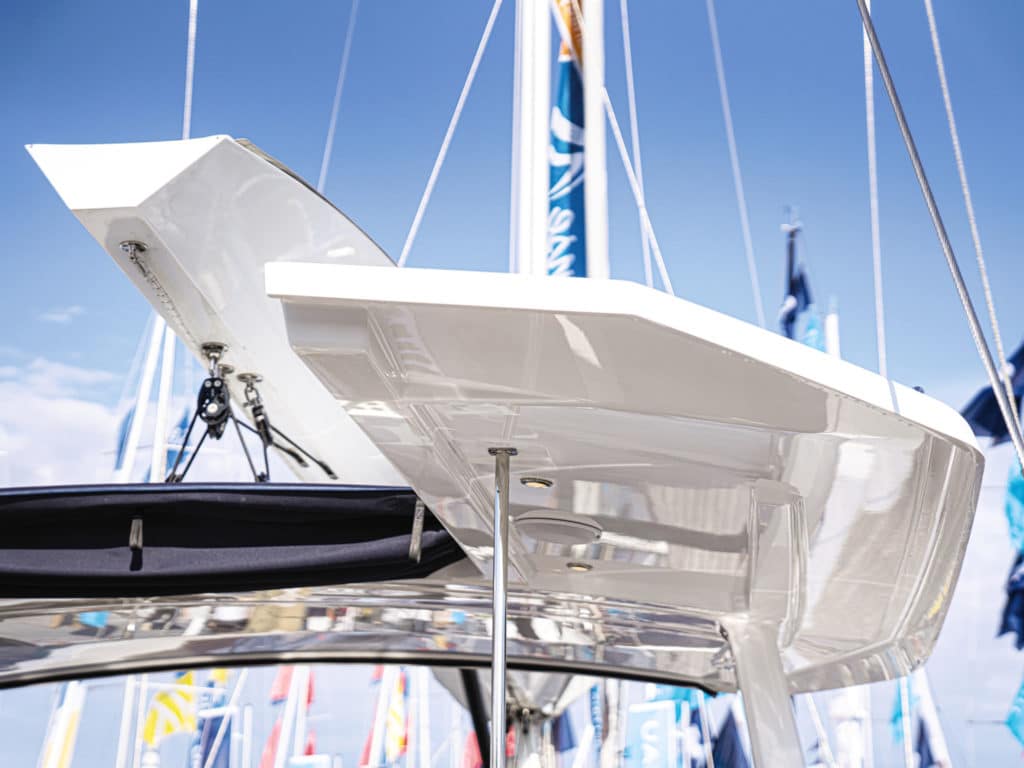
Additive processes, such as 3D printing, are quickly complementing subtractive processes like the milling described above. Already, a company in California has made a multipart mold for a 34-foot sailboat. Advantages include less waste materials.
Job training also has had an impact on the quality of fiberglass boats. There are now numerous schools across the country offering basic-skills training in composites that include spraying molds with gelcoat, lamination, and an introduction to vacuum bagging and infusion.
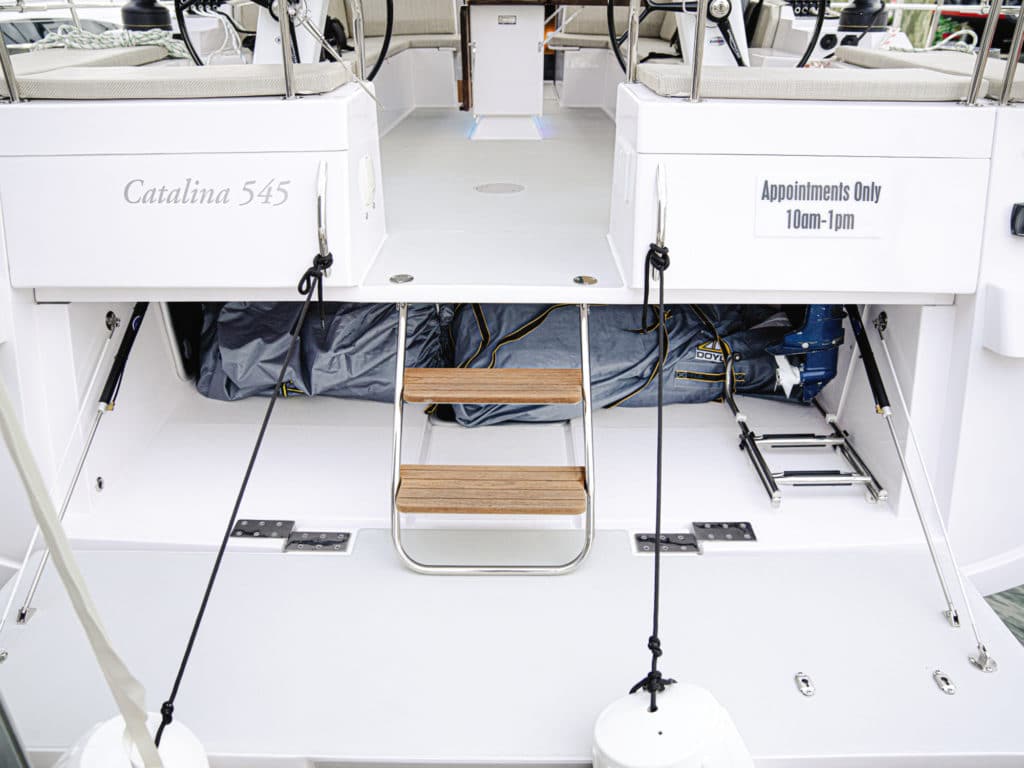
The patent on SCRIMP—perhaps the first widely employed infusion process—has long ago expired, but many builders have adopted it or a similar process whereby layers of fiberglass are placed in the mold dry along with a network of tubes that will carry resin under vacuum pressure to each area of the hull. After careful placement, the entire mold is covered with a bag, a vacuum is drawn by a pump, and lines to the pot of resin are opened. If done correctly, the result is a more uniform fiberglass part with a more controlled glass-to-resin ratio than is achievable with hand lay-up. And as a huge bonus, there are no volatile organic compounds released into the workplace, and no need for expensive exhaust fans and ductwork. OSHA likes that, and so do the workers.
However, sloppy processes and glasswork can still be found on some new boats. Surveyor Jonathan Klopman—who is based in Marblehead, Massachusetts, but has inspected dozens, if not hundreds, of boats damaged by hurricanes in the Caribbean—tells me that he is appalled by some of the shoddy work he sees, such as balsa cores not vacuum-bagged to the fiberglass skins, resulting in delamination. But overall, I believe workmanship has improved, which is evident when you look behind backrests, inside lockers and into bilges, where the tidiness of glasswork (or lack thereof) is often exposed. Mechanical and electrical systems also have improved, in part due to the promulgation of standards by the American Boat & Yacht Council, and informal enforcement by insurance companies and surveyors.
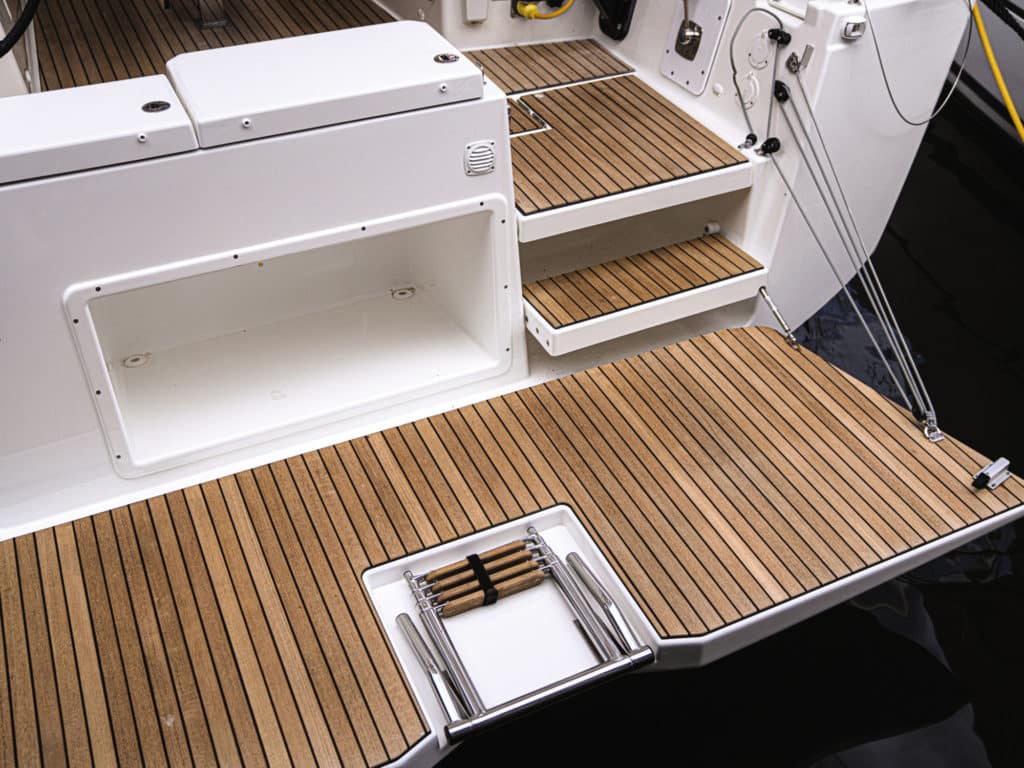
We all know stainless steel isn’t entirely stainless, and that penetrations in the deck are potentially troublesome; allowing moisture to enter a core material, such as end-grain balsa, can have serious consequences. The core and fiberglass skins must be properly bonded and the kerfs not filled with resin. Beginning in the mid-1990s, some builders such as TPI, which built the early Lagoon cruising catamarans, began using structural adhesives, like Plexus, to bond the hull/deck joint rather than using dozens of metal fasteners. These methacrylate resins are now commonly used for this application and others. Klopman says it basically should be considered a permanent bond, that the two parts, in effect, become one. If you think a through-bolted hull/deck joint makes more sense because one could theoretically separate them for repairs, consider how likely that would ever be: not highly.
Fit-and-Finish
Wide transoms spawned an unexpected bonus; besides the possibility of a dinghy “garage” under the cockpit on larger boats, swim platforms are also possible. In more than one BOTY yacht, the aft end of the cockpit rotated down hydraulically to form the swim platform—pretty slick.
Teak decks are still around, despite their spurning for many years by owners who didn’t want the upkeep. In the 1960s and ’70s, they were considered a sign of a classy boat but fell from favor for a variety of reasons: maintenance, weight and threat of damaging the deck core (the bung sealant wears out and water travels down the fastener through the top fiberglass skin into the core). Specialty companies that supply builders, like Teakdecking Systems in Florida, use epoxy resin to bond their product to decks rather than metal fasteners. And the BOTY judges saw several synthetic faux-teak products that are difficult to distinguish from real teak—the Esthec installed on the Bavaria C50 being one example.
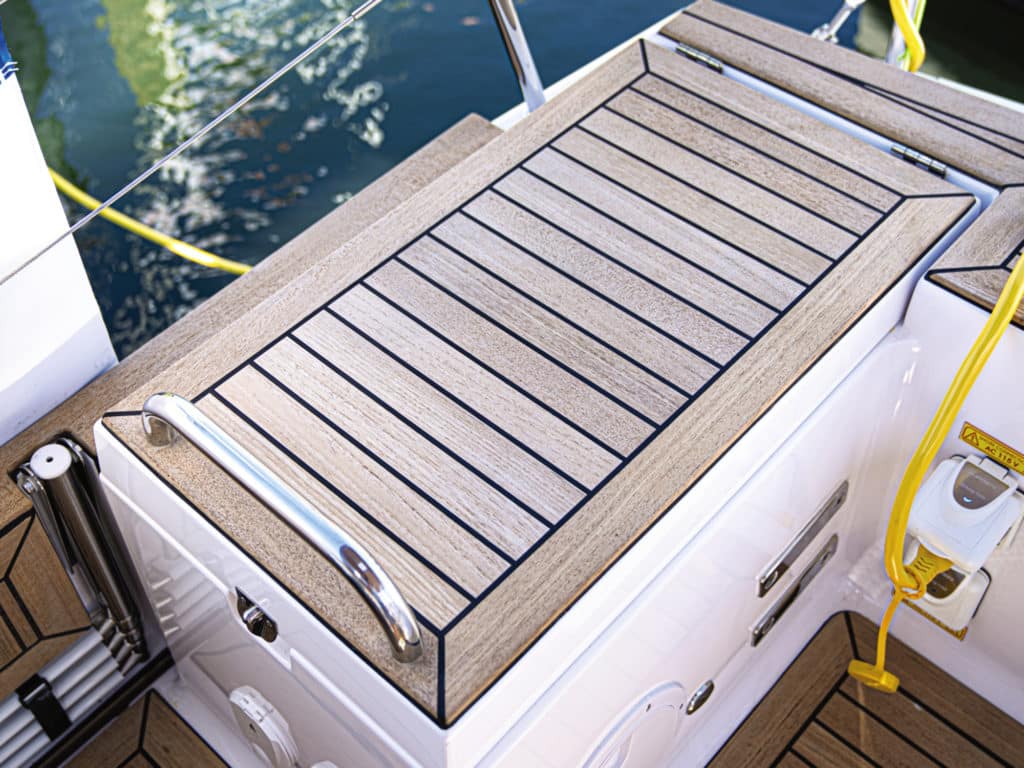
LPG tanks no longer have to be strapped to a stanchion or mounted in a deck box because decks now often incorporate molded lockers specifically designed for one or two tanks of a given size. To meet ABYC standards, they drain overboard. In tandem with these lockers, some boats also have placements or mounts for barbecues that are located out of the wind, obviating the common and exposed stern-rail mount.
Low-voltage LED lights are replacing incandescent bulbs in nearly all applications; improvements in technology have increased brightness (lumens), so some even meet requirements for the range of navigation lights. Advances in battery technology translate to longer life, and depending on type, faster charging. And networked digital switching systems for DC-power distribution also are becoming more common.
Last, I was surprised at how many expensive yachts exhibited at Annapolis had nearly the least-expensive toilets one can buy. Considering the grief caused by small joker valves and poorly sealed hand pumps, one would think builders might install systems that incorporate higher-quality parts or vacuum flushing, and eliminate the minimal hosing that famously permeate odors.
Dan Spurr is an author, editor and cruising sailor who has served on the staffs of Cruising World, Practical Sailor and Professional Boatbuilder. His many books include Heart of Glass , a history of fiberglass boatbuilding and boatbuilders .
Other Design Observations
Here are a few other (surprising) items gleaned from several days of walking the docks and sailing the latest models:
- Multihulls have gained acceptance, though many production models are aimed more at the charter trade than private ownership for solitary cruising. You’d have to have been into boats back in the ’60s and ’70s to remember how skeptical and alarmist the sailing establishment was of two- and three-hull boats: “They’ll capsize and then you’ll drown.” That myth has been roundly debunked. Back then, the only fiberglass-production multihulls were from Europe, many from Prout, which exported a few to the US. There are still plenty of European builders, particularly from France, but South Africa is now a major player in the catamaran market.
- The French builders now own the world market, which of course includes the US. Other than Catalina, few US builders are making a similar impact. In terms of volume, Groupe Beneteau is the largest builder in the world, and they’ve expanded way beyond sailboats into powerboats, runabouts and trawlers.
- Prices seem to have outpaced inflation, perhaps because, like with automobiles, where everyone wants air conditioning, electric windows and automatic transmissions, today’s boats incorporate as standard equipment items that used to be optional. Think hot- and cold-pressure water, pedestal-wheel steering, and full suites of sailing instruments and autopilots.
- More: design , print may 2020 , Sailboats
- More Sailboats

Pre-Owned: 1988 Hylas 47

Catalina Introduces the 6 Series

Sailboat Preview: Elan GT6 Explorer


For Sale: 1984 Camper & Nicholsons 58

Galápagos: A Paradise Worth the Paperwork

Around Alone

Grease the Wheels of Your Boat: A Guide to Proper Lubrication

A Bowsprit Reborn: A DIY Renovation Story
- Digital Edition
- Customer Service
- Privacy Policy
- Terms of Use
- Email Newsletters
- Cruising World
- Sailing World
- Salt Water Sportsman
- Sport Fishing
- Wakeboarding

My Cruiser Life Magazine
Basics of Sailboat Hull Design – EXPLAINED For Owners
There are a lot of different sailboats in the world. In fact, they’ve been making sailboats for thousands of years. And over that time, mankind and naval architects (okay, mostly the naval architects!) have learned a thing or two.
If you’re wondering what makes one sailboat different from another, consider this article a primer. It certainly doesn’t contain everything you’d need to know to build a sailboat, but it gives the novice boater some ideas of what goes on behind the curtain. It will also provide some tips to help you compare different boats on the water, and hopefully, it will guide you towards the sort of boat you could call home one day.
Table of Contents
Displacement hulls, semi displacement hulls, planing hulls, history of sailboat hull design, greater waterline length, distinctive hull shape and fin keel designs, ratios in hull design, the hull truth and nothing but the truth, sail boat hull design faqs.

Basics of Hull Design
When you think about a sailboat hull and how it is built, you might start thinking about the shape of a keel. This has certainly spurred a lot of different designs over the years, but the hull of a sailboat today is designed almost independently of the keel.
In fact, if you look at a particular make and model of sailboat, you’ll notice that the makers often offer it with a variety of keel options. For example, this new Jeanneau Sun Odyssey comes with either a full fin bulb keel, shallow draft bulb fin, or very shallow draft swing keel. Where older long keel designs had the keel included in the hull mold, today’s bolt-on fin keel designs allow the manufacturers more leeway in customizing a yacht to your specifications.
What you’re left with is a hull, and boat hulls take three basic forms.
- Displacement hull
- Semi-displacement hulls
- Planing hulls
Most times, the hull of a sailboat will be a displacement hull. To float, a boat must displace a volume of water equal in weight to that of the yacht. This is Archimedes Principle , and it’s how displacement hulled boats get their name.
The displacement hull sailboat has dominated the Maritimes for thousands of years. It has only been in the last century that other designs have caught on, thanks to advances in engine technologies. In short, sailboats and sail-powered ships are nearly always displacement cruisers because they lack the power to do anything else.
A displacement hull rides low in the water and continuously displaces its weight in water. That means that all of that water must be pushed out of the vessel’s way, and this creates some operating limitations. As it pushes the water, water is built up ahead of the boat in a bow wave. This wave creates a trough along the side of the boat, and the wave goes up again at the stern. The distance between the two waves is a limiting factor because the wave trough between them creates a suction.
This suction pulls the boat down and creates drag as the vessel moves through the water. So in effect, no matter how much power is applied to a displacement hulled vessel, it cannot go faster than a certain speed. That speed is referred to as the hull speed, and it’s a factor of a boat’s length and width.
For an average 38 foot sailboat, the hull speed is around 8.3 knots. This is why shipping companies competed to have the fastest ship for many years by building larger and larger ships.
While they might sound old-school and boring, displacement hulls are very efficient because they require very little power—and therefore very little fuel—to get them up to hull speed. This is one reason enormous container ships operate so efficiently.
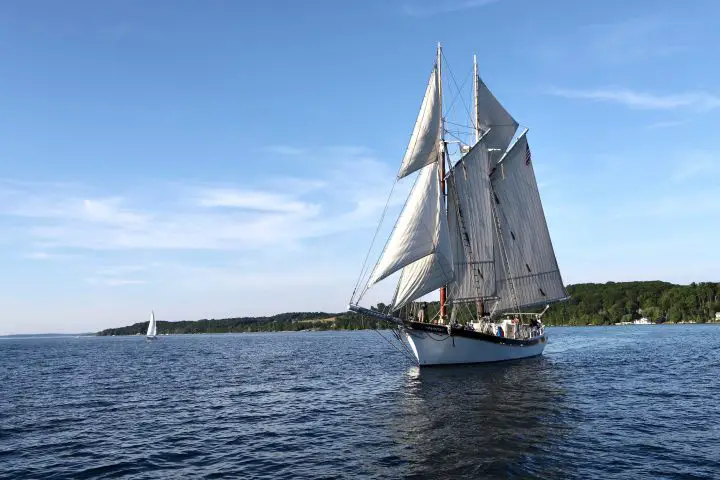
Of course, living in the 21st century, you undoubtedly have seen boats go faster than their hull speed. Going faster is simply a matter of defeating the bow wave in one way or another.
One way is to build the boat so that it can step up onto and ride the bow wave like a surfer. This is basically what a semi-displacement hull does. With enough power, this type of boat can surf its bow wave, break the suction it creates and beat its displacement hull speed.
With even more power, a boat can leave its bow wave in the dust and zoom past it. This requires the boat’s bottom to channel water away and sit on the surface. Once it is out of the water, any speed is achievable with enough power.
But it takes enormous amounts of power to get a boat on plane, so planing hulls are hardly efficient. But they are fast. Speedboats are planing hulls, so if you require speed, go ahead and research the cost of a speedboat .
The most stable and forgiving planing hull designs have a deep v hull. A very shallow draft, flat bottomed boat can plane too, but it provides an unforgiving and rough ride in any sort of chop.
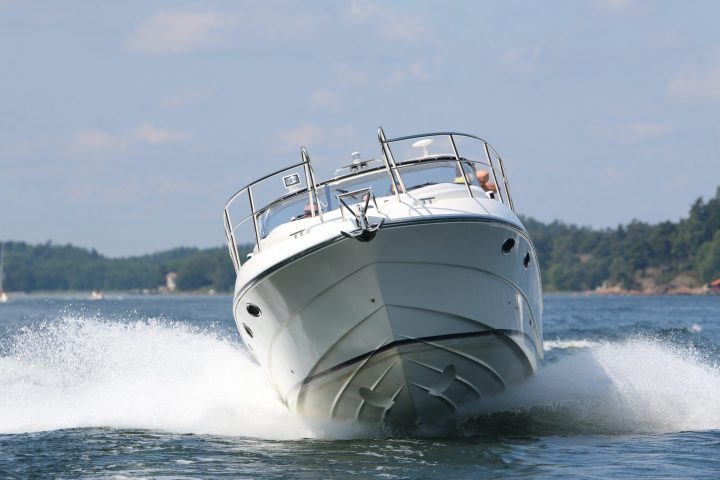
If you compare the shapes of the sailboats of today with the cruising boat designs of the 1960s and 70s, you’ll notice that quite a lot has changed in the last 50-plus years. Of course, the old designs are still popular among sailors, but it’s not easy to find a boat like that being built today.
Today’s boats are sleeker. They have wide transoms and flat bottoms. They’re more likely to support fin keels and spade rudders. Rigs have also changed, with the fractional sloop being the preferred setup for most modern production boats.
Why have boats changed so much? And why did boats look so different back then?
One reason was the racing standards of the day. Boats in the 1960s were built to the IOR (International Offshore Rule). Since many owners raced their boats, the IOR handicaps standardized things to make fair play between different makes and models on the racecourse.
The IOR rule book was dense and complicated. But as manufacturers started building yachts, or as they looked at the competition and tried to do better, they all took a basic form. The IOR rule wasn’t the only one around . There were also the Universal Rule, International Rule, Yacht Racing Association Rul, Bermuda Rule, and a slew of others.
Part of this similarity was the rule, and part of it was simply the collective knowledge and tradition of yacht building. But at that time, there was much less distance between the yachts you could buy from the manufacturers and those setting off on long-distance races.
Today, those wishing to compete in serious racing a building boat’s purpose-built for the task. As a result, one-design racing is now more popular. And similarly, pleasure boats designed for leisurely coastal and offshore hops are likewise built for the task at hand. No longer are the lines blurred between the two, and no longer are one set of sailors “making do” with the requirements set by the other set.
Modern Features of Sailboat Hull Design
So, what exactly sets today’s cruising and liveaboard boats apart from those built-in decades past?
Today’s designs usually feature plumb bows and the maximum beam carried to the aft end. The broad transom allows for a walk-through swim platform and sometimes even storage for the dinghy in a “garage.”
The other significant advantage of this layout is that it maximizes waterline length, which makes a faster boat. Unfortunately, while the boats of yesteryear might have had lovely graceful overhangs, their waterline lengths are generally no match for newer boats.
The wide beam carried aft also provides an enormous amount of living space. The surface area of modern cockpits is nothing short of astounding when it comes to living and entertaining.
If you look at the hull lines or can catch a glimpse of these boats out of the water, you’ll notice their underwater profiles are radically different too. It’s hard to find a full keel design boat today. Instead, fin keels dominate, along with high aspect ratio spade rudders.
The flat bottom boats of today mean a more stable boat that rides flatter. These boats can really move without heeling over like past designs. Additionally, their designs make it possible in some cases for these boats to surf their bow waves, meaning that with enough power, they can easily achieve and sometimes exceed—at least for short bursts—their hull speeds. Many of these features have been found on race boats for decades.
There are downsides to these designs, of course. The flat bottom boats often tend to pound when sailing upwind , but most sailors like the extra speed when heading downwind.
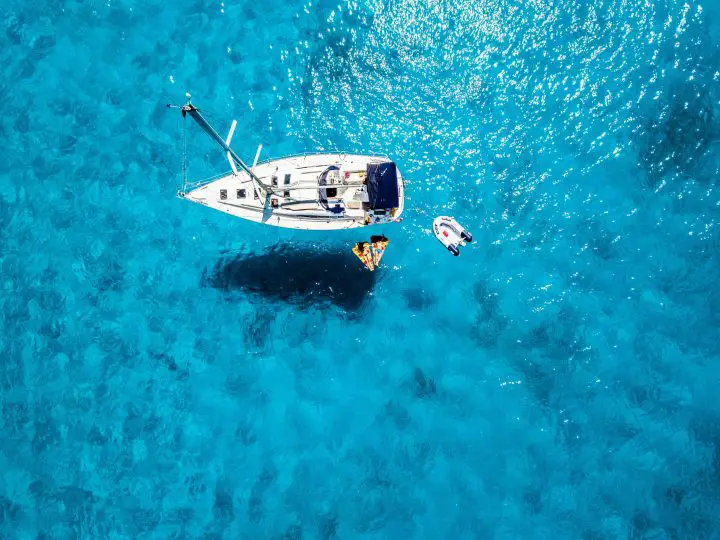
How Do You Make a Stable Hull
Ultimately, the job of a sailboat hull is to keep the boat afloat and create stability. These are the fundamentals of a seaworthy vessel.
There are two types of stability that a design addresses . The first is the initial stability, which is how resistant to heeling the design is. For example, compare a classic, narrow-beamed monohull and a wide catamaran for a moment. The monohull has very little initial stability because it heels over in even light winds. That doesn’t mean it tips over, but it is relatively easy to make heel.
A catamaran, on the other hand, has very high initial stability. It resists the heel and remains level. Designers call this type of stability form stability.
There is also secondary stability, or ultimate stability. This is how resistant the boat is to a total capsize. Monohull sailboats have an immense amount of ballast low in their keels, which means they have very high ultimate stability. A narrow monohull has low form stability but very high ultimate stability. A sailor would likely describe this boat as “tender,” but they would never doubt its ability to right itself after a knock-down or capsize.
On the other hand, the catamaran has extremely high form stability, but once the boat heels, it has little ultimate stability. In other words, beyond a certain point, there is nothing to prevent it from capsizing.
Both catamarans and modern monohulls’ hull shapes use their beams to reduce the amount of ballast and weight . A lighter boat can sail fast, but to make it more stable, naval architects increase the beam to increase the form stability.
If you’d like to know more about how stable a hull is, you’ll want to learn about the Gz Curve , which is the mathematical calculation you can make based on a hull’s form and ultimate stabilities.
How does a lowly sailor make heads or tails out of this? You don’t have to be a naval architect when comparing different designs to understand the basics. Two ratios can help you predict how stable a design will be .
The first is the displacement to length ratio . The formula to calculate it is D / (0.01L)^3 , where D is displacement in tons and L is waterline length in feet. But most sailboat specifications, like those found on sailboatdata.com , list the D/L Ratio.
This ratio helps understand how heavy a boat is for its length. Heavier boats must move more water to make way, so a heavy boat is more likely to be slower. But, for the ocean-going cruiser, a heavy boat means a stable boat that requires much force to jostle or toss about. A light displacement boat might pound in a seaway, and a heavy one is likely to provide a softer ride.
The second ratio of interest is the sail area to displacement ratio. To calculate, take SA / (D)^0.67 , where SA is the sail area in square feet and D is displacement in cubic feet. Again, many online sites provide the ratio calculated for specific makes and models.
This ratio tells you how much power a boat has. A lower ratio means that the boat doesn’t have much power to move its weight, while a bigger number means it has more “get up and go.” Of course, if you really want to sail fast, you’d want the boat to have a low displacement/length and a high sail area/displacement.
Multihull Sailboat Hulls
Multihull sailboats are more popular than ever before. While many people quote catamaran speed as their primary interest, the fact is that multihulls have a lot to offer cruising and traveling boaters. These vessels are not limited to coastal cruising, as was once believed. Most sizable cats and trimarans are ocean certified.
Both catamarans and trimaran hull designs allow for fast sailing. Their wide beam allows them to sail flat while having extreme form stability.
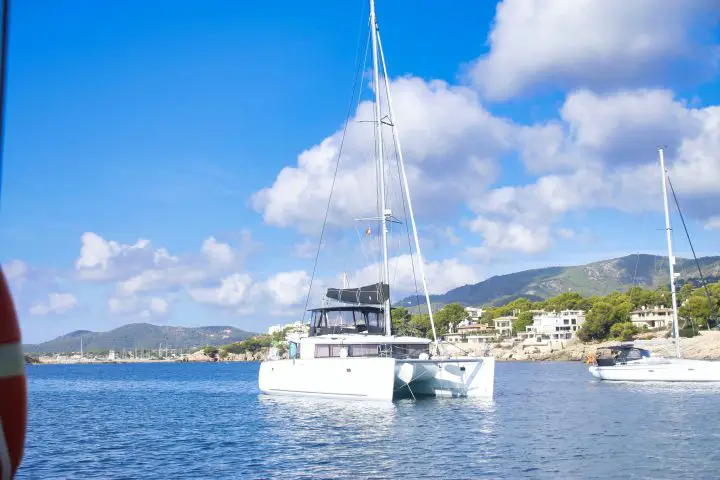
Catamarans have two hulls connected by a large bridge deck. The best part for cruisers is that their big surface area is full of living space. The bridge deck usually features large, open cockpits with connecting salons. Wrap around windows let in tons of light and fresh air.
Trimarans are basically monohulls with an outrigger hull on each side. Their designs are generally less spacious than catamarans, but they sail even faster. In addition, the outer hulls eliminate the need for heavy ballast, significantly reducing the wetted area of the hulls.
Boaters and cruising sailors don’t need to be experts in yacht design, but having a rough understanding of the basics can help you pick the right boat. Boat design is a series of compromises, and knowing the ones that designers and builders take will help you understand what the boat is for and how it should be used.
What is the most efficient boat hull design?
The most efficient hull design is the displacement hull. This type of boat sits low in the water and pushes the water out of its way. It is limited to its designed hull speed, a factor of its length. But cruising at hull speed or less requires very little energy and can be done very efficiently.
By way of example, most sailboats have very small engines. A typical 40-foot sailboat has a 50 horsepower motor that burns around one gallon of diesel every hour. In contrast, a 40-foot planing speedboat may have 1,000 horsepower (or more). Its multiple motors would likely be consuming more than 100 gallons per hour (or more). Using these rough numbers, the sailboat achieves about 8 miles per gallon, while the speedboat gets around 2 mpg.
What are sail boat hulls made of?
Nearly all modern sailboats are made of fiberglass.
Traditionally, boats were made of wood, and many traditional vessels still are today. There are also metal boats made of steel or aluminum, but these designs are less common. Metal boats are more common in expedition yachts or those used in high-latitude sailing.
Matt has been boating around Florida for over 25 years in everything from small powerboats to large cruising catamarans. He currently lives aboard a 38-foot Cabo Rico sailboat with his wife Lucy and adventure dog Chelsea. Together, they cruise between winters in The Bahamas and summers in the Chesapeake Bay.
Sailboating: How This Agile Activity Can Help You Spark Innovation
UI/UX Design

Working Agile
When developing a digital product, the classic process involved documenting requirements, designing solutions, and building and testing in a waterfall approach. Then Agile came around and changed everything, decreasing the time it took to deliver working software and reducing the need for front-loaded documentation.
By working in ‘sprints’, development teams can focus on core requirements to build a product, while allowing for the ups and downs that come with developing complex technology. An added bonus is that clients can deliver feedback after sprints rather than at the end of the ‘completed’ project.
Agile is a system of working, but it’s also a mindset based on promoting better interaction between the people involved in the project, the flexibility to change things when required, and focusing on working, functional product over bureaucracy. It’s a flexible way of working - hence the name ‘agile’, but it also encourages the concept of taking stock after a sprint to see what worked and what didn’t.
This is often called an Agile retrospective. These are exercises performed after a sprint or project to determine efficiency and spot problems or issues so a team can avoid them in the future. It also ties into a Lean methodology in that a retrospective helps cut future waste.
One of the most powerful forms of retrospectives comes in the form of the ‘sailboat exercise’.
What is the Agile Sailboat?
If you’re planning to work in an Agile system, or working with an agency that utilises Agile methodology (hint hint, it’s us), then you’ll probably encounter the term sailboating.
Even if you’re NOT an agile organisation, the sailboating exercise can still be a great way to help rethink your projects and prioritise the production journey. It’s a visual metaphor and an exercise that focuses on the team and future direction.
A sailboat workshop involves two main processes: the team writing down answers to a few questions and then mapping these answers against the ‘sailboat’ metaphor.
You can use a digital board such as Miro for this, or Sticky notes will do the trick if you’re doing it in person. Ask your team the following questions (adjusting based on whether you’re running this as a sprint exercise or at an operational level.)
At operational level:
What’s moving us forward?
What are our goals?
What’s holding us back?
What’s not gone so well?
For sprint exercises:
What risks did the sprint/project face?
What delayed the sprint?
What propelled the sprint forward?

The Sailboat in action at a KOMODO Innovation Workshop.
Once your team have created their answers as Sticky Notes, ask them to stick them to a graphic you’ve drawn or printed that includes the following elements:
A boat - this is your team/project.
An island - this is the goal you’re working towards. It can be the specific features designed in a sprint or a more operational-level goal.
Wind in your sails : what propels your team/project forward.
Rocks : the risks your project faces in the future as it reaches the goal.
Anchor : the problems and challenges which delayed the sprint/project.
Once the team has had a chance to place their sticky notes, go through as a group and see if you agree on the placements. Then see if there’s a common theme being suggested by multiple people as a delay.
Just like you would in an Agile sprint, you can use this information to pivot and enact change. For example, if there’s an anchor problem holding your team back, prioritise a way to remove it. Outlining the ‘rock’ or future risk also helps you spot potential obstacles that should be dealt with before they become a problem and ‘sink’ the ship.
The sailboat exercise is great because it’s a visual metaphor that is easy to understand. It aligns the team and quite literally puts everyone in the same boat. For an agency/client relationship, sailboating also helps both sides of the relationship feel they are aligned and heading in the right direction.
While the Sailboat method is so often used in a retrospective fashion, we believe it has great value as an onboarding process for new projects and why it features as the first activity in our innovation workshop process.
Sailboat as a prospective tool
The sailboat system can also be used at the beginning of a project to help map out your strengths and weaknesses.
Demand for your product.
What your user’s needs are.
What solutions are most important in terms of priority.
We’ve written about this sort of thinking many times - but it’s so important we thought we’d mention it again here in the context of the Sailboat exercise. You can’t, for example, just go into a planning session with ‘general ideas’ of what your customers want. Instead, you need to do research and ensure that your product can solve a genuine need . Otherwise, it’s all based on guesswork.

Once you know enough about your users, you can use Sailboat to plan the overall product or project. This time, you’d define the elements as:
Rocks : what risks does the product face in terms of competitors, technical issues, user error?
Island : what functional requirements are most important - they should be positioned closer to the ‘shore’ to create priorities.
Anchor : what issues could delay the project. Think of factors like stakeholder intervention, poor client/agency communication etc.
Wind/sail: what can contribute towards the product being completed to the right timeframe?
While you might not have the same retrospective analysis to assign actual, tangible things that went wrong for your rocks etc. The sailboat is still a good way to map out a project at the beginning to get your team on the same page.
Remember that the sailboat as a concept is not really that important. It could be many different visual metaphors - all of them just have to share a way to map goals, threats and success factors.
By completing these exercises either at the start of a project or as a retroactive after a sprint as intended, you’ll be putting your team on the right track and creating a more collaborative process both internally and, if working with an agency, externally too.
The sailboat is just one Agile exercise we love. If you choose to work with KOMODO for your digital product development, we’ll lend our workshopping expertise to your project journey to help ensure the product is as functional and successful as it can be. Get in touch if you’d like to know more .
Got an idea? Let us know.
Discover how Komodo Digital can turn your concept into reality. Contact us today to explore the possibilities and unleash the potential of your idea.
Get in touch
Sign up to our newsletter
Be the first to hear about our events, industry insights and what’s going on at Komodo. We promise we’ll respect your inbox and only send you stuff we’d actually read ourselves.
Latest articles

Life at Komodo
Komodo Digital Hosts Buzzing FinTech Social in Partnership with FinTech North

A Complete Guide to Creating a Design System That Works in 2024

Web Development
9 Reasons Why React is Still Popular in 2024
Some of our case studies.

A Robust Data-Heavy Platform For Just-In-Time Print Logistics

Building with Nature
Agile software development for cutting-edge lawtech startup.

App Development
Cross-Platform Mobile App for Gathering Clinical Trials Feedback

Business Design Tools
Sailboat Canvas
This canvas was inspired by a tool described in Alex Osterwalder’s Value Proposition Design book. We’ve had amazing success deploying this to teams in order to develop a strong foundation for strategic planning. It’s a really simple and versatile tool which allows you to clearly display the forces that are acting on you, your team, or organization. So you know what direction you are heading, right? Well, what’s helping you get there and what’s holding you back? It’s that simple! Yet, so powerful when used as a team alignment tool.
This version designed by Matt Kelly and licensed to Do Tank Do LLC.
What is helping to push you forward? What are the positive forces that you would want to amplify and leverage in your strategy?
What is holding you back? What are the obstacles that stand in your way? What must you navigate and overcome going forward?
5 Effective ways to use the tool
Personal self reflection.
Call the boat the “<I NSERT YOUR NAME>” . In your own time and space, use this canvas to think about you own personal situation. What are you currently looking to achieve? What are the things that are driving you to success? What’s holding you back? When reflecting, challenge yourself with these questions; Is your direction clear enough? Does it excite you? What enablers can be amplified? What else could help enable your vision? What’s the number 1 blocker that is slow you down? What options do you have to remove it? If you were going to change 3 things to you current situation what would they be?
Call the boat the “<INSERT YOUR NAME>”. Like most of the business design tools, you maximize the value when using them as part of a team sport. It’s simply an amazing tool for teams to conduct a quick “current state” exercise to help identify hidden challenges or provide the climate that enables conversations about known challenges. Consider the “so what?” question when doing this exercise as a team. Make sure that there is general alignment on the current state and where possible agree as a team the top 3 areas that should be worked on to help the team achieve its vision.
Your Business
Call the boat the “<INSERT YOUR BUSINESS NAME>”. You can see where this is going, right? You can essentially call the boat anything you like as long as it’s something you care about that has a purpose and it’s on a journey to realize its vision. For example doing this at the business level within workshops that have multiple teams is a great way to extract different points of view from across the business. It’s also interesting to see where solid alignment exists and where it doesn’t.
Partnerships
Call the boat the “<INSERT PARTNERSHIP NAME>”. This can be a powerful way to either assess of design partnerships with the actual people involved in the partnership. What better way to assess and/or design than co-create it together. Instant buy-in.
Service or Program
Call the boat the “<INSERT SERVICE OR PROGRAM>”. This could provide a way to slice across parts of the business when focused on a product or service. Let’s assess the current state of a product/service with everyone that’s involved, from R&D, support, sales, marketing, operations, finance etc to really understand what is working and what is not if we seek to turbo charge the performance. This provides a good foundation for value proposition design as well as business model innovation.
Name the boat
It seems simple, but putting a name to the boat gives it personality and a sense of purpose. Make sure the FIRST thing you do it agree on the name of the boat and then the purpose it has.
Extend the metaphor
The theme of a “sailboat” lends itself to so many metaphors. What are the lighthouses that are keeping your idea from smashing on the rocks? What is the main heavy anchor that’s stopping you from moving? Are there sharks in the water? Warm currents to play towards etc. There is enough whitespace on the canvas to play with this in a fun but serious way.
Select your top 2s
Because of it’s simplicity, this canvas can get full fast. Once you’ve filled it up with thoughts, go through them all again and pick the top 2 enablers and the top 2 blockers. Focus your efforts on those and you’ll soon find you’re making waves.
The deeper the anchor, the greater the drag
A good visualization for blockers is to have “anchors” at various depths. The deeper the anchor, the more impact it’s having on the subject and the higher a priority it should be.
Good to warm up
This can be a quick exercise. It’s fun and easy to explain, so it makes a great warm-up activity to break the ice at a team meeting or event.
You’ll need an account to access the download
Already have an account, create an account, more great tools.

Empathy Map

Value Proposition Designer
Produced by Do Tank

Username Password Remember Me Forgot Password
Human-Centered Change Management in Healthcare & Pharmaceutics
Are you a part of Healthcare or Pharma organization? If the answer is yes, we are here to offer you support in fields like:
- Managing a strategic change
- Creating compelling stories
- Facilitating creative experiences
- Strategical planning
- Enhancing competency in quality
- Achieving better outcomes
- Boosting internal partnerships
and many more. Regardless of the field, our goal is to create deep engagement, understanding, and alignment!

- New Sailboats
- Sailboats 21-30ft
- Sailboats 31-35ft
- Sailboats 36-40ft
- Sailboats Over 40ft
- Sailboats Under 21feet
- used_sailboats
- Apps and Computer Programs
- Communications
- Fishfinders
- Handheld Electronics
- Plotters MFDS Rradar
- Wind, Speed & Depth Instruments
- Anchoring Mooring
- Running Rigging
- Sails Canvas
- Standing Rigging
- Diesel Engines
- Off Grid Energy
- Cleaning Waxing
- DIY Projects
- Repair, Tools & Materials
- Spare Parts
- Tools & Gadgets
- Cabin Comfort
- Ventilation
- Footwear Apparel
- Foul Weather Gear
- Mailport & PS Advisor
- Inside Practical Sailor Blog
- Activate My Web Access
- Reset Password
- Customer Service

- Free Newsletter

Blue Jacket 40 Used Boat Review

Catalina 270 vs. The Beneteau First 265 Used Boat Match-Up

Ericson 41 Used Boat Review

Mason 33 Used Boat Review

How to Create a Bullet-Proof VHF/SSB Backup

Tips From A First “Sail” on the ICW

Tillerpilot Tips and Safety Cautions

Best Crimpers and Strippers for Fixing Marine Electrical Connectors

Polyester vs. Nylon Rode

Getting the Most Out of Older Sails

How (Not) to Tie Your Boat to a Dock

Stopping Mainsheet Twist

Fuel Lift Pump: Easy DIY Diesel Fuel System Diagnostic and Repair

Ensuring Safe Shorepower

Sinking? Check Your Stuffing Box

What Do You Do With Old Fiberglass Boats?

Boat Repairs for the Technically Illiterate

Boat Maintenance for the Technically Illiterate

Whats the Best Way to Restore Clear Plastic Windows?

Stopping Holding-tank Odors

Giving Bugs the Big Goodbye

Galley Gadgets for the Cruising Sailor

The Rain Catcher’s Guide

Sailing Gear for Kids

What’s the Best Sunscreen?

UV Clothing: Is It Worth the Hype?

Preparing Yourself for Solo Sailing

R. Tucker Thompson Tall Ship Youth Voyage

On Watch: This 60-Year-Old Hinckley Pilot 35 is Also a Working…

On Watch: America’s Cup

On Watch: All Eyes on Europe Sail Racing

Dear Readers
- Sailboat Reviews
Practical Sailor Takes a Look at Trends in Modern Boat Design
Is the quest for speed and interior comfort trumping smart design in todays sailboats.
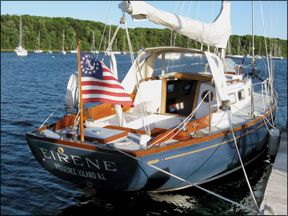
Practical Sailor editors have noticed the increasing tendency in newer-model sailboats to be ill-mannered in gusty conditions. Establishing balance between the sails and the hull is one of the main factors in quality boat design. For correct trim, many things must be considered: the ballast package location, the combined longitudinal center of gravity (LCG), and the longitudinal center of buoyancy. At the same time, to maintain a balanced helm, the keel must promote sufficient lead (the fore and aft distance between the center of effort and the center of lateral resistance). To highlight how these boat design principles play out, Practical Sailor looks at classic sailboats such as the Bill Shaw-designed Pearson 32, Ericson 41, Valiant 40, and Peterson 44, and compares their keel/sail ratios and lead values to more modern sailboat designs such as the Catalina, Hunter, Tartan, and Beneteau.
In the course of taking out boats for testing, Practical Sailor editors have observed an increased tendency for new-model sailboats to be ill-mannered in gusty conditions. We have been watching this trend for several years, and it seems to be becoming more usual than unusual.
In a typical situation, we will be sailing the test boat on the wind in 12 or so knots of breeze and everything is fine. Then, the breeze picks up to about 15 knots and the helm loads up. OK, thats to be expected, so we flatten the main, drop down the traveler, and that takes care of it.
Then we get a puff. Were already on the point of needing to reef, so in the puff, were overcanvassed. Instead of just heeling farther, the boat begins to round up. Fighting it with the helm is hard work, and easing the main so it luffs doesn’t help much.

Photo by Ralph Naranjo
We take in a reef, which usually means we roll in a bit of the jib or a bit of the main, or both, and the helm lightens up. We trim to the new wind and sail along, a bit slower now in the light spots, but then the next gust comes along, and the helm immediately loads up again.
In the worst case weve experienced, the boat rounded up so quickly that it tacked, even though the helm was hard over in the opposite direction. To prove that wasnt a fluke caused by a temporary diversion into a parallel universe, it did the same thing on the other tack.
Practical Sailor editors are old enough to remember a generation of cruising boats that didnt behave in this manner. For sure, there have always been twitchy boats, but most, when hit by a gust, would heel a little more, put some pressure on the wheel or tiller, and once the boat picked up speed, the pressure would come right off. A boat like that will sail for a long time with a loose lashing on the helm.
So, where does this bad habit come from? Several trends in modern cruising yacht design can share the blame. One of them is builders inclination to tilt their designs toward the performance end of the cruisers spectrum. Many recent and current cruising boats, if suitably fitted out with racing sails and the hardware and software to tweak them, could put up an impressive show on the race course.
The sensitivity to trim that accompanies such potential isn’t always suited to cruising shorthanded or with a family, when balance and good manners are key both to enjoyment and, to a degree, safety.
Establishing Balance
Many factors contribute to the balance of a sailboat. The obvious and principal pair are the sails and the hull. When working up a new design, the architect develops these in close association, but both are in turn influenced by other aspects of the boats design as it evolves.
In the standard approach, the designer works up preliminary drawings to express the basic requirements of the design brief, which normally include a desired length, displacement, cabin arrangement, and sailplan to provide the desired performance.
He then sketches out the hull lines (the matrix of contours that define its three-dimensional shape and its volume) to enclose the interior and meet expressed performance goals. The preliminary lines also serve as a basis on which to perform a number of calculations, one of them being the location of the center of buoyancy (CB).
With everything roughed out, the designer then “weighs” every item that will go into the complete boat, from the hull laminate to the toothbrush holder, but excluding the ballast. He combines these weights and their locations on the three axes, X, Y, and Z, to calculate the center of gravity (CG) of the whole package. Computer programs have helped to speed up this process and make volume calculations more accurate, but the process hasn’t changed much.
For the boat to float on its desired lines, the ballast package must then be designed and located to bring the combined longitudinal CG (LCG) of hull and ballast to the same fore-and-aft location as the CB (LCB). Once everything has been resolved satisfactorily, the designer can finalize the lines, carry out the necessary calculations, and establish shape and locations for the keel and the sailplan.
On most boats of current design, the ballast also constitutes the fin keel, and in that role, its location determines the center of lateral resistance (CLR), which in conjunction with the center of effort (CE) of the sailplan, influences how the boat balances under sail.
Even as boat design procedures have evolved from three-dimensional modeling using half hulls, through two-dimensional modeling using pen on vellum, to three-dimensional virtual modeling on computers, the fundamental principles have remained constant. One of the fundamental values used for predicting the proclivities of a boats helm is the dimension termed “lead.” Lead, pronounced “leed,” is the fore and aft distance between the CE and the CLR, expressed as a percentage of the waterline length (DWL).
“Skenes Elements of Yacht Design,” as revised by Francis S. Kinney, and other references for yacht design provide rules of thumb for calculating lead from the sailplan and the hull profile. (See illustration above).
Looking at the diagram, its easy to see how lead is an elusive quantity. First of all, no boat sails with the sailplan as shown-the sails are never flat and on centerline. The traditional range for lead places the CE forward of the CLR by 14 to 19 percent of DWL. This value is lifted from “Skenes,” for years the first reference for any designer. Since that book was written and updated, hull forms have changed, and with them, optimum values for lead.
On designs with fin keels, lead is often calculated with reference to the keel alone. One feature remains constant whatever the design. Moving the centers closer together-reducing lead-increases the tendency to weather helm. Moving them apart reduces that tendency. If the lead is too great, the result may be lee helm, which is generally considered undesirable-and is in fact, rare.
In Kinneys prime years, the 1960s to the 1980s, the basic working sailplan of a sloop included a 150-percent genoa, which would have the effect of moving the CE closer to the CLR. Many designs today have headsails with short or even no overlap and very often a full-battened mainsail with lots of roach. The different aerodynamic characteristics of such rigs might well affect optimum lead, something which designers can only determine through experience. (If a boatbuilder offers an in-mast furling mainsail as an option, its effect on lead will differ from that of the “classic” sailboat.)
The effective CLR can also be very different from that calculated. On a deep-bodied, full-keel hull, that difference simply might be the difference between the geometric center and the center of hydrodynamic pressure of the whole profile.
A sharp bow with a pronounced “chin” might well move the effective CLR forward. On a modern, fin-keeled boat with a shallow, broad canoe body like that of a dinghy, the keel makes a proportionately larger contribution to lateral resistance, so the location of the keel will strongly influence where that resistance operates.
Obviously the rudder, too, is part of the lateral plane, but if our objective is to sail with light to neutral pressure on the helm, under normal conditions, it should not be making a significant contribution to lateral resistance. Its role is to provide a means to change the boats direction and to compensate for the constant fluctuations in the forces applied to the boat in the normal course of sailing. A certain amount of pressure in the form of weather helm helps by providing positive feedback to the helmsman on the state of balance. That said, on many racing hulls, the rudder is designed to contribute lift and has an active role in driving the boat to windward. (It is worth noting that those wide-bodied race boats also tend to have twin rudders.)
Then and Now
Even in the age of computer modeling, yacht design remains a series of compromises. At the moment, it seems the pendulum has swung to a point where high-volume, wide-beam shapes dominate. With them come large rigs to overcome skin drag and its negative effect in light air. As a result, theres a need to sail the vessel as flat as possible or suffer the consequences.
The sailplan and outboard profiles of boats from different eras represent the shift in yacht design that has occurred during recent decades. The modern boats have longer proportional waterlines, indicating higher potential speed. It also means that the boats immersed volume, or displacement, has been distributed over a greater length.
Given two boats of similar displacement like the classic Pearson 32 and the modern Tartan 3400 (above), the Tartan winds up with a shallower canoe body. This also contributes to its being potentially faster and, if both boats had the same draft, would give the keel a slight advantage in span, and therefore effectiveness to windward.
So far so good, but a shallower canoe body forces the cabin sole upward, especially if the belowdecks accommodations are to take full advantage of the wide beam favored in the modern hull. To achieve comparable headroom with its older counterpart, the cabintop has to go up, too, and to ensure sitting headroom on the settees under the sidedeck, so does the freeboard.
Ultimately, the whole deck moves upward. To ensure the boom doesn’t sweep everybody out of the cockpit during an unplanned jibe, the boom too goes up. If sail area is not to be compromised, the entire mainsail goes up, and with it, its center of effort. The bigger the boat, the less pronounced these differences become as the proportions become more relaxed.
Differences are visible, too, between the boats keels; the modern Tartans is smaller in area. While it might be claimed that less wetted surface promises higher sailing speeds in light air, some builders accept a smaller keel to simplify the manufacture of the hull.
In a perfect world, the designer draws a keel to suit the boats sail area and other characteristics, places it to obtain the desired sailing performance, then massages the needed ballast to both fit the keel and trim the boat correctly. The volume of the ballast is usually less than that of the keel, and the builder has to do some intricate laminating work to mold a keel to receive ballast internally or a stub to which to bolt it externally.
On many production boats today, the keels are bolted directly to the bottom of a fair canoe body, a practice which eliminates much labor. The consequence is that the area of the keel is determined by the weight, and therefore the volume, of the ballast. To achieve the desired hydrodynamic properties and mechanical strength-it mustnt bend under the influence of normal sailing loads-a given volume of ballast can be formed into a limited range of shapes. Placing ballast in a bulb at the bottom aids the keels efficiency by creating an endplate effect and raises stiffness by placing ballast low, but it means that the keels lateral plane is sharply reduced.
For a more dramatic representation of how changes in keel design can affect helm balance, compare a Cruising Club of America (CCA) design like the Ericson 41 above, to a modern equivalent with comparable sail area like the Beneteau 46.
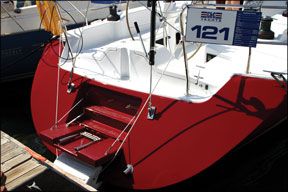
When sailing, two boats are subjected to similar forces on the sails. Resisting that side force are the immersed hull, the keel, and the rudder. If the hulls offer similar resistance, the remaining force is shared between the keel and rudder. If one keel is smaller than the other (as is clearly the case here), the effect is to increase the share taken by the rudder.
When the sails are trimmed properly and all is in balance, the rudder will carry a small load. If however, you hit a gust, the rudder must pick up a high proportion of the added side thrust until balance is restored, usually by some adjustment to sail trim.
Simply put, boats of the general modern type are not forgiving in changeable conditions, say, for example when the apparent wind is in the 12- to 18-knot range. At the higher end, youd want to be reefed; at the lower end, probably not.
On a day when you expect the wind to soften rather than harden, youd rather not put in the reef, so that you can maintain speed in the lulls. In the puffs, you want your hands free to ease the traveler and flatten the jib, which is hard to do if the helm is a handful. Compounding the problem on most boats, the mainsail controls are usually not within reach of the helm.
On racing boats, such sensitivity isn’t an issue. On the contrary, sufficient crew are on hand to make adjustments on the fly as quickly and often as needed to keep the boat sailing at her fastest.
Cruising boats are often sailed shorthanded and by crews who are not looking for a constant physical workout. An autopilot might be doing most of the steering, and good balance is helpful in protecting it from having to work too hard-or from being overpowered.
Another striking difference between the older and newer designs is visible in the plan (overhead) view. By 1980, cruising-boat hulls were already becoming beamy relative to boats of the 1960s and 1970s. The current trend is to carry the beam aft, so that in the region of the rudder, its as much as 85 percent of the maximum beam, far wider than the 55 percent to 60 percent once considered acceptable. The principal beneficiary of this extra breadth is the boats interior-builders often offer twin double cabins aft where a generation ago they might have squeezed in a quarter berth and a cockpit locker. The cockpit, too, becomes roomier, and the transom, scooped and sculpted, is transformed into a swim platform and dinghy dock.

Photo by Jarrod Scanlon
All this additional boat aft adds weight aft, in both construction materials and outfit. To compensate, the ballast-that is to say, the keel-has to be fitted farther forward.
The full beam aft does provide a significant boost to the boats ability to carry sail. As the boat heels, the center of buoyancy moves quickly outboard, away from the center of gravity. This lengthens the righting arm, giving a positive contribution toward stability, but it also moves the immersed centerline of the hull away from the static centerline along which both the keel and the rudder are attached. Depending on the hulls shape, this can create a distortion in the immersed volume, which can in turn affect the dynamics acting on it.
Effect of Keel Area
Another factor entering the equation is the area of the keel. This, too, is apparent when comparing the drawings of the older and newer generation boats. Many of the standard tracts on the design of sailing yachts are, lets say, vague on what keel area is adequate or even desirable, although many designers have come up with their own formulas.
Because the keel is reacting in the water to forces generated on the sails by the wind, it makes sense that the area of a fin keel should be related in some way to sail area.
When naval architect Dave Gerr took over as director of the Westlawn Institute of Marine Technology, he found the course materials for sailing yacht design had little detailed explanation on this topic, a gap he subsequently filled. Briefly, he recommends no fin keel should be less that 2.5 percent of the sail area (mainsail 100 percent foretriangle) and need be no more than 5 percent. The smaller value is appropriate for a racing boat with a full crew aboard to trim and tweak the sails to every change in the wind. The larger area is suited to cruising boats, which need to be more forgiving to shorthanded crews.
Current Design Trends
In the past, racing measurement rules have been criticized because the boats designed to compete under them have become type-formed, sometimes with unwelcome consequences in how they handle. We might just as easily level criticism at present-day marketing and manufacturing methods for doing the same to cruising boats.
Lets face it, but for a few differences in sailplans and keel shapes, modern cruising sailboats are quite generic below the sheerline. They are all beamy; they carry their beam aft; they have long waterlines; they have dinghy-like underbodies; and they have spade rudders. The forces that have created this shape have at least as much to do with how many people can sleep and shower in them comfortably as with how the boats will sail.
Dishing out the hull shape in this manner makes it fairly easy to push through the water, but arranging the keel, rudder, and sails so they work in concert has become a more complex problem, exacerbated by having to compensate for extra weight of accommodations aft, something thats less of an issue in raceboats.
The byproduct of these design parameters is zesty performance, a bonus for the marketing department, but speed for its own sake is not the first priority of cruising sailors. In the brochure for the Beneteau 37, the boats polar diagram shows a maximum theoretical sailing speed of over 12 knots in 30 knots of wind. When cruising sailors encounter 30-knot winds, they are more likely to hunker down in the expectation it will blow even harder than they are to set the chute to go surfing. What they want is a boat that will take readily to hunkering, and all the signs indicate those boats are getting fewer in number . . . and they are mostly older designs.
- The Balancing Act
- Pearson 32 vs. Tartan 3400
- Ericson 41 vs. Beneteau 46
- Practical Sailor Design Guide
- The Modern Hull and Helm Balance
RELATED ARTICLES MORE FROM AUTHOR
Leave a reply cancel reply.
Log in to leave a comment
Latest Videos

Cabo Rico 34 Boat Review

Super Shallow Draft Sailboat: The Leeboard Sharpie

Hans Christian 41T – Boat Review

Seven dead after superyacht sinks off Sicily. Was the crew at...
Latest sailboat review.

- Privacy Policy
- Do Not Sell My Personal Information
- Online Account Activation
- Privacy Manager

Night Train
Create | Connect | Contribute
The Sailboat Exercise
An unconference approach to running productive team retreats.
I thoroughly enjoy planning and facilitating team retreats. When done well, they are a rejuvenating time for team members to reflect on the previous few months, to plan what’s coming next, and to just straight up have some fun together.
As a manager, I’ve found these retreats essential in keeping a team aligned and empowered to take ownership of what they’re building together. Even in Covid times – when the idea of getting together in-person seems quaint – taking time off from "normal work" to connect with your team in a less formal setting can still be quite valuable.
I’ve experimented with different approaches to running these retreats, but one exercise that has become essential is the “Sailboat Exercise”*:
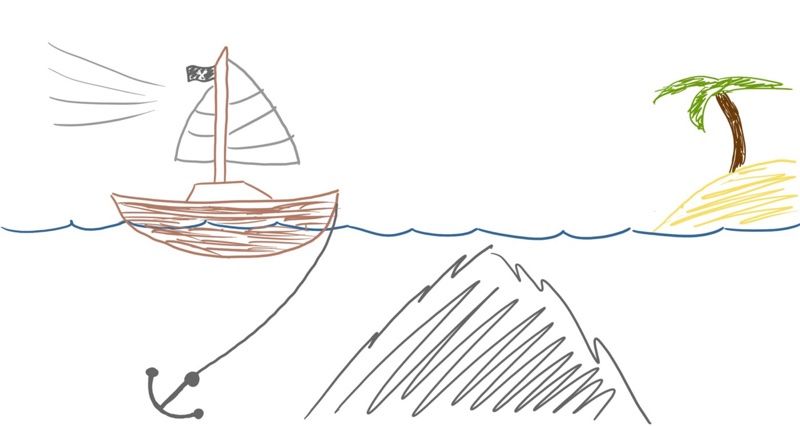
At its core, the Sailboat Exercise is a brainstorming process for garnering honest feedback from employees about the state of the team / product / company. As such, it can be used independently of team retreats. That said, I’ve found it particularly effective in such a setting because it’s a fun, low pressure exercise at a time when folks are in a mindset to candidly assess the state of things — i.e. they’re removed from the stresses of their normal day jobs, and able to come up for air to think more holistically.
In fact, I’ve found it to be such a good exercise for divining the zeitgeist of the team — what’s been good/bad/indifferent and where should we head next? — that I use it to kick off the retreat, with its outcome driving the topics to be discussed during the rest of the event.
In this way, it essentially becomes a tool for running a team retreat as an unconference (i.e. a participant-driven conference), but with enough structure in place to achieve the goals of 1) clear-eyed retrospection, and 2) forward-thinking planning.
For those wanting to try out the Sailboat Exercise, the steps are as follows:
- Draw the sailboat scene on a whiteboard (have some fun with it!), being sure to include the following visual elements: the wind in the boat’s sails, the anchor dragging behind it, the hidden rocks beneath the surface ahead, and the island beyond that.
- Ask the team to write as many ideas as they can possibly think of, 1 per sticky note, for each of the four groups, where:
- Wind = the things that are propelling the team forward (e.g. inherent team strengths, competitive advantages of what you’re building, solid processes, etc.)
- Anchor = the things that are slowing the team down (e.g. gaps in the team, competitive weaknesses, subject areas to invest in, etc.)
- Rocks = the things that aren’t currently being considered at the moment, but are risk points for the team going forward (e.g. areas of tension, bottlenecks around scaling, lurking competition, etc.)
- Island = the things that the team should be aspiring to (e.g. short term objectives, medium term goals, long term mission, etc.)
3. Let the team members independently brainstorm these ideas for 20–30 minutes, encouraging them to not overthink it. At the end of the brainstorming process, have them affix each sticky note to the whiteboard near its appropriate visual element. People are often inclined to avoid affixing a sticky note that duplicates one already on the board, but it’s important to help the group fight that urge since it’s actually quite useful to see which topics were brought up by multiple team members.
4. At this point, the facilitator’s job becomes to organize the stickies on the board so that similar ones are physically connected (see image below). This can be done with the full group’s participation, or with just 1 or 2 others while the rest of the group mingles. Either way, it’s useful for the facilitator to have at least some help in order to group these sticky notes together into thematic topics.
5. Once grouped, the facilitator asks each team member to assign a total of 5 votes to whichever topics that they personally would like the group to discuss while at the retreat. I’ve found that five votes seems to be the right number for most situations, and that the fastest way to enable the voting is to let each person write their own tally marks:
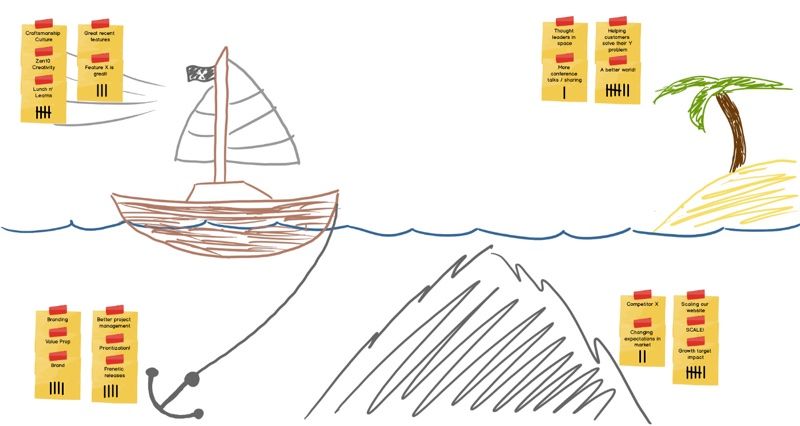
6. The most popular topics become the basis for the set of follow-up sessions during the rest of the retreat. The scheduling of which topics to discuss when can be outlined at this point, or left fluid as the retreat unfolds. As facilitator, your goal is to help the team cover as many of the highest ranked topics as possible while ensuring that the group is energized going into a given session at a particular time. If they don’t seem ready for a discussion because they need a break, some food, a lighter topic, etc. it’s best to delay or forgo the conversation rather than plow ahead.
7. Whenever possible, I look for others on the team to facilitate and/or drive the conversation during a particular session, only speaking up myself when necessary to move the discussion along, or to alleviate any buildup of tension.
8. At the end of our time together, we run a retrospective on the retreat as a whole — what did people like/dislike, and what might we do differently next time. This includes feedback on the Sailboat Exercise itself, as well as the topics that were brought up / discussed. As part of this retrospective, I make sure to thank everyone for their time, energy, and input. I also outline a few actionable steps we’ll be doing as we come out of the retreat because it’s important to a) ensure that team members have felt heard, and b) carry the positive momentum and energy from the event back into the workplace.
That’s it! The Sailboat Exercise has been a crucial tool in my manager tool belt largely because it’s simple to run and consistently produces great results.
I was recently asked by a fellow technologist what advice I had for creating a highly productive team. I said that, amidst a dizzying number of variables, the underlying foundation is almost always that each member of that team feels empowered — to share their opinions, to take on responsibilities, and to be a tangible part of contributing to something larger than themselves. It’s a cliched answer, of course, but as with most cliches, the devil is in the details; accomplishing this goal requires constant nurturing through thoughtful intent, communication, and processes.
In my experience, the Sailboat Exercise has been a great concrete tool for showing, not just telling, team members that they are central to the process of steering the ship.
* Note: I was introduced to this idea by friend and former colleague, Christopher Atkins . He had seen a few folks in the agile community using a version of it for sprint retrospectives, and we decided to experiment with the idea of leveraging it to run our next team retreat. It turned out to be a highly successful experiment, and I’ve since run the process numerous times / adapted it a bit as I’ve learned what works and what doesn’t. It’s worth noting that in doing research for this post, I discovered that the original inspiration for this type of process was a “Speed Boat Exercise” developed by Luke Hohmann .

The mosaic — how to build a healthy team
As many managers know, it’s damn hard to create and cultivate healthy teams.
Management Teams Visualizations Organizational Culture Leadership

Strategy via storytelling
So many strategy artifacts. So little clarity.
Leadership Storytelling Strategy Organizational Culture Product Management
- OC Wally Cento
- 84 Mini Maxi
- IMOCA Open 60
- Consultancy Services
- 30m Blue Water Cruiser
- 25m Explorer Yacht
- 24m Fast Cruising Catamaran
- 23m Performance Cruiser
- 20m Explorer Yacht
- 20m High Performance Cruiser
- 18m Blue Water Cruiser
- 15m Performance Cruiser
- 15m Explorer Yacht
- 12m Explorer Yacht
- Multihull Design
- 18m Explorer Yacht
- 40m Blue Water Cruiser
- 40m Cruiser Racer
- 33m Performance Cruiser
- 30m Wally Cento
- 24m ORCsy Racer Cruiser
- 24m Day Sailer
- Carbon Component Design
- Yacht Performance Development
- CFD and Model Testing
- Twin Rudder Steering Systems
- Custom Deck Hardware
- Modifications and Refit
- VPP Routing and Sail Analysis
- Classic Yacht Refit & Optimisation
- Naval Architecture
- Engineering
- Rudder Design
- Brokerage Services
- 'Seahorse Magazine' #192
- 'Divoc' #190
- Lucent #180
- Influence #171
- 'Eora' #169
- 'The Three Brothers' #168
- 'Edenred' #165
- 'BHB3' #163
- 'Teata' #148
- 'Kite' #144
- ‘Sensei’ #131
- 'Gryphon' #106
- 'Horizon' #104
- 'Sabre II' #93
- 'Letto Di Pletto' #47
- 'Mowgli' #41
- 'Graybeard' #39
- 23.8m Ultime Trimaran
- 20.7m Orma Trimaran
- 18.28m Orma Trimaran
- 16.75m Cruising Catamaran
- 16.1m Cruising Catamaran
- 12.8m Crowther Shockwave Catamaran
- 9.1m Seacart 30 Trimaran
- 26.3m Aluminium Sloop
- 21.0m Steel Schooner
- 21.0m Aluminium Cruising Ketch
- 20.0m Aluminium Explorer Yacht
- 20.0m Luca Brenta Racer Cruiser
- 19.6m Aluminium Bluewater Cruiser
- 19.2m Aluminium Lifting Keel Sloop
- 18.8m Custom Steel Sloop
- 16.0m Sly Cruiser Racer
- 14.5m Aluminium Cruising yacht
- 13.87m Wooden Motor Sailer
- 25.25m Reichel Pugh Maxi
- 18.28m IMOCA 60 Nexans WeWise
- 18.28m IMOCA 60 'Canada Ocean Racing'
- 18.28m IMOCA 60 Gentoo
- 18.28m IMOCA 60 One Planet
- 15.85m TP52 Georgia
- 15.84m TP52 Racing Yacht 'Alizee'
- 15.25m Pegasus Open 50
- 12.8m Fast 40
- 10.89m Figaro 3
- 10.11m Sun Fast 3300
- 19.2m Lifting Keel Sloop
- 14.5m Aluminium Cruising Yacht
| Owen Clarke Design, yacht designers and naval architects, exist to continually advance yacht design, fulfilling sailors' requirements for fast, beautiful sailboats. OC believe in innovative thinking and pushing technological frontiers achieving excellence in racing, cruising, and explorer yacht design. Sailing is our business and our passion. We are one of the world's leading companies of yacht designers and naval architects. OC specialise in custom sailing designs and naval architecture of racing boats and performance cruising, expedition and explorer yachts. Our studio has designed sailboats ranging from a 6.5m Mini Transat to a 76m superyacht, are specialists in the use of high-tech composite materials as well as experienced in more mainstream construction methods. Take your time to review the areas of our site that are relevant to you, after which we hope you’ll contact us at and/or: For an explanation of the technology behind the design process go to: For an insight into our engineering and detailed design work go to: |

The best 5 Design Thinking activities & tools for 2023

The design thinking methodology is participatory in nature, and it works best when harnessing a multitude of ideas and viewpoints. So if endless Zoom calls are sucking the creativity out of your team, it might be time to reinvigorate your remote design thinking workshops. We’ve curated a list of design thinking tools and activities you can use today to turbo-charge your sessions.
Best of all, with Conceptboard’s collaborative digital whiteboard , everyone can participate regardless of location. Simply jump onto a board and work together via live cursors, digital sticky notes, sketching tools, video conferencing and more.
These five tools are simple ways to implement the design thinking process within your team. So, instead of overthinking it, get started now and see what creative problems you can solve.
Design Thinking Tools and activities [2023 updated]
In each of the five frameworks below, the steps to design thinking are the same:
- Gather your team
- Send everyone a link to the board
- Invite everyone to share their ideas on the collaborative board using digital sticky-notes
- Reviewing what was shared and discuss
- Assign tasks and identify next steps
Tool 1: I Like, I Wish, What If
This design thinking tool is designed to collect actionable feedback quickly, easily. By encouraging participants to share their opinions in this fashion it flips negative criticism into positive constructive feedback.
Pull up this template at the end of a project, workshop, meeting or even marketing concept or design. Its simple design needs no explanation, so simply give team members 5-10 minutes to add up to five sticky-notes under each heading. Then, open the floor for discussion and reactions which may lead to new ideas or suggestions.
Depending on the purpose, you may then assign tasks for the group to implement themselves, or you may take the feedback on board for internal use.
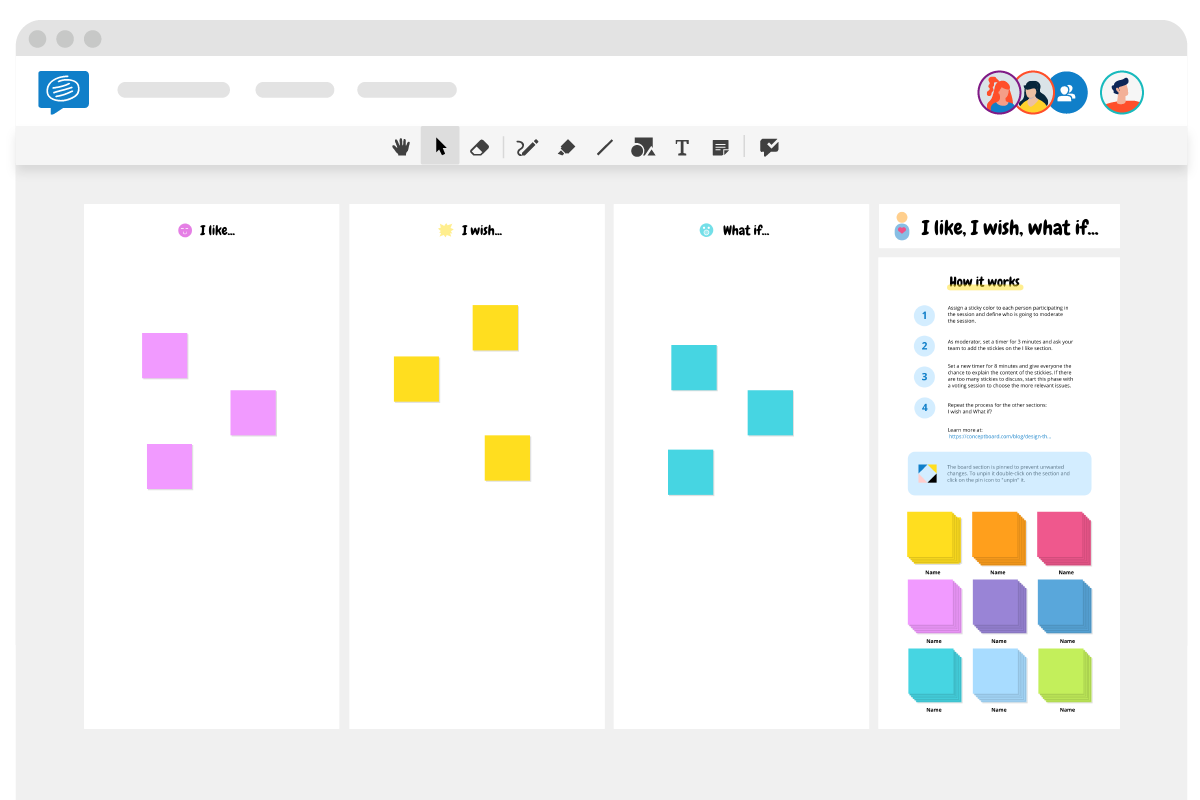
Use template
Tool 2: Rose, Thorn, Bud
Rose, thorn, bud is an extremely versatile design thinking tool. It’s designed to identify what’s working (Rose), what’s not (Thorn) and what can be improved (Bud) so it could be used by teams to self-reflect on current projects, day-in-a-life artifacts or overall processes. It should be able to help open up ideas for opportunities to create positive changes.

Start with the roses. The aim is to identify areas of excellence. You could ask questions such as:
- What was your highlight today?
- How have you been successful?
- What are you most proud of?
Move onto the thorns. Here we want to identify the challenges so we can work out how to overcome them. Ask your team:
- What was most stressful?
- What are the causes of these difficulties?
- What made it hard to be successful?
Lastly, let’s identify the buds. These are the areas of growth, the emerging possibilities and the future opportunities. Ask your team:
- What are you looking forward to?
- Describe opportunities for learning that excite you?
- What needs growth or nurturing?
Tool 3: What’s on your radar
In a standard brainstorming session , terrible ideas may overshadow the brilliant ideas placed next to them. The What’s on your radar template is designed to simultaneously collect lots of ideas and rank them in order of importance. Its circular dartboard design places the most important ideas at the center, with less important ideas relegated to the outer circles. The board is then divided into four conceptual quadrants, which can be labeled however you see fit.

This is a useful design thinking tool that also works as an icebreaker . Give everyone 10-15 minutes to add their ideas on Sticky notes to the board, then ask everyone to explain their idea and placement.
Tool 4: Mad, Glad, Sad retrospective
This is another reflective template tailor-made for design thinking. Instead of focusing on the physical accomplishments and roadblocks, it asks team members to reflect on their emotional responses. Often used at the end of a sprint, which can be an exhausting journey, it will help to understand the areas that are critical to team morale.
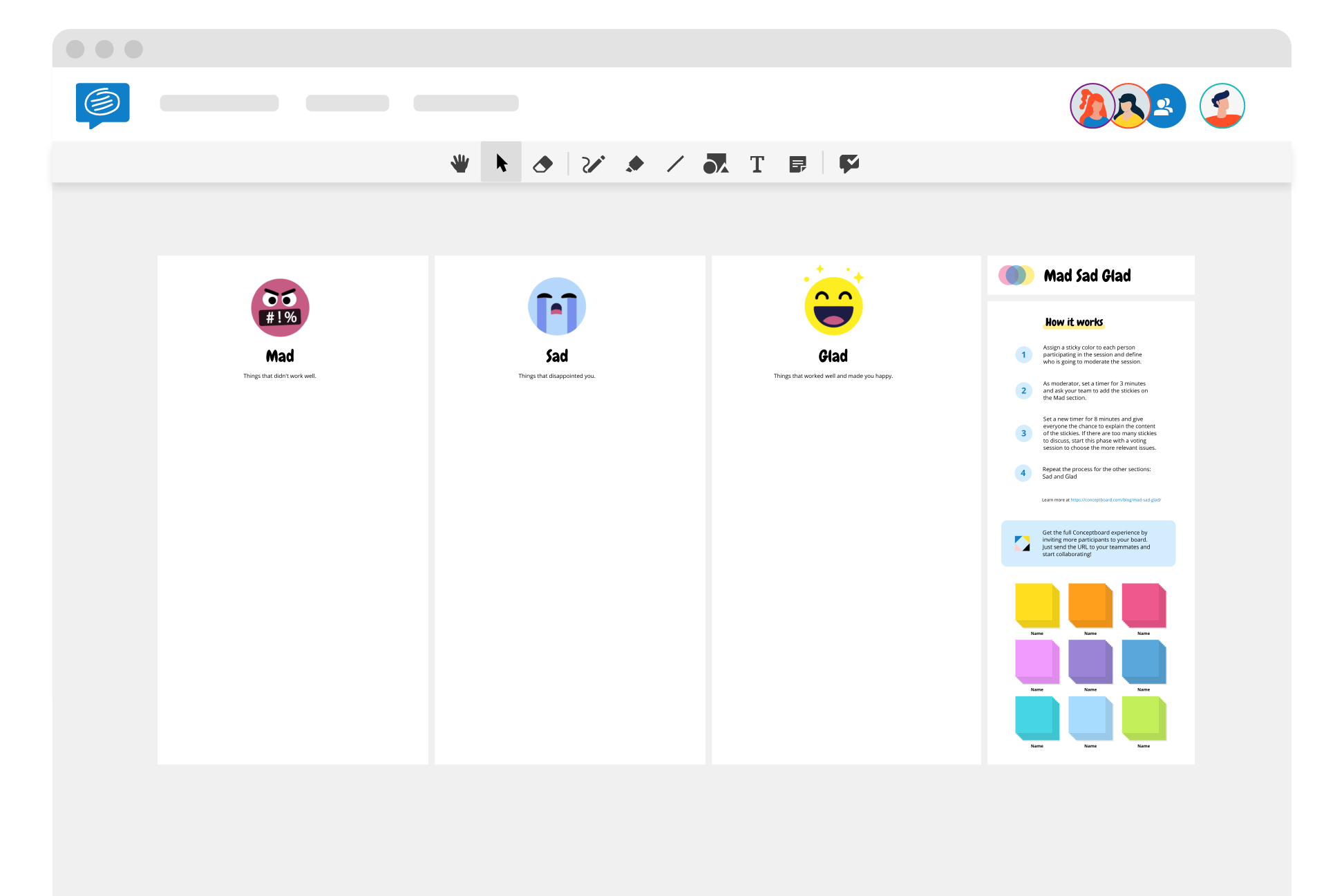
The first step is to give everyone time to truly reflect on their individual emotions throughout the sprint without the influence of others. Give everyone 30-60 minutes to privately compile, then ask them to share them on a collaborative board.
Mad – List the things that are driving you crazy. What is stopping you from performing at your best?
Sad – What are some of the things that have disappointed you or that you wished could be improved?
Glad – What makes you happy when you think about this project? What are the elements that you enjoy the most?
This activity encourages people to be vulnerable, so make sure you create a trusting and open space where everyone feels comfortable sharing their feelings. Ensure there’s a no-blame rule and understand that while each problem may not be able to be immediately fixed, this tool can help open up the dialogue.
Tool 5: Sailboat retrospective
The fifth tool in our beginner’s design thinking toolkit is the sailboat retrospective. Designed to help teams (the sailboat) navigate to where they want to go (the goal); it helps identify risks along the way that may be hindering progress (Anchors) and what is helping them move forward (Winds).

The first step is to agree on the goal that you are trying to reach, then add that to the board. Then ask your team to individually brainstorm their thoughts and add them to the board under each category:
- The wind blowing the sail that represents the strengths of the team
- The island or shore that represents goals or visions of the team
- The anchor represents the things that are holding the team back or delaying progress (areas of weakness, silos, etc.)
Once the board is full, begin discussing as a team which ideas are most important and how identified risks can be mitigated. If your team uses agile principles in addition to design thinking, you could also refer to our agile retrospective templates .
So as you can see design thinking is easy to implement and can be applied to a range of situations that require problem-solving. With Conceptboard’s digital whiteboard all these exercises can be completed by collocated or remote teams with ease, and all information will be stored securely in your account for later use.
If you want to see other ways Conceptboard can help your team embrace design thinking, read our other articles about how to Transform your remote Design Thinking sessions , The best Visual Thinking Strategies for 2023 and a guide to low-fidelity prototyping .
More interesting articles for you

OZG 2.0: The future of digital administration in Germany is FIM
Since its introduction in 2017, the Online Access Act (OZG) has aimed to make it easier for citizens and companies to access administrative services and make them available digitally.

Unwrap the Joy: Elevate Your Team’s Holiday Spirit with Our Exclusive Christmas Game Template!
The holiday season is upon us, and at Conceptboard, we’re thrilled to unwrap the gift of festive cheer with our special Christmas Game Template!

Wireframe Template – A structure to build something great | Free Template
By using Wireframe Templates, you can streamline your workflow and ensure a more efficient and effective design process.
1 Comment . Leave new
Wow, thank you so much for all these great articles on creative processes and tools, Kat, very well done!
Leave a Reply Cancel reply
Your email address will not be published. Required fields are marked *
Post Comment
Experience the power of visual collaboration
Experience how Conceptboard boosts your team’s hybrid collaboration and communication.
No credit card
No commitments
Start right now

COMMENTS
What is a sailboat retrospective and how can it help you and your agile team conduct better sprint reviews? Here's what you need to know about this technique.
The sailboat retrospective is a fun retrospective technique for sprint & project retrospectives. Use our collaborative template for free and make your presentations more interactive.
INTRODUCTION TO SAILBOAT DESIGN: A TECHNICAL EXPLORATION Sailboat design is a complex and fascinating field that blends engineering, hydrodynamics, and aesthetics to create vessels that harness the power of the wind for propulsion. In this highly technical article, we will delve into the key aspects of sailboat design, from methodology to evaluation.
The Sailboat Retrospective is a technique that will help your team easily visualize a sprint's obstacles, risks, and ultimate goals. Here's how to run one.
Ever wondered about the thinking behind sailboat design? There is rather more to it than you might have imagined, and the basics are explained here
The 'Sailboat' is a design thinking activity aimed to improve ourselves or the procedure after every iteration. This activity is ideal for a group of 3-8 core design cohort team members and takes around 60-120 minutes.
This post explains how to use the SailBoat Retrospective or sometimes called Sailboat Exercise. This technique is extremely simple but powerful.
We have previously discussed both form stability and ballast stability as concepts, and these certainly are useful when thinking about sailboat design in the abstract. They are less useful, however, when you are trying to evaluate individual boats that you might be interested in actually buying. Certainly you can look at any given boat, ponder its shape, beam, draft, and ballast, and make an ...
Agile Coach Indeep Kaur shares her tips and four-step process on how to use the Sailboat Retrospective to help teams be successful. Read on learn more about how you can do it, too!
The Sailboat Retrospective (also known as the Sailboat Agile Exercise) is a low-pressure way for teams to reflect on how they handled a project. Originally based on the Speedboat retrospective by Luke Hohmann, the exercise centers around a sailboat as a metaphor for the overall project, with various elements broken down: Rocks - represent risks ...
Retrospectives 102: The Sailboat Method. Summary: After each sprint, the team should have a retrospective session to identify what went well or not so well. The sailboat metaphor is a nice way to structure such retrospectives. Retrospectives allow design teams to reflect on their work process and discuss what went well and what needs to be ...
Speed Boat is a design thinking activity to help frame obstacles holding back your project's success. Inject a bit of fun into your process!
The Sailboat Retrospective is a fun and creative way for teams to reflect on the sprint and identify areas for improvement. It's called "Sailboat" because the metaphor of a sailboat helps the team visualize their journey, the obstacles they faced, and the direction they want to sail towards in the future. The Sailboat or Speedboat Method for Sprint Retrospectives is an easy way to: adopt ...
You know the old saying, "The more things change, the more they stay the same"? As a judge for the 2020 Boat of the Year (BOTY) competition at this past fall's US Sailboat Show in Annapolis, Maryland, I helped inspect and test-sail 22 brand-new current-model sailboats. And I came away thinking, Man, these aren't the boats I grew up on. In the case of new boats, the saying is wrong ...
Basics of Hull Design When you think about a sailboat hull and how it is built, you might start thinking about the shape of a keel. This has certainly spurred a lot of different designs over the years, but the hull of a sailboat today is designed almost independently of the keel.
The Sailboat in action at a KOMODO Innovation Workshop. Once your team have created their answers as Sticky Notes, ask them to stick them to a graphic you've drawn or printed that includes the following elements: A boat - this is your team/project. An island - this is the goal you're working towards. It can be the specific features designed ...
Sailboat Retrospective It is one of the alternative retrospective tools you can use instead of Rose, Bud, and Thorn. The sailboat retrospective is a design thinking toolkit used by thinking designers. Like the rose, bud, and thorn, it also has a sailboat, anchors, and winds.
Sailboat Canvas. This canvas was inspired by a tool described in Alex Osterwalder's Value Proposition Design book. We've had amazing success deploying this to teams in order to develop a strong foundation for strategic planning. It's a really simple and versatile tool which allows you to clearly display the forces that are acting on you ...
To highlight how these boat design principles play out, Practical Sailor looks at classic sailboats such as the Bill Shaw-designed Pearson 32, Ericson 41, Valiant 40, and Peterson 44, and compares their keel/sail ratios and lead values to more modern sailboat designs such as the Catalina, Hunter, Tartan, and Beneteau. ****.
The Sailboat Exercise is an interactive brainstorming process (and neat visual tool) for garnering honest feedback from employees about the state of the team / product / company during team retreats.
Welcome Owen Clarke Design, yacht designers and naval architects, exist to continually advance yacht design, fulfilling sailors' requirements for fast, beautiful sailboats. OC believe in innovative thinking and pushing technological frontiers achieving excellence in racing, cruising, and explorer yacht design. Sailing is our business and our passion.
The best 5 Design Thinking activities & tools for 2023 The design thinking methodology is participatory in nature, and it works best when harnessing a multitude of ideas and viewpoints. So if endless Zoom calls are sucking the creativity out of your team, it might be time to reinvigorate your remote design thinking workshops. We've curated a list of design thinking tools and activities you ...